Being liberated from the shackles of commercial enterprise is one of the great joys of compiling this website. It means that every page can be developed in a free-'n'-easy fashion without buckling under a
 mountainous debt burden...and, of course, this is all down to the generous help of contributors, without whom it would not have been possible.
mountainous debt burden...and, of course, this is all down to the generous help of contributors, without whom it would not have been possible. For example, all the railway photos on this page were taken by the late Paul Claxton. They are reproduced here courtesy of Mike Claxton, proprietor of www.railpictorial.com. This is a superb site created by Mike in memory of
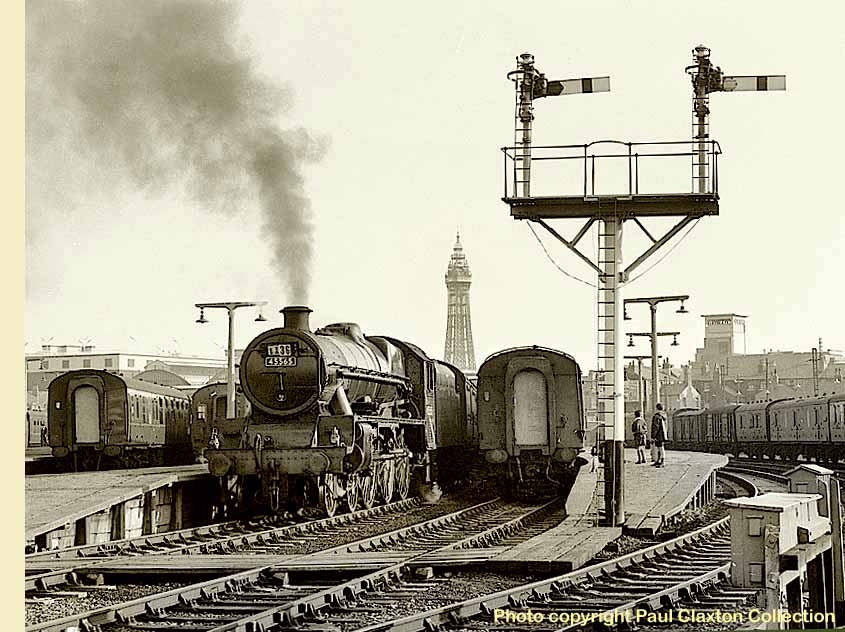 his younger brother Paul, who sadly passed away in April, 2009.
his younger brother Paul, who sadly passed away in April, 2009. Paul was born in 1946 - a post-war baby boomer no less - who began train spotting at a very early age, and like most young boys during the late 1950s he started taking railway photographs, a natural adjunct to train spotting.
Paul's first camera was a Kodak Brownie 127, but this was quickly replaced by a Zeiss Ikon Nettar 120 rollfilm camera followed by a Kodak Retinette 1B 35mm camera in 1961. Four years later Paul acquired a Pentax S1A and by the late 1970s he graduated to a Nikon F 35mm and a Pentax 6X7, albeit too late for BR mainline steam, but ideal for recording preserved railways and steam specials on the main line. I'm sure Paul's photos will connect with everyone and a visit here to Mike's site is highly recommended.
(Above Right) It seems fitting to start and finish this page at Blackpool since the Fylde coast was very much Paul's home ground and he made frequent reconnaissances with a camera there during the 1960s. Living in Lytham St Anne's, he was able to photograph the influx of steam-hauled specials to Lancashire's premier holiday resort during the seasonal 'Wakes Weeks'. Here 'Jubilee' class No 45565
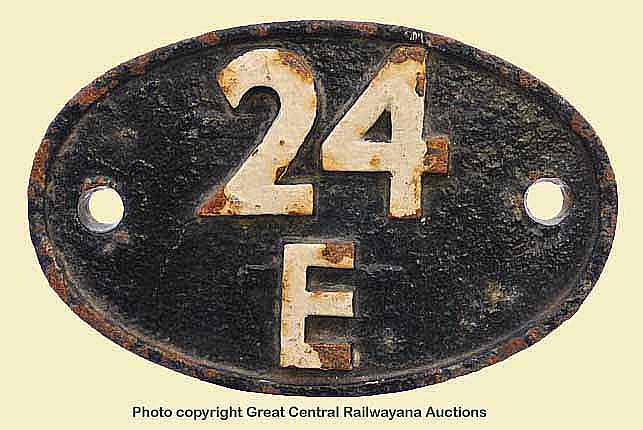 Victoria brews up in readiness to depart from Blackpool South on 31st May 1966.
Victoria brews up in readiness to depart from Blackpool South on 31st May 1966. (Left) This Blackpool shedplate recently went under the hammer at a Great Central Railwayana Auction. Blackpool depot was coded 24E from 1935 to 1950 and between May 1952 to September 1963. The shed had 60 locos in LMS days and towards the end of the 1950s had 40 on its books, most notably six Jubilees. The shed closed in November 1964 as 10B.
(Below) Paul was a regular visitor to the shed during the 1960s, indeed usually to be found cleaning one or other of the resident 'Jubilee' 4-6-0s or perhaps one of the visiting engines from other Regions. Sporting a 24E shedplate on the smokebox door, 'Jubilee' class No 45571 South Africa was photographed at Blackpool South on 20 February 1963
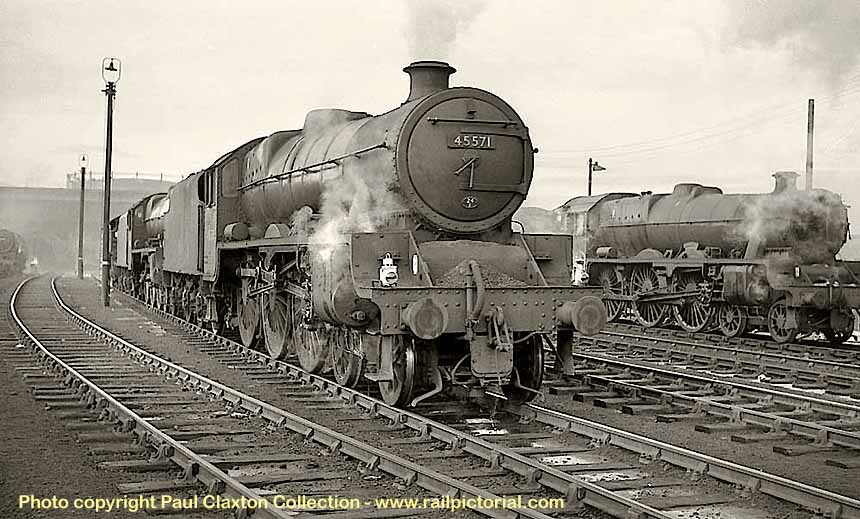

(Above) Paul captures a busy scene at Blackpool shed...date etc
Mention of the transition from steam is still liable to evoke strong emotions from a faithful band of enthusiasts, who remain unconvinced that steam had outlived its usefulness. At the time, BR was accused of placing too much emphasis on the procurement of diesels, and too little attention on providing adequate maintenance facilities. Not surprisingly a high incidence of diesel breakdowns occurred, and when it did, steam was usually called upon to save the day - a point immediately seized upon by the die-hards of the steam faith.
Mike writes in the introduction on his site about how Paul became part of a campaign established to ensure that the demise of steam might be remembered not merely as a depressing era set against a background of neglect and decay, but more so as a period when its departure was permitted to occur with at least an element of dignity.
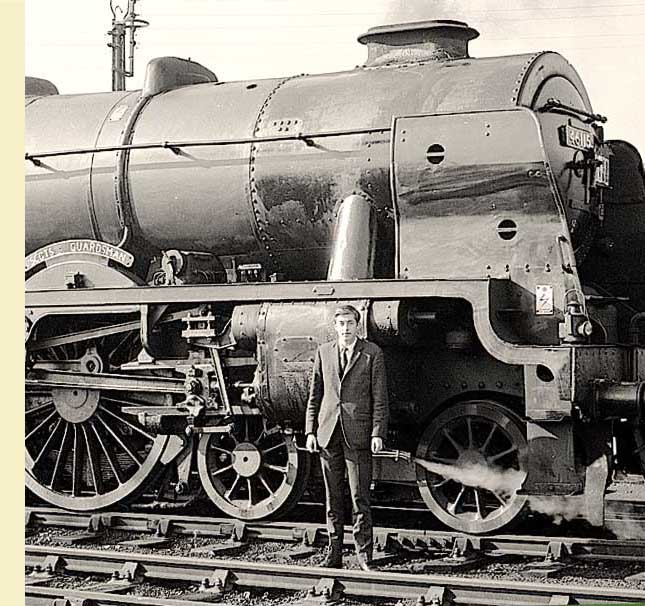 During this period Paul and his friends: Alan Castle, Ken Hale, Mick York, Ian Robb and Bob Clarke, made frequent visits to Lostock Hall, Rose Grove and Carnforth in order to clean BR's very last steam engines in service.
During this period Paul and his friends: Alan Castle, Ken Hale, Mick York, Ian Robb and Bob Clarke, made frequent visits to Lostock Hall, Rose Grove and Carnforth in order to clean BR's very last steam engines in service. Mention should also be made of Peter Fitton, a very close friend of Paul's right from school days. Peter was also part of the loco cleaning crew and the pair of them made hundreds of trips together in their pursuit of steam. Peter, together with Mike, was a trustee to Paul's will, which clearly shows the degree of closeness between them.
This shot (right) shows Paul standing alongside a 'spruced-up' Royal Scot No 46115 Scots Guardsman at Blackpool North on 26 September 1965.
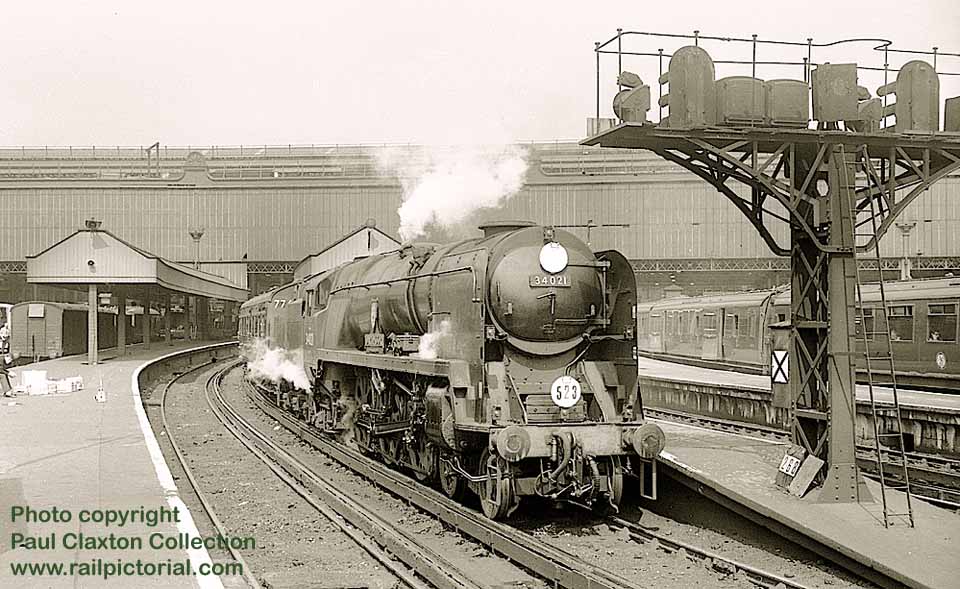
(Above) Paul photographed Rebuilt 'West Country' Class 34021 Dartmoor preparing to leave No 10 platform at Waterloo with a passenger service for Salisbury on 23 August 1962. Rebuilt at Eastleigh in 1957, 34021 was eventually allocated to Nine Elms MPD. She was withdrawn from service at the end of steam on the Southern in July 1967.
At the start of the Sixties BR's steam fleet looked in reasonably good health with over 14,000 engines operating on the books; in 1960 the Bulleid Pacifics were being extensively rebuilt, BR's new Standard Class 9F were still rolling off the production line and the steaming efficiency of Gresley's Class A3 was being enhanced - though not in the good-looks department - with the fitting of German trough-style smoke deflectors. All in all, the decade ahead looked a rosy prospect for spotters; certainly there was little to suggest that in a matter of a few years BR's old-fashioned steam fleet would very quickly fall from grace. In 1960 the new diesel fleet was still relatively thin on the ground, although the new diesel multiple units - Met Camm; Cravens; Swindon and Derby-built vehicles etc - were making major inroads on country branch line and suburban services. By the late Sixties, however, enthusiasts were dashing around the country in a bid to photograph BR's rapidly declining rank and file of steam classes before they disappeared completely. Paul was among the early contenders. For the record, 1962 saw the withdrawal of the entire SR 'Lord Nelson' 4-6-0s, 'N' class 4-6-0s and 'Schools' class 4-4-0s; in that same year BR's second-generation diesels: Brush Type 4 Co-Co (Class 47) and Clayton Type 1 Bo-Bo entered traffic, and on the Southern Region the Class 73/1 and 73/2 Bo-Bo electro-diesels and SR Oxted DEMUs made their first appearance.
(Below) 'Lord Nelson' class No Class 30861 Lord Anson gathers speed on the down main through Vauxhall after leaving Waterloo with a passenger service bound for Bournemouth on 23 August 1962.
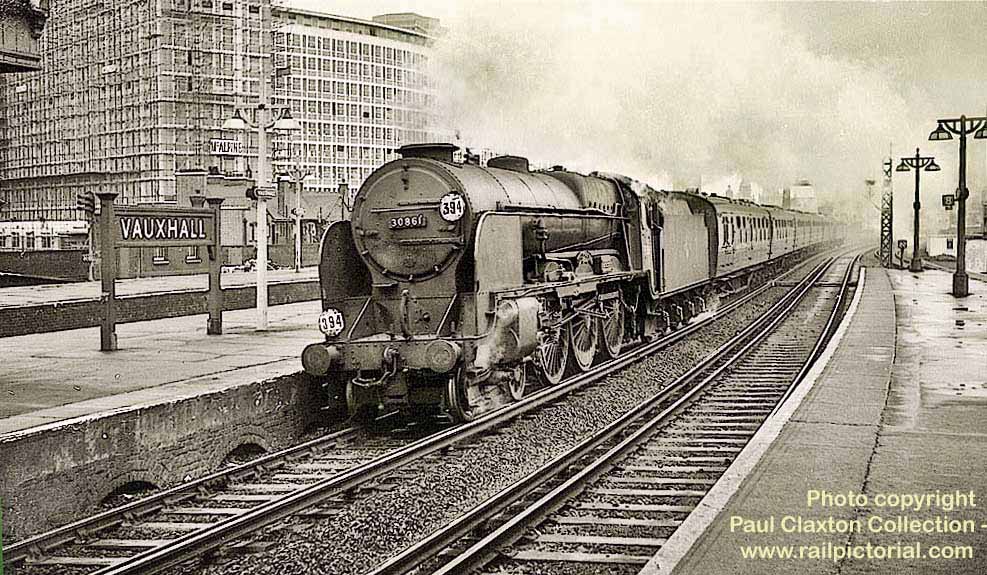
WWW.RAILPICTORIAL.COM
To give credit where it is due, 74 year-old Mike has pulled out all the stops to create this website for the simple reason that it gives enthusiasts a chance to enjoy his late brother's photo collection. And what a collection it is!
Rarely have I see such quality and in such high numbers on one website - 7,400 images and counting! - incredible!
When I first saw Paul's images online, I must admit to feeling the teensiest bit envious; not only do they revive so many fond memories of steam days, it reminds me of my own photographic output all those years ago. Alas, the bulk of my 35mm negatives and colour slides went up in smoke during the 1980s...a long story, which I tell on another page.
I only mention it here because it explains why enthusiasts such as myself can 'connect' with Paul's photos, though I'm not quite sure how to express my feelings in plain words without sounding mushy. How do you describe the empathy that railway photographer's have for one another's work? It's like discovering a new author with a best-selling book, or a song that holds an
 everlasting resonance, or a new film that you desperately want others to see. Or perhaps it can be described as a subliminal thing; a tacit understanding that only photographers share. Paul's consistently high standards are quite remarkable, which is why I regard him as one of the elite among railway photographers. And this is why Mike's website is praiseworthy. Had it not been for his decision to share Paul's work online, we would never have chance to savour it.
everlasting resonance, or a new film that you desperately want others to see. Or perhaps it can be described as a subliminal thing; a tacit understanding that only photographers share. Paul's consistently high standards are quite remarkable, which is why I regard him as one of the elite among railway photographers. And this is why Mike's website is praiseworthy. Had it not been for his decision to share Paul's work online, we would never have chance to savour it. Needless to say, all the photographs reproduced on this page are low-res images, however Mike does have much larger 4800dpi scans of all photos. You can contact him with your requirements via the email address on his site, or at the bottom of this page.
(Below) 'Jubilee' No 45647 Sturdee head the 1X16 Leeds-Blackburn at Mytholmroyd on 19th March 1966.


(Above) A powerful study of Class A4 60024 Kingfisher heading a Carlisle-Edinburgh express at Carlisle Canal Junction on 23 February 1962
(Inset) Since I never actually had chance to meet Paul, the only way I
 can get a measure of him as a person is by his superb photographs, however there is a beautifully-written obituary in memory of Paul by his close friend, Alan Castle, who conveys much more, particularly about Paul's enthusiam for steam and that too of an all-round decent bloke. Alan's tribute can be found on the excellent Lostock Hall MPD website here.
can get a measure of him as a person is by his superb photographs, however there is a beautifully-written obituary in memory of Paul by his close friend, Alan Castle, who conveys much more, particularly about Paul's enthusiam for steam and that too of an all-round decent bloke. Alan's tribute can be found on the excellent Lostock Hall MPD website here. Needless to say, sorting through such a large collection of photos is no easy task, therefore Mike has wisely set himself a number of targets, starting off by scanning and uploading the images, followed by captioning them and checking for errors - plus he has to finish off scanning and uploading the remaining negatives in due course. In view of the sheer size of the task, the only way he can make headway is by ignoring any thought of correcting the images, working on the assumption that should anyone require a hi-res image then they get them 'as is' and make corrections to their own taste.
Even so, close inspection of the site reveals page after page of 'master shots'; the sort of images I wish I had taken myself, but for one reason or another I fell a long way short of achieving Paul's high standards.
This can be attributed to several factors; being in possession of an affordable quality camera is the most obvious excuse, and getting a fair share of the right breaks another.
This is utter baloney, of course. Railway photography requires more than just good luck; it calls for a level of dedication, obligation and staying power that many youngsters were unable to commit themselves to during the bawdy 'Swinging Sixties'.
Oh dear, what can one say about the follies of youth that hasn't been said before?
On the one hand, it's easy to see why teenagers were seduced by the Sixties. For having spent the best
 part of our spotting days being pushed to the edge of reason by BR's headlong rush into getting rid of its old-fashioned steam fleet, we were longing for something to feel cheerful about. The prospect of watching the rank and file of steam locos - already dirty, uncared for and teetering on the brink of annihilation - was just too much to bear.
part of our spotting days being pushed to the edge of reason by BR's headlong rush into getting rid of its old-fashioned steam fleet, we were longing for something to feel cheerful about. The prospect of watching the rank and file of steam locos - already dirty, uncared for and teetering on the brink of annihilation - was just too much to bear. Worse still, the timing of our adolescence was all wrong. All at once a generation of hormonally unhinged post-war baby boomers was about to come of age; they began to display erratic mood swings, from temper tantrums to sulky silences, which confirms the hypothesis that we are all descended from apes. In between 'zapping' spots out of chins and deciding whether to 'wet' shave or use a Remington, teenage boys were suddenly reawakened by a brand new pop culture that shone like a beacon out of the gloom. It was called the 'Mersey Sound' which promised a wonderful new beginning and for the first time since puberty everything started to make sense.
I'm talking here about a decade that offered so many rude awakenings that many youngsters lost interest in trains and railways, often without any resistance at all, which, with hindsight was a crying shame...and I do wonder how many kindred spirits now kick themselves for abandoning the hobby when they did...
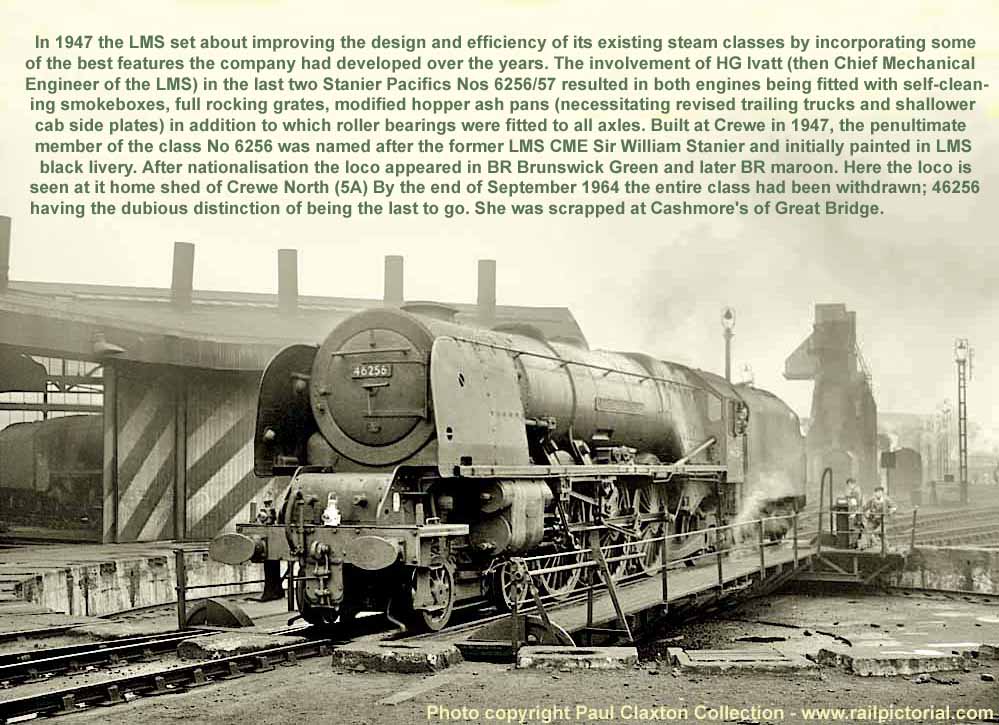
LOCATION, LOCATION, LOCATION!
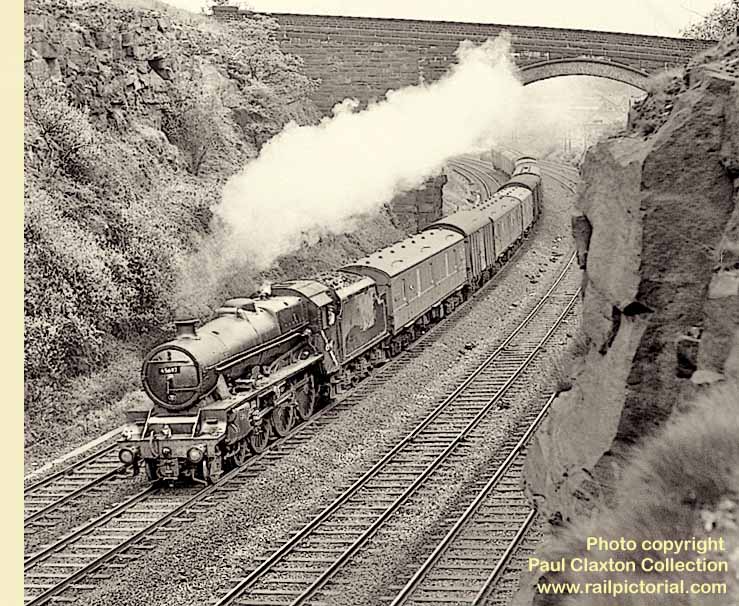 (Right) 'Jubilee class No 45697 Achilles heads a Leeds-Heysham parcels through Newlay Cutting on the outskirts of Leeds on date....
(Right) 'Jubilee class No 45697 Achilles heads a Leeds-Heysham parcels through Newlay Cutting on the outskirts of Leeds on date....This photo (right) made me sit up! Back in steam days, I could kick myself for visiting the same locations over and over again, but I couldn't resist the places I discovered during childhood spotting days in the Aire Valley between Leeds and Shipley; all within easy reach from home, the nearest being just a five minute cycle ride away.
So when my interest in railway photography began in earnest in 1959 I stuck doggedly to a familiar routine, pedalling like fury up and down the towpath on the Leeds-Liverpool canal in the hope of taking that all-illusive master shot on the Aire Valley line between Kirkstall and Apperley Bridge.
Can you imagine my surprise then - when out of the blue - up pops Paul with a shot taken at exactly the same place I had all those years ago! Well, ten-out-of-ten to him, I say...though I must confess, had I spotted Paul - or any other railway photographer for that matter - stalking trains on 'my patch' back in the
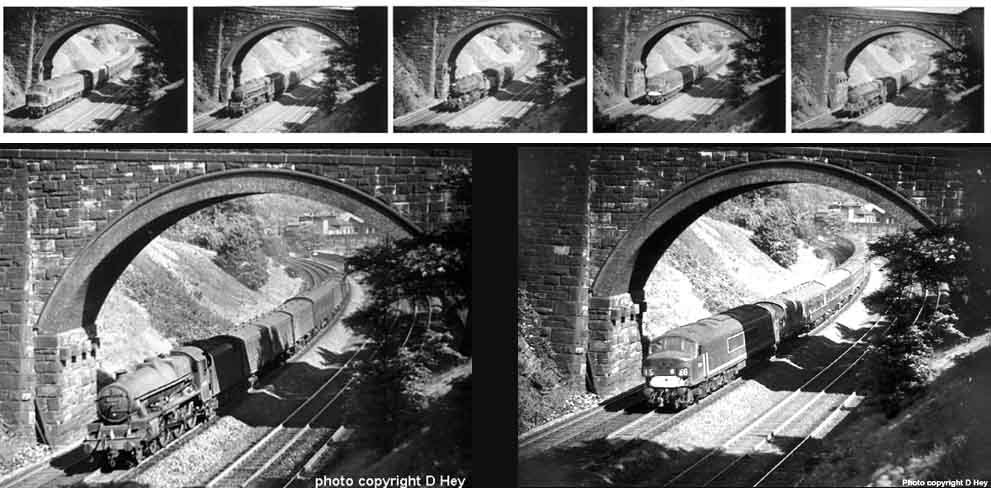 1960s I would have regarded it as gatecrashing! This was one of the foibles of railway photography in steam days; it was the assumption that one had exclusive territorial rights to a stretch of line and claimed it as one's own. I had no rights whatsoever of course...I simply got there first...in other words, you're too late, mate - I was here before you. Go and find your own!
1960s I would have regarded it as gatecrashing! This was one of the foibles of railway photography in steam days; it was the assumption that one had exclusive territorial rights to a stretch of line and claimed it as one's own. I had no rights whatsoever of course...I simply got there first...in other words, you're too late, mate - I was here before you. Go and find your own! Odd then, how the passing of years has mellowed this once-stroppy teenager (self-appointed guardianof photo locations) into forgiving Paul for his shot of 45697 Achilles heading through Newlay Cutting. It confirms that my choice of location (left) must have suited him too. He rattled off several shots here. However, this thinly-veiled protection racket was not an isolated case. I've heard of it happening elsewhere; more often than not in some rural backwater of the railway network known only to a local enthusiast rather than say at such places as Crewe, York or Doncaster, which were frequented by thousands of devotees with cameras.
(Below) Here Paul captures the departure of 'Princess Royal' class 46207 Princess Arthur of Connaught with a northbound express at Crewe on 7 August 1961. By this time, the first stage of WCML electrification between Crewe and Manchester had been been energised on 12th September 1960.
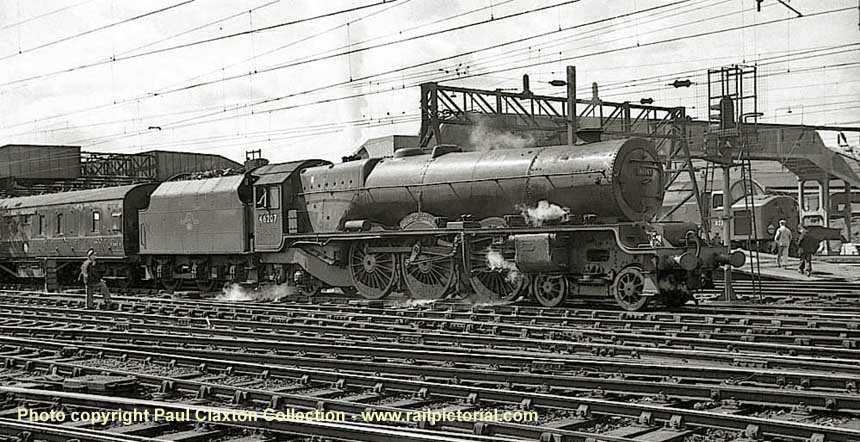
FISHING vs SPOTTING
These rarely told stories of lineside reconnaissances with a camera takes me back to schoolday rivalries me back to schoolday rivalries which no longer exist today. For example, the Leeds-Liverpool Canal I mention above not only provided a vital transport link for the Aire Valley woollen mills, it was a popular venue for fishermen too. In fact, fishing
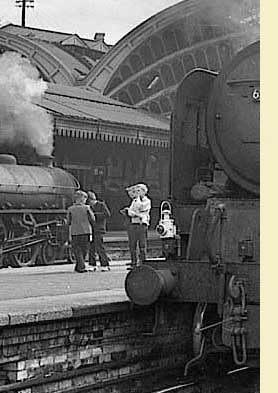 was one of the biggest outdoor pursuits for boys during the Fifties and Sixties - and still is, come to that. Alas the same can't be said for train spotting which I fear is regarded as 'uncool' by today's youngsters, though the interest in railway photography remains strong.
was one of the biggest outdoor pursuits for boys during the Fifties and Sixties - and still is, come to that. Alas the same can't be said for train spotting which I fear is regarded as 'uncool' by today's youngsters, though the interest in railway photography remains strong. Well, not wishing to incur the wrath of anglers, I never saw the point of sitting on canal banks for umpteen hours on end. It was hardly what I'd call 'firing on all cylinders'.
Whatever incentive drove my angling-mad schoolmates to fish their local stretch of Leeds-Liverpool canal between Kirkstall and Rodley didn't 'grab'
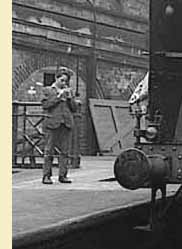 me at all. On the other hand, my schoolmates thought my compulsion for collecting engine numbers in a red exercise book was even dafter, which somehow evened the score!
me at all. On the other hand, my schoolmates thought my compulsion for collecting engine numbers in a red exercise book was even dafter, which somehow evened the score! Still it didn't matter which you preferred since both groups had a lot in common. We were both driven by the same Zion-style love of the great outdoors and being close to nature, we spent long periods of suspenseful waiting time followed by high-octane excitement at the chance of catching a 'bite' or bagging a prized 'cop' - and after spending a long day outdoors in all weathers we returned home looking like something the cat had dragged in!
The only difference between us, if I have to find one, is that by the very nature of the
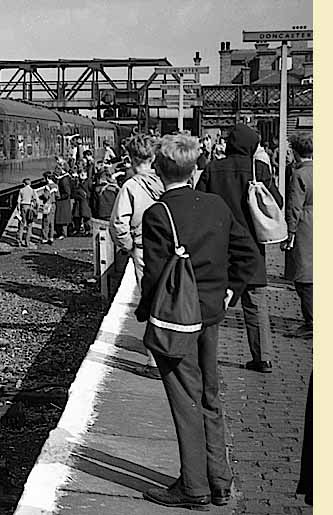 sport, anglers tended to be loners, and if they were fishing in a competition it wasn't enough that they succeeded; others had to fail. Train spotting was a much more friendly pursuit in my view since we weren't in competition with one another; we were simply collecting numbers for ourselves and logging them in our Ian Allan abc spotting books.
sport, anglers tended to be loners, and if they were fishing in a competition it wasn't enough that they succeeded; others had to fail. Train spotting was a much more friendly pursuit in my view since we weren't in competition with one another; we were simply collecting numbers for ourselves and logging them in our Ian Allan abc spotting books. However, the big change came when we started taking railway photograph; indeed the key to becoming a successful cameraman required a great deal more than jotting down numbers; it meant learning new skills and being able to recognise what constitutes a great picture, for make no mistake railway photography is an art form - and choosing the right location is an essential part of it.
This reminds me of a chapter in a lovely book 'Portraits of Steam', published by OPC in 2000; it features the superb railway photographs and paintings of George F Heiron. The narrative in the book is written by Michael Harris, and the short piece I am referring happened in 1954 when Ian Allan organised a railtour from Waterloo to Bournemouth, then onwards via the Somerset & Dorset Joint Line to Bath GreenPark, where a pair of LMS Standard 2P 4-4-0s were used on the heavily-
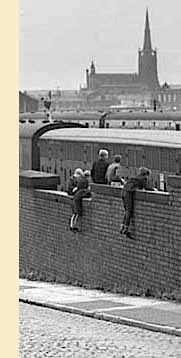 graded Bath to Templecombe section.
graded Bath to Templecombe section. George states - 'I remember that day well. Ivo Peters (a well-known railway photographer of the 1950s and 1960s) was there with his Bentley car. I had cycled there and I was just in my shorts. He wouldn't speak to me as I waited to get my shot. We both photographed the special train with the 2Ps - and it was mine that was published in Trains Illustrated'.
Whoa George! There's no mistaking what happened here...you misinterpreted his apparent aloofness as snobbery. It wasn't! I suspect Ivo Peters regarded you as an intruder; you were encroaching on his turf! This possessive nature is inherent in us all. Even the most mild-mannered of men suffers from the most basic animal instinct; dogs cock a leg and mark their territory, men cock a snook at one another.
As it turned out, George Heiron's photo of the 2Ps emerging from Bath's Devonshire Tunnel did appear in the June 1954 issue of 'Trains Illustrated', so I guess that made it alright in the end, though I doubt if Mister Peters would have agreed...
(Below) Class 8F No 48207 heads an 'up' freight at Farington Curve Junction on 10 May 1965.

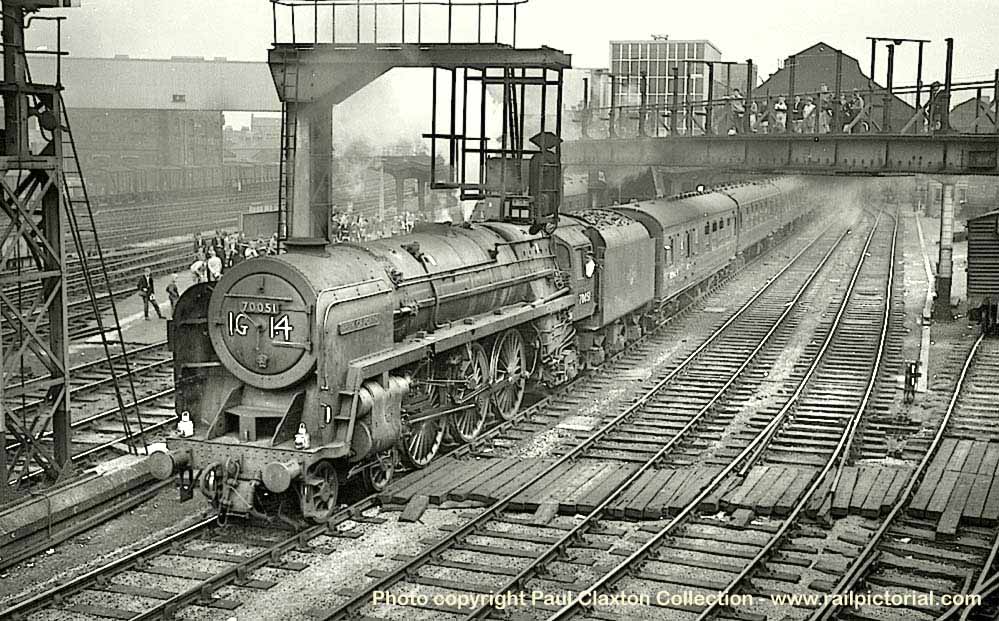
(Above) Spotters to the left, spotters to the right...this is the south end of Preston....Paul has filled the image with intentional interest, as Britannia 70051 Firth of Forth draws forward with the IG 14 Workington to Birmingham on 30 July 1963. The young train spotters are all 'baby boomers', and since train spotting was then the national hobby, the local station was the only place to go on a summer
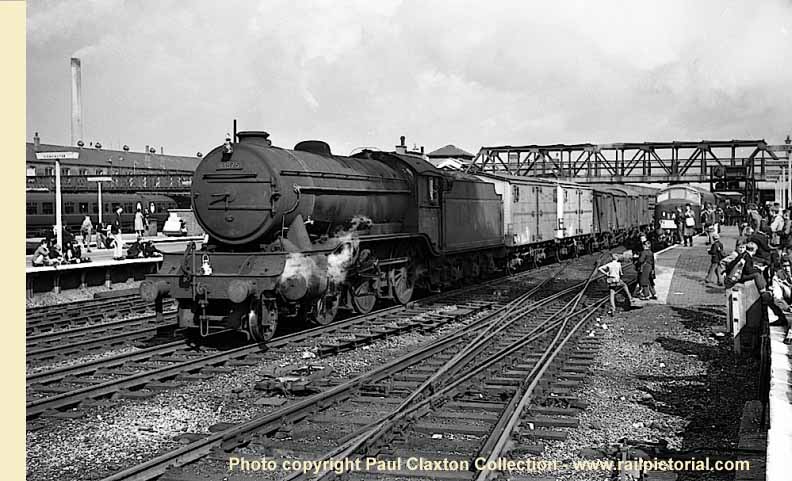 Saturday afternoon; so notebooks in hands and pencils poised they eagerly await the next engine to appear and the chance to add another 'cop' to their collection of numbers.
Saturday afternoon; so notebooks in hands and pencils poised they eagerly await the next engine to appear and the chance to add another 'cop' to their collection of numbers.(Right) Across on the East Coast Main Line, this shot of Class K3/3 No 61875 heading a southbound mixed freight rekindles many fond memories of spotting days at Doncaster...perhaps you might recognise yourself amongst this crowd of spotters at the south end of the station on 8 September 1962. With hindsight, spotters often overstepped the mark by encroaching too close to the trackside at the end of main line platforms. However it wasn't a case of downright bad behaviour, just boys being boys - nevertheless the carefree abandon shown by the lads in this shot smacks of a Health & Safety executive's nightmare! You will find more of Paul's photos of Doncaster here on Page 7.
(Below) A group of young spotters watch the stately departure of Class V2 No 60828 from York with the down 'Scarborough Flyer' on 10th August 1963.
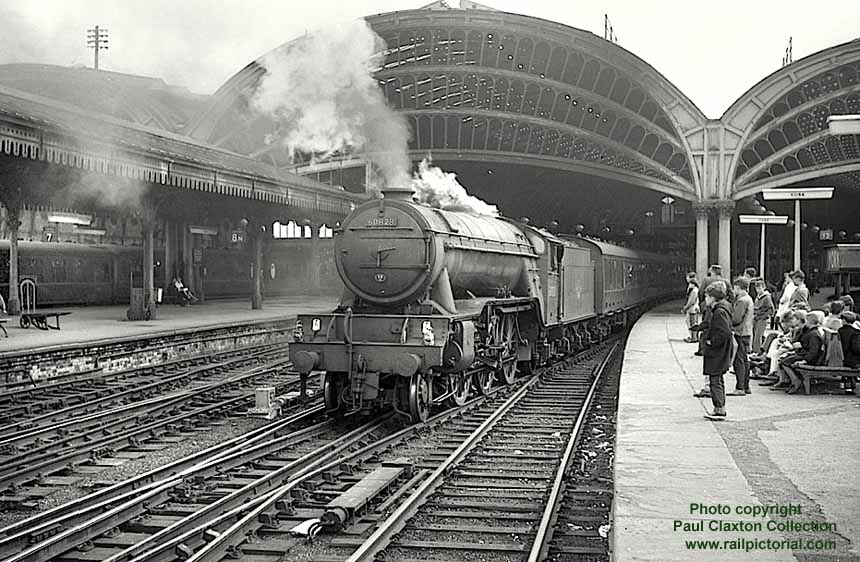
Paul's photo (above) reminds me of the comments made by Pete Stellings of Scarborough who contacted the site regarding a photo of Class 4F No 44108 departing Scarborough with 'The Scarborough Flyer' - yes, you heard right!
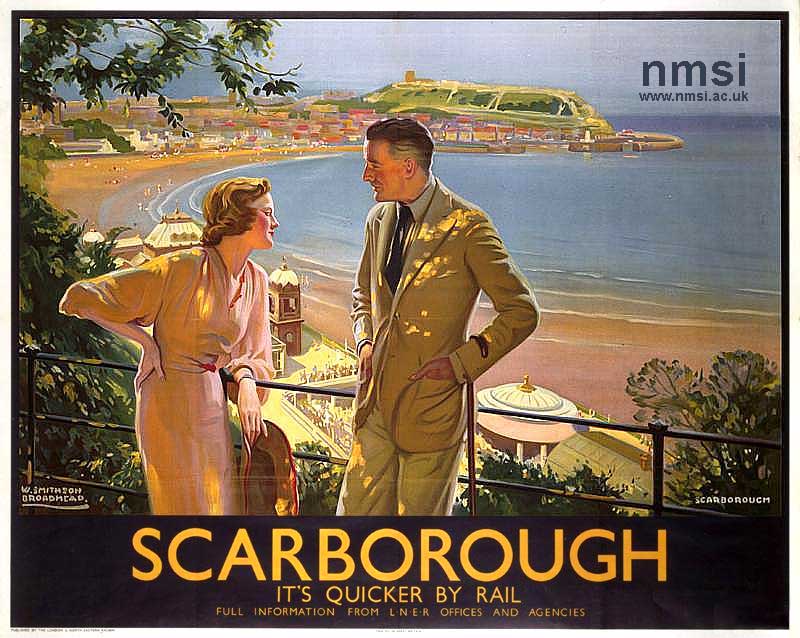 You will find the photo by Ken Hoole on the North Eastern Region Page 26.
You will find the photo by Ken Hoole on the North Eastern Region Page 26.Pete writes - 'The nominated diagram for the up 'Flyer' was the engine used on the early newspaper train from York arriving approx 04.00. This engine then worked the 'Flyer' back to York where a Pacific took over for the remainder of the run to Kings Cross. Over the years a variety of motive power was provided for the 'Flyer', including a Woodford Halse V2 on one occasion, but I am sure a B16/2 or B16/3 was normally diagrammed to fulfil this roll. However, York shed must have been scratching for one on this day, so the 4F arrived and was prepared.
However the driver said - 'NO I'm not taking that!' and was offered a B16/1 instead.
Perhaps the B16 had a dirty fire or something else was not up to standard because the driver said 'no' to that one too. He refused to put the headboard on the B16 and threw it on the ground!
The 4F duly went down to the station and took out the 'Flyer', and as far as I can recall reached York more or less on time. However, this unusual working prompted a letter to the authority's from Ken Hoole, who then presided over the Scarborough Railway Society (SRS).
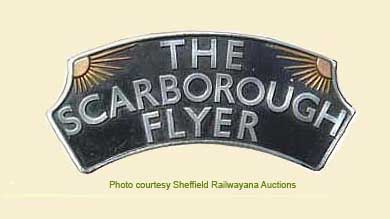 At the next SRS meeting, Ken read out his letter, the gist of which said that the stock for the 'Flyer' was cosmopolitan (teak and modern stock mixed) and needed upgrading for such a prestigious train. He also added that as the morning newspaper train was not run to a fast timing, the motive power could be a Pacific running tender first (the turntable at Scarborough was too small for turning a Pacific, though it managed a Britannia). Ken also suggested that even a V2 would have been more suitable being able to run beyond York...cheers, Pete Stelling.'
At the next SRS meeting, Ken read out his letter, the gist of which said that the stock for the 'Flyer' was cosmopolitan (teak and modern stock mixed) and needed upgrading for such a prestigious train. He also added that as the morning newspaper train was not run to a fast timing, the motive power could be a Pacific running tender first (the turntable at Scarborough was too small for turning a Pacific, though it managed a Britannia). Ken also suggested that even a V2 would have been more suitable being able to run beyond York...cheers, Pete Stelling.'I just love these little anecdotes from spotting days.
'A BRIEF MOMENT IN TIME - HADLEY WOOD - 24th AUGUST 1962'
The Paul Claxton Collection
The generally flat nature of the line out of Kings Cross is broken by a number of geological ridges between Hitchin and Potters Bar, with few other obstructions to speak of before the line arrived at Newcastle. During
 LNER days, the rural scenery around Greenwood Box (see Cuneo's painting above) became a favourite location for railway photographers, particularly as northbound trains were still climbing the 1 in 200 gradient to Potters Bar summit. Opened in 1876, the box controlled the 'up' goods line to Barnet, which later became the 'up slow' line on the East Coast Route at a point where the four tracks merged into two for the section through the tunnels at Hadley Wood. However, with rail traffic increasing it became a notorious bottleneck and the LNER acquired land in the 1930s with a view to widening the line, but it wasn't until 1953 (five years after nationalisation) that the British Transport Commission (BTC) instigated plans to bore a second set of tunnels alongside the original 1850 tunnels.
LNER days, the rural scenery around Greenwood Box (see Cuneo's painting above) became a favourite location for railway photographers, particularly as northbound trains were still climbing the 1 in 200 gradient to Potters Bar summit. Opened in 1876, the box controlled the 'up' goods line to Barnet, which later became the 'up slow' line on the East Coast Route at a point where the four tracks merged into two for the section through the tunnels at Hadley Wood. However, with rail traffic increasing it became a notorious bottleneck and the LNER acquired land in the 1930s with a view to widening the line, but it wasn't until 1953 (five years after nationalisation) that the British Transport Commission (BTC) instigated plans to bore a second set of tunnels alongside the original 1850 tunnels.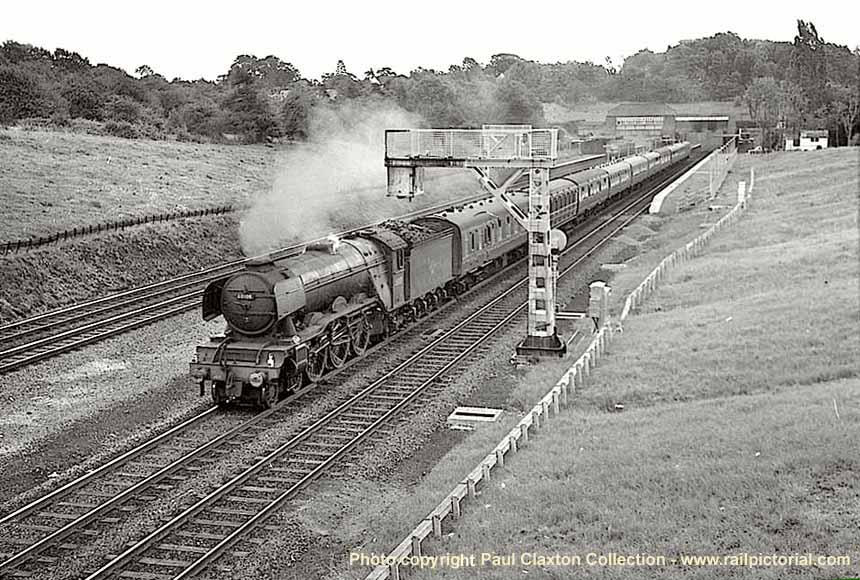
(Above-Below) By the early Sixties the ever-increasing demand for high-speed running necessitated the upgrading of the ECML between Kings Cross and Edinburgh. This involved the renewal of trackwork at major junctions plus a general easing in the curvature of the route in conjunction with the replacement of hundreds of miles of outdated Victorian-era semaphore signalling. Whilst work was carried out on widening the line at Hadley Wood the semaphores were replaced by modern multiple aspect (MAS) signalling, as seen in Paul's shots of Class A3 No 60107 Royal Lancer heading a down York Express on 24 August 1962 and Class A4 60017 Silver Fox storming through Hadley Wood with a northbound express on the same day.

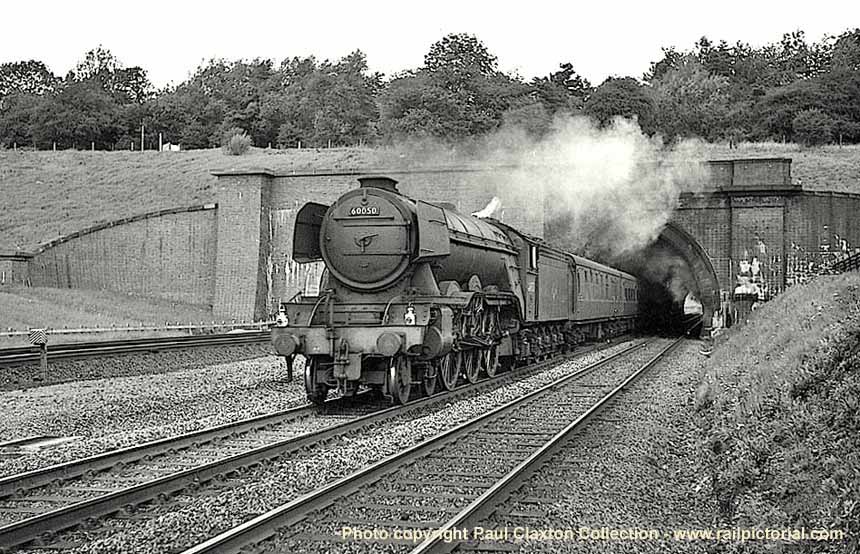
(Above-Below). Class A3 60050 Woolwinder emerges from Hadley Wood North Tunnel with a southbound express. The 'new' tunnel bore with concrete lined segments is on the left. These photos are just a small selection to be found on Mike Claxton's superb www.railpictorial.com websit, which is dedicated to the memory of his younger brother who sadly passed away in April, 2009.
Paul began train spotting at a very early age, and like most young boys during the late 1950s he started taking railway photographs, a natural adjunct to train spotting. His first camera was a Kodak Brownie 127, but this was quickly replaced by a Zeiss Ikon Nettar 120 rollfilm camera followed by a Kodak Retinette 1B 35mm camera in 1961. Paul acquired a Pentax S1A in 1965 and by the late 1970s he had graduated to a Nikon F [35mm] and a Pentax 6X7, albeit too late for BR mainline steam which ended in 1968, but ideal for recording most preserved railways and steam specials on the main line.
Mike has created this website so that enthusiasts can enjoy his late brother's photographic collection online…and what a collection it is! Rarely have I see such quality and in such high numbers on one website - currently standing at a little over 7,400 images and counting! Incredible! Needless to say, I am a big fan and a visit here is highly recommended. (Below) Class A1 No 60120 Kittiwake emerges from Hadley Wood North Tunnel with a Leeds Central-Kings Cross express on 24 August 1962.
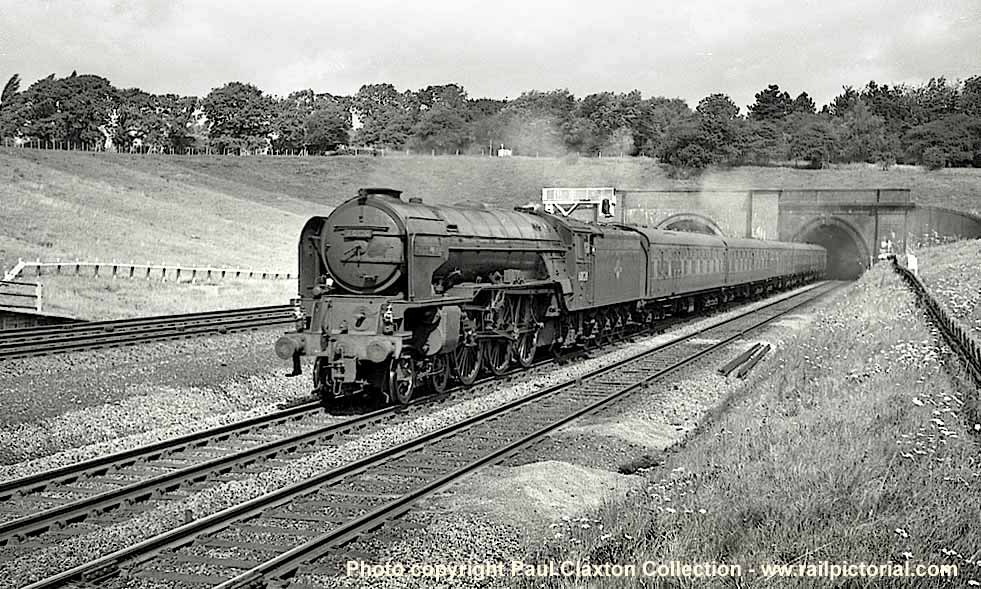
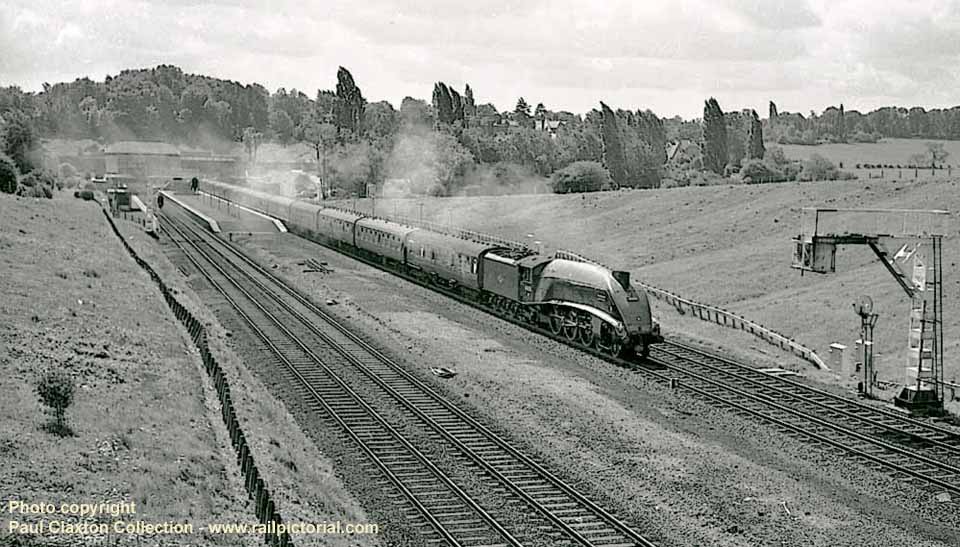
(Above) Class A4 No 60025 Falcon speeds through Hadley Wood with a northbound express on 24 August 1962. When work started on the Hadley Wood widening, the Eastern Region put forward plans to electrify the line from London Kings Cross to Scotland but due to penny-pinching stringencies, the Government only granted expenditure for electrifying the WCML out of Euston to Liverpool and Manchester via Crewe. As a result the East Coast route had to wait until the late 1980s. But I'm getting ahead of myself, we are still
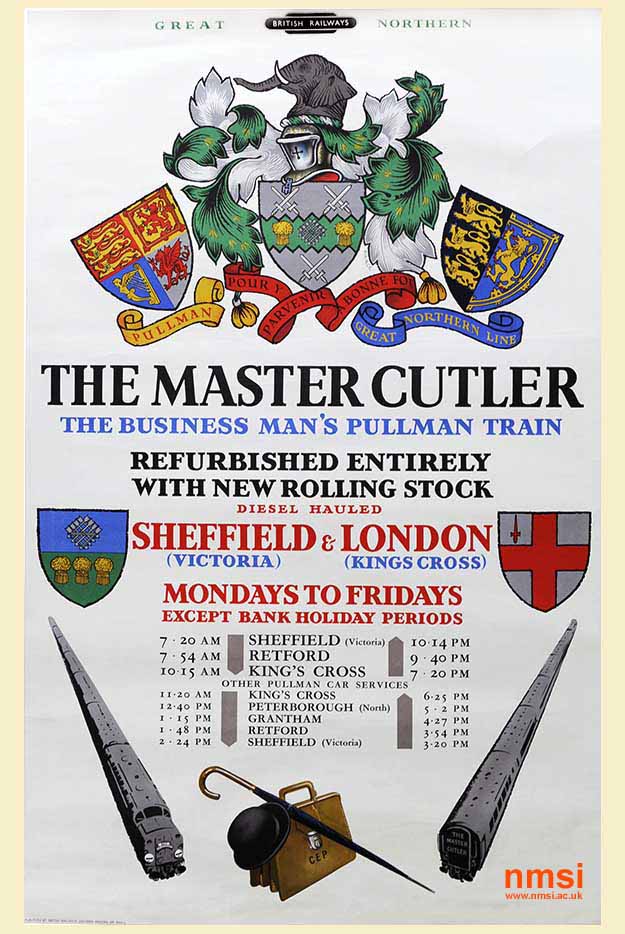 in the 1950s and after the tunnels at Hadley Wood South, Hadley Wood North and Potters Bar Tunnels had been completed in 1959, it became one of the first major improvements to the British Railways network since nationalisation over a decade earlier.
in the 1950s and after the tunnels at Hadley Wood South, Hadley Wood North and Potters Bar Tunnels had been completed in 1959, it became one of the first major improvements to the British Railways network since nationalisation over a decade earlier. (Inset) The 'Master Cutler' began service on the London & North Eastern Railway from Sheffield Victoria to Marylebone via the Great Central route in 1947. Following closure of the GC line, the 'Master Cutler' Pullman was diverted to run on the East Coast Main Line via Retford into Kings Cross. The train was made up of an almost uniform rake of the new Metro-Cammel Pullman cars, introduced in September 1960. The vehicles were used entirely on the East Coast main line Pullman services, but as no Pullman brake cars were built in the same order, the elderly flat-sided Pullman brakes were utilised as seen in the photo of 'Falcon' below.
(Below) The late summer of 1962 saw the end of two chapters in the development of BR main line diesel power. The first was the completion of the EE Co Type 4 D200s with the delivery of D399 - the last of 200 locomotives in the series - and construction of the Type 4 'Peak' class was concluded at Derby and Crewe with Nos D193 and D57 being the last of the respective batches built there. Meanwhile Brush Traction had set about the task of developing a prototype Type 4 locomotive, wholly financed and owned by the company, but as there were no single diesel power units available to produce the required 2,800hp, the company installed two high-speed Bristol-Siddeley/Maybach engines of 1,440hp. Aptly named 'Falcon' (after the builder's works) the prototype began trials in BR service working from Finsbury Park depot, and was used regularly on the 'Master Cutler' between Kings Cross and Sheffield via Retford. This consisted of two round trips a day (670 miles every 24 hours) albeit the lightweight Pullman of 240 to 320 tons made so little serious demand on a diesel locomotive of such power. Here D2080 'Falcon' heads the up 'Master Cutler' on 24 August 1962.
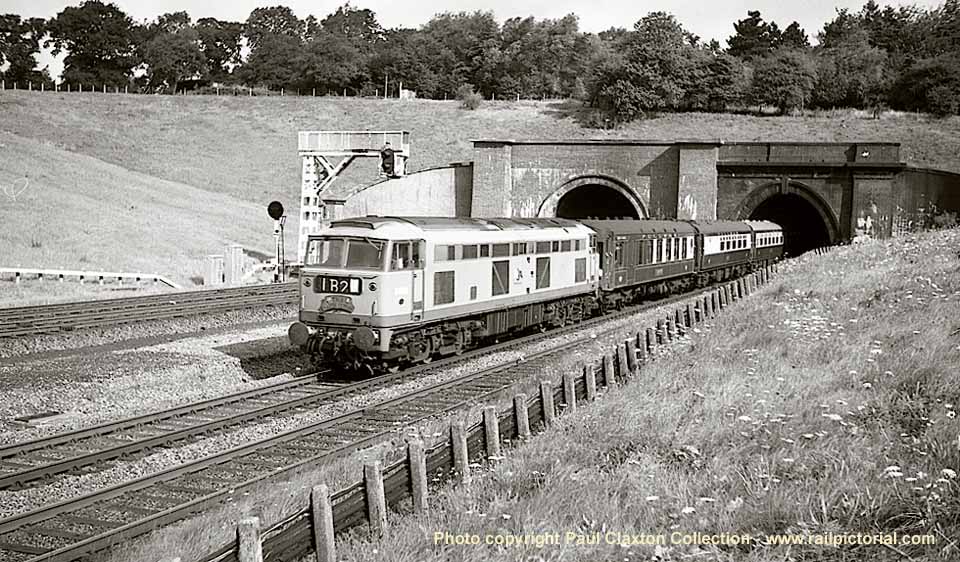
To give credit where it is due, Mike Claxton has pulled out all the stops in creating this website; he has done it for the simple reason that it gives enthusiasts a chance to enjoy his late brother's photographic collection online. It is an enormous task, and with only one pair of hands (and not enough hours in a day) Mike has had to ignore any thought of correcting the images, whereas the photos used on this page have been enhanced in Photoshop. Should you download copies of any of Paul's photographs from this page then it would be appreciated if you would make a donation to the Trinity House Hospice, Blackpool who cared for Paul in his fight against cancer. A click-on link is available here? It only takes a couple of minutes!
(Below) Hadley Wood North Tunnel is just over 200 yards long, and Hadley Wood South Tunnel 384 yards. Class A3 No 60048 Doncaster emerges from North Tunnel with a Grantham to Kings Cross express on 24 August 1962.
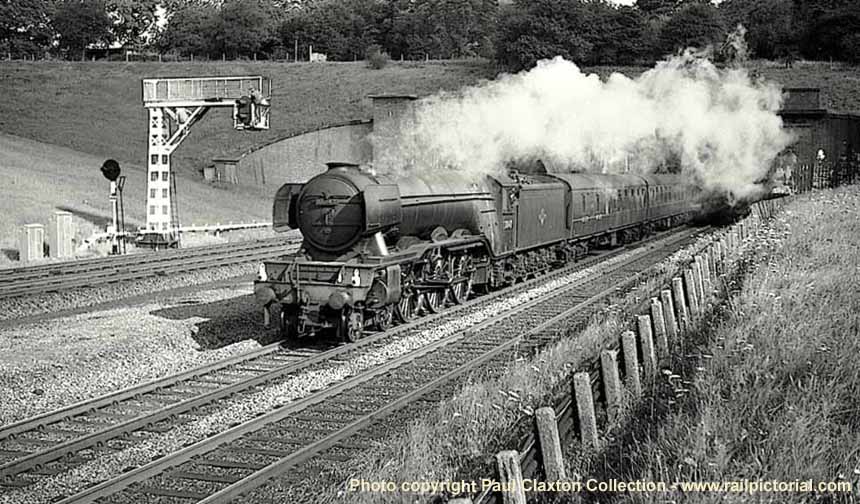
THE FOLLY OF YOUTH
In creating this website the remit has always been to share fond memories of train spotting with others. I'm harking back to the early 1960s when a legion of pubescent post-war baby boomers began sprouting manly stubble, and the time had come when they cared little about childhood spotting days, but a great deal more about embracing more grown-up things.
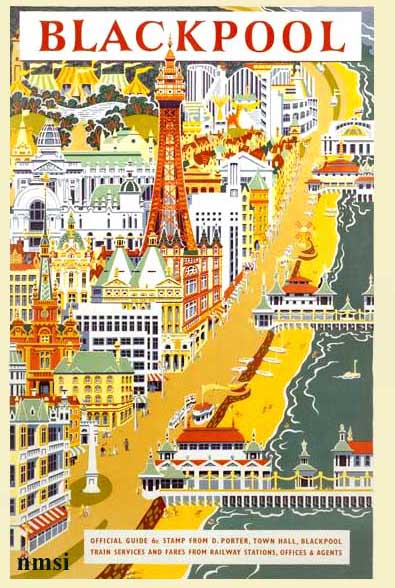 They still had a strong, emotional attachment to the hobby, of course - the thrill of the chase will never go away - but when the new-fangled diesels began ousting our beloved main line steam, many hormonal youngsters decided that bagging 'cops' on its own had lost its appeal during the 'youthquake' of the 'Swinging Sixties'.
They still had a strong, emotional attachment to the hobby, of course - the thrill of the chase will never go away - but when the new-fangled diesels began ousting our beloved main line steam, many hormonal youngsters decided that bagging 'cops' on its own had lost its appeal during the 'youthquake' of the 'Swinging Sixties'. It happened to me in 1964 when the Beatles came on the scene. I ditched my 'rag-bag' spotting image: wellies, anorak and pom-pom hat emblazoned with Ian Allan Locospotters badges and hot-footed it down to the nearest dance hall - and, with lips puckered like innertubes, pranced around like a sack-of-spuds to the Rolling Stones' hit - 'I Wanna Be Your Man'.
With hindsight, I made a complete prat of myself, and it wasn't until a few months later on a Youth Club trip to Blackpool that I came to my senses. It happened during a visit to the famous tower. On hearing a steam locomotive whistle in the distance all my spotting memories came flooding back - and,
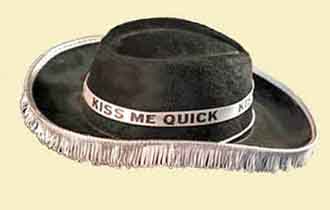 hoping the gang wouldn't see me, I hid the camera behind my stupid 'Kiss-me-quick' hat and snatched a 'sneaky' shot of the resort's now-closed Central Station - once the terminus of the direct route from Preston; a link to the photo is featured in the last paragraph at the bottom of the page.
hoping the gang wouldn't see me, I hid the camera behind my stupid 'Kiss-me-quick' hat and snatched a 'sneaky' shot of the resort's now-closed Central Station - once the terminus of the direct route from Preston; a link to the photo is featured in the last paragraph at the bottom of the page.Nowadays I have little trouble talking about my passion for trains, but the reality was not so clear-cut back then. I would rather have confessed to an infestation of nits than declare my penchant for taking photographs of steam trains. On reflection, peer pressure can make Judas's out of us all and it's sad that I didn't make a clean breast of it earlier.
However, the arrival of John, Paul, George and Ringo had a huge impact on teenagers during the Sixties. Not only did the 'Fab Four' reinvent pop music, they changed fashion too. The Mersey Sound paved the way for the new pop conveyor belt of the Seventies, with boy bands wearing girlie make-up and glittery
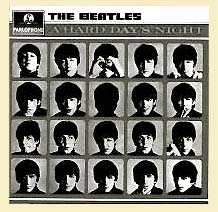 sequins - and still to come: the extravagant 'loadsa' money era of the Eighties and the launch of a new genre of pop music with groups known collectively as the 'New Romantics' - Culture Club, Spandau Ballet, Duran Duran and Frankie Goes to Hollywood blasting us with an electronic wall of sound from simple, one note synthesisers.
sequins - and still to come: the extravagant 'loadsa' money era of the Eighties and the launch of a new genre of pop music with groups known collectively as the 'New Romantics' - Culture Club, Spandau Ballet, Duran Duran and Frankie Goes to Hollywood blasting us with an electronic wall of sound from simple, one note synthesisers. It was the start of the rock anthems of the Eighties which simply took your breath away. In place of spectacular guitar riff and drum solos, DJ's pumped up the volume in strobe-lit discos and the kids were into 'gangsta-rap' and 'garage music', all of which makes me feel - well, prehistoric..
KOLHAPUR OR KHOLAPUR!
Please note: some names have been changed to protect the innocent...
In line with LMS's policy of naming the Stanier Class 5XP 'Jubilee' 4-6-0s after Commonwealth countries, No 5593 (built in 1934 by the North British Locomotive Company, Works number 24151, part of Lot 1184) was named Kolhapur after a princely state in western India. Following nationalisation in January 1948, 5593 was renumbered 45593 and allocated to various sheds in the 1950s and 1960s, including Longsight, Carlisle Upperby, Willesden, Aston, Burton, Patricroft and Newton Heath.
In March 1965 she was transferred to Leeds Holbeck (55A) and this is where our story unfolds...
I'll begin with a link to a lovely shot of 45593 here which appears on Page 69; the photo was taken by Rail Cameraman, Trevor Ermel, who writes - '45593 was beautifully clean (thanks to enthusiasts at Holbeck shed), but looked rather plain in unlined green. It was devoid of nameplates, although the name (incorrectly spelt as Kholapur) had been painted on the backing plate above the left-hand splasher. No doubt the enthusiast who painted it winces every time it comes up!'
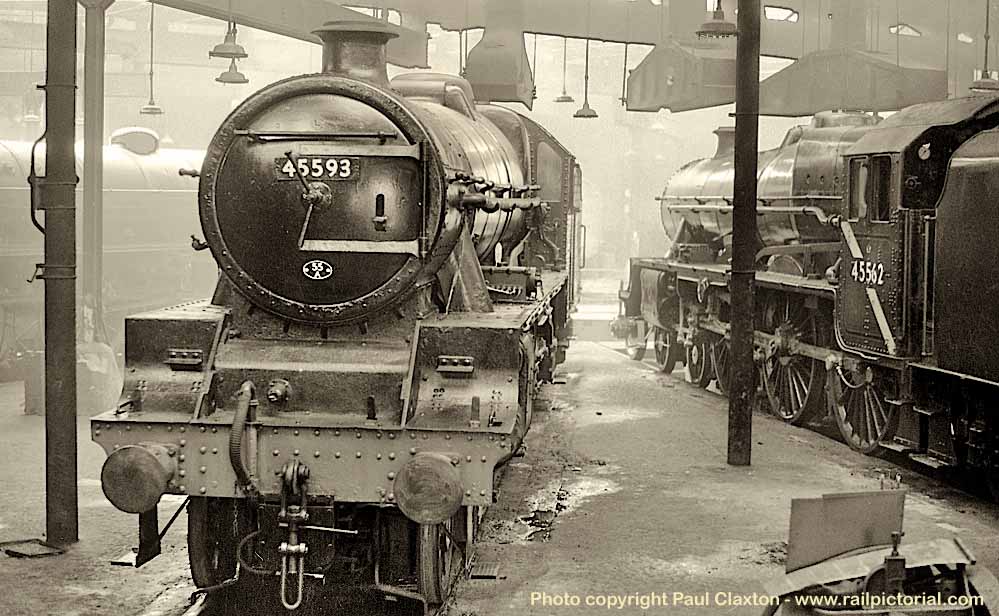
Now I make no secret of the fact that I'm a frustrated railway magazine editor, hence the reason I spend so much time working on this website, and on reading Trevor's comments about the misspelled name of 45593 my journalistic instinct kicked in. It was telling me that this woeful tale of mistaken identity was worthy of further investigation and I made a note to follow it up.
However, it wasn't until I stumbled upon Paul's photos of 45593 Kolhapur and sister 'Jubilee' 45562 Alberta standing cheek to jowel inside the roundhouse at Holbeck shed, and actually saw the misspelt name Kholapur in close up (below) that I decided to find out who was responsible.
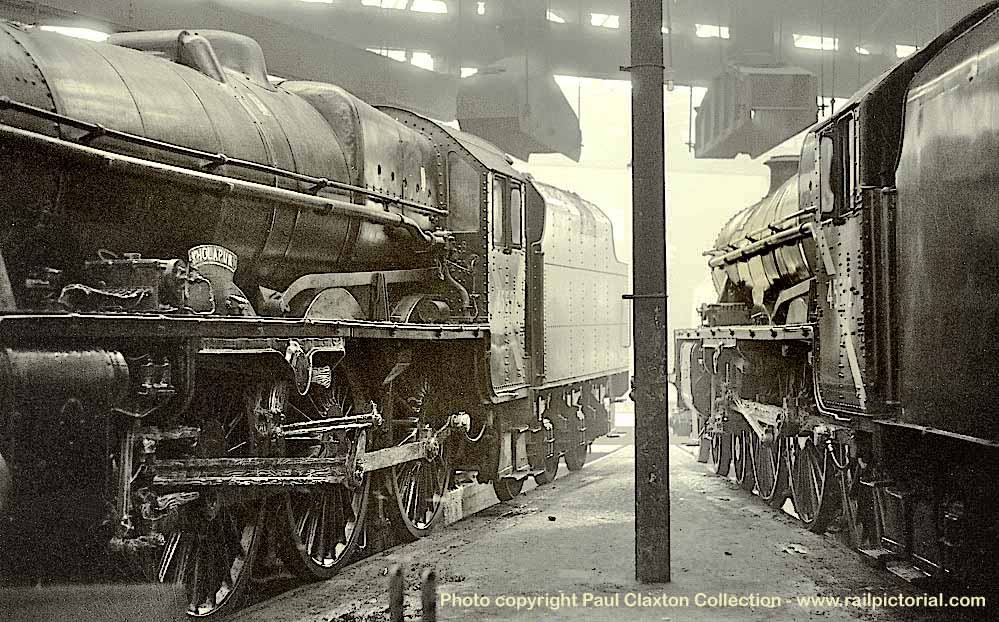
I should point out that the comments relating to my investigations are written with one's tongue firmly in cheek. Those responsible should be cherished...not mocked. I am not a stitch-up artist. This classic whodunit has been a part of our spotting history for nigh on five decades, and I wanted to get to the bottom of it once and for all; indeed whilst in pursuit of the facts it is wonderful to come across a gaggle of cantankerous old codgers now well past their prime - and I include myself in that category - who are still in full possession of their faculties and have somehow managed to retain their impish sense of humour all these years later.
I began by asking Rail Cameraman, Richard Greenwood MBE, if he knew anything about it.
Richard duly put the word out - 'Do you know anything about someone painting 45593's name and spelling it wrongly Kholapur?'
WO responded first - 'Yes, I think WT did it...he always claimed he did it.'
Richard contacted WT - 'Are you in a position to spill the beans WT?'
WT replied rather sharply - 'I never claimed anything of the sort! Kindly do not post comments relating to situations where you cannot conclusively corroborate your facts! Possibly, in your apparent advancing
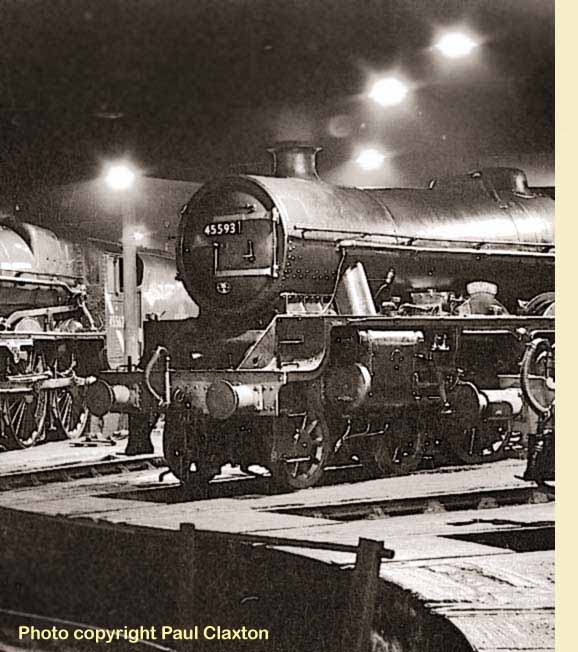 senility, you are confusing me with Bob C, who might well be able to shed a little more information on that unfortunate matter, which, it must be added, was almost immediately rectified by the 'artist' concerned...'
senility, you are confusing me with Bob C, who might well be able to shed a little more information on that unfortunate matter, which, it must be added, was almost immediately rectified by the 'artist' concerned...' WT finished off by saying - 'I am forced to add, as a postscript to this missive, that it certainly would not have been one WO himself who might have been responsible. WO was one of quite a few who never, ever, laid a cleaning rag - let alone a 'misguided' paintbrush - to a steam locomotive!
Hoping this has been of assistance...'
At this juncture Bob C stepped into the breach...
'Oh dear! Do steady on chaps! he implored - 'This matter can be very simply cleared up along with all of the circumstances of that occasion some 46 years ago. I'm rather pleased to say amid this entire fracas that it was I who incorrectly painted the name 'Kholapur' on 45593's left hand name backing plate!
The background to the event began in early March when I wrote to (either Tom Greaves - DMPS (West Riding) one of the shedmasters at 55A) to ask if he would be good enough to roster one of his 5XP's for the northbound relief 'Thames-Clyde' on Maunday Thursday 23rd March.
I turned up at 55A with Bert in the early hours of Thursday very pleased to see that on the rostor board No 45647 was assigned to the relief 'Thames-Clyde' - and as a bonus No 45593 was rostered for the afternoon Heysham parcels.
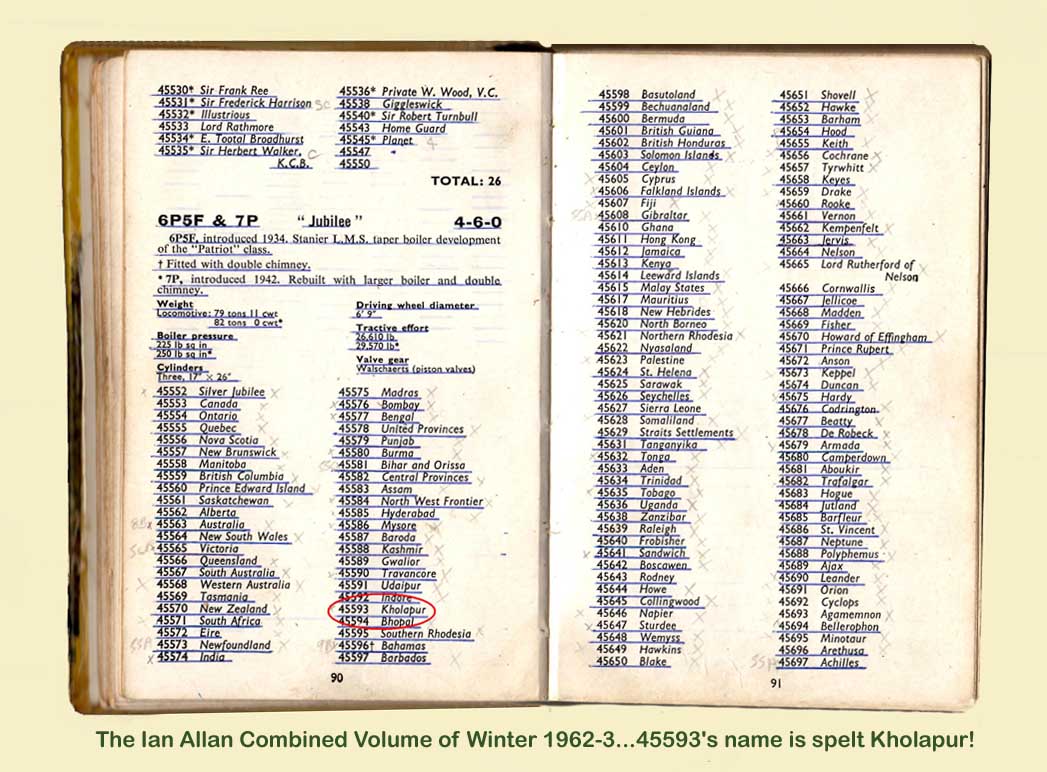 So Bert and I set about cleaning the left hand side of 45647. We knew pretty well where we would be photographing the trains in the Settle-Giggleswick area (and, sun permitting, we would only need to clean the left side). We did a pretty good job and still had plenty of time to spare, so we decided to make a start on cleaning the left-hand side of 45593 too.
So Bert and I set about cleaning the left hand side of 45647. We knew pretty well where we would be photographing the trains in the Settle-Giggleswick area (and, sun permitting, we would only need to clean the left side). We did a pretty good job and still had plenty of time to spare, so we decided to make a start on cleaning the left-hand side of 45593 too.45593's backing plate was bare so I painted the name 'KHOLAPUR' on it. This sort of thing was common practise around this time and I invariably carried small pots of red and white-cream paint for such purposes.
It is interesting to note that in my last Ian Allan Combined Volume of Winter 1962-3 - 45593's name is spelt Kholapur!
Anyhow, Bert and I met up with Paul Claxton, Pete Fitton and travelled in Pete's car to Settle.
We all got our 'master shots' of 45647 in strong low sun and I reckon it is without doubt my best shot of a 5XP. Then we all went across to the summit just west of Giggleswick to photograph 45593 on the Heysham parcels, again in glorious early spring sunshine and my cine shot pans around on 45593's nameplate perfectly capturing the misspelt name. Great days eh...!
Cheers, Bob C...'
Richard sums it up - 'Well, this has opened a real hornet's nest!'
It certainly has, and I feel privileged to have it on the site...thank you, gentlemen. This classic tale will doubtless pass into train spotting folklore!
(Below) 45593 Kolhapur on the Heysham parcels at Giggleswick on 23 March 1967.
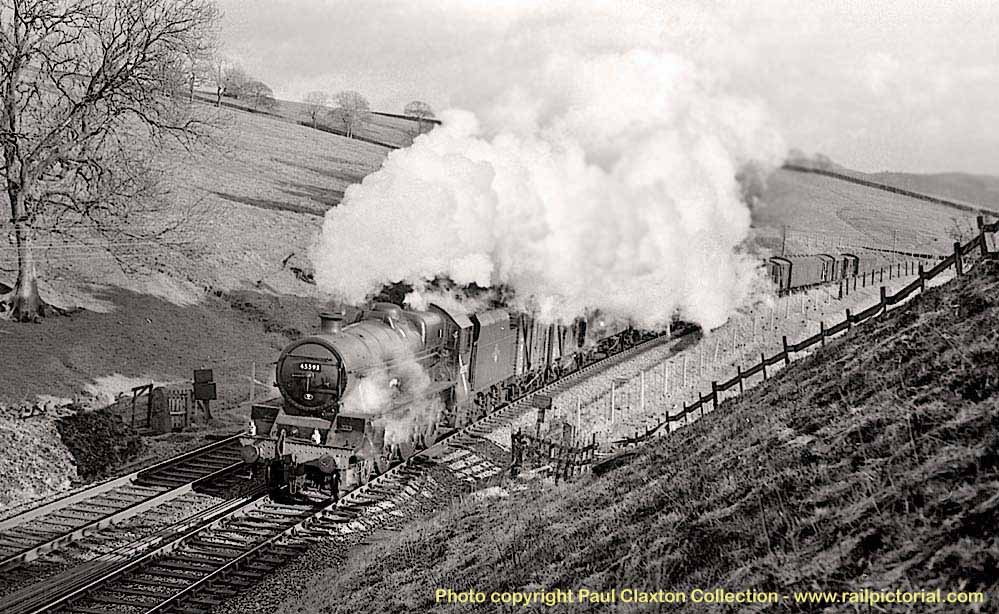

BAH HUMBUG!
I'm writing this on Mischief Night in 2013; I'm telling you this because according to the traditional calendar the accepted date varies in different regions. Here it falls on November 4th and Christmas is now less than eight weeks away.
'So here it is - Merry Christmas, everybody's having fun…'
No, we're not! Tis the season to be cranky, and the fact that Christmas seems to starts earlier year by year makes my grouchiness a whole lot easier. This year the hype started in October and the weekly shopping is already a nightmare! The supermarket aisles have been taken over by inflatable Santas and reindeers; the shelves are stacked with selection
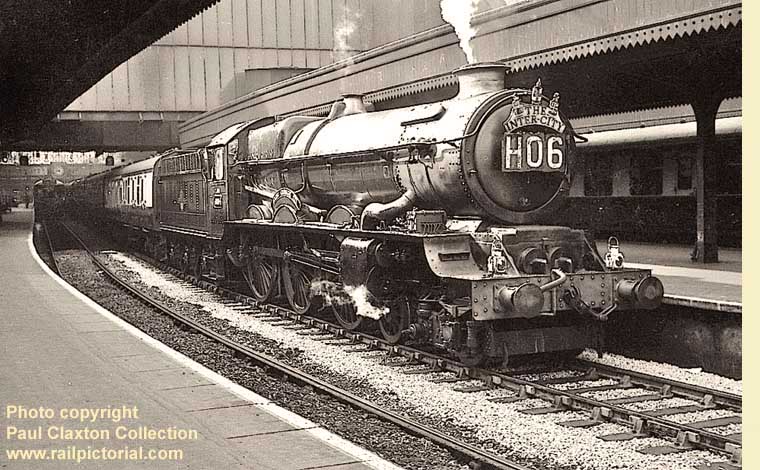 boxes, and I'm under siege by a barrage of fake good cheer and forced joviality.
boxes, and I'm under siege by a barrage of fake good cheer and forced joviality. What on earth are today's money-grabbing marketing whizzkids thinking of? All this jolliness doesn't sit well with curmudgeonly old geezers like me. Having popped into the supermarket for a loaf of bread the last thing I need is a banal Christmas song by Slade blasting in my ears - 'Look to the future now, it's only just begun...'
No it hasn't! This ridiculous in-your-face commercialism is driving me nuts. The yuletide period is turning more into spin than substance, it's fast becoming a yearly celebration aglow with unnatural excitement and little sign of reverence - and yes, you've guessed it, the retailers are rubbing their hands with glee...the message is clear - spend, spend, spend! Okay, I'll stop right there. I've written some odd captions in my time but this is turning into a rant!
'We three kings of Orient are; bearing gifts we traverse afar, field and fountain, moor and mountain, following yonder star...' Actually there are two 'Kings' featured here. (Top) Paul photographed No 6010 King Charles l at Paddington's Platform 9 following arrival with the up 'Cambrian Coast Express' on 16 August 1961. (Below) No 6004 King George lll rests at the buffer stops at Platform 6 with a train from Birmingham; in the adjacent platform is Hawksworth's 94XX 0-6-0 pannier tank No 9407 with empty stock...and later in the day, having been turned, coaled up and watered, No 6004 is about to return to the Midlands (inset) with the down 'Inter City'. You will find more shots of Paddington on Mike's 'Western Region' section here
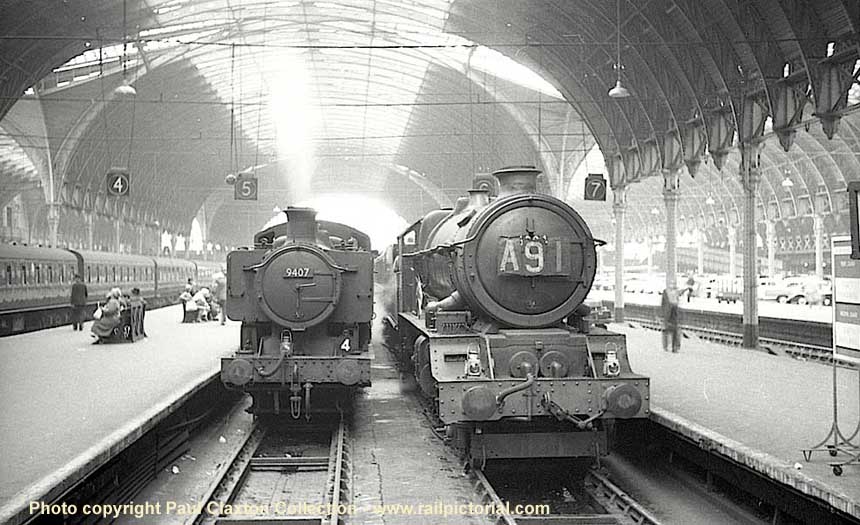

(Above) Following the announcement of the Modernisation Plan in 1955 and the subsequent abandonment of the pilot scheme diesels, in which large orders had been placed for predominantly Type 2 diesel locomotives of between 1,000 and 1,365 engine horsepower, BR recognised the need for a more powerful Type 3 of around 1,750hp, which saw the beginning of the diesel-hydraulic 'Hymek' era (later TOPS Class 35) on the Western Region. The first of the Beyer-Peacock 1,700hp Type 3s was handed over to the Western Region at a ceremony held at Paddington on May 16th 1961. Here, the attractive two-tone green livery and white cab window surround show up well on D7038 heading a Swansea to Paddington train at Old Oak Junction on 21 August 1962.
For the record, Paul was just 15 years-old when he first visited Paddington in 1961. In that same year the Beatles performed at the legendary Cavern Club in Liverpool for the first time; the Jaguar E-Type was launched as a two-seater roadster and Berliners awoke to find themselves living in a divided city after East German troops sealed the border between East and West Berlin.
Back in the UK, betting shops were legalised; Tottenham Hotspur won the double: both the Division One League title and FA Cup; George Blake was found guilty of operating as a double agent in the pay of the Soviet Union and was sentenced to 42 years imprisonment; Angela Mortimer beat Christine Truman in an all-British women's final at Wimbledon; police arrested over 1,300 protesters in Trafalgar Square during a CND rally; Acker Bilk's smash-hit 'Stranger on the Shore' was released; the population of Tristan da Cunha (a small island in the South Atlantic) was evacuated to Britain following a major volcanic eruption; birth control pills became available on the National Health, and two Commonwealth countries, Sierra Leone and Tanganyika ('Jubilee' class Nos 45627 and 45631, in case you're wondering) gained independence from the UK.
Staying on the subject of trains, in 1961 both the 'Western' and 'Hymek' class diesel hydraulics made their debut on the Western Region, and the English Electric Co's Type 5 'Deltic' and Type 3 entered traffic on the Eastern Region...six years had passed since the Modernisation Plan was announced.
It was also a momentous year in the space race...in April 1961 the Soviets launched the first man into space (Yuri Gagarin) and the United States had to settle for second place the following month when Alan Sheppard was launched into orbit aboard the Freedom 7 rocket.
However, the Soviet Union was consistently one step ahead of the US, until a rousing speech by President Kenned in May 1961 led to the Americans launching the Apollo 11 mission to the moon in July 1969, and Neil Armstrong and Edwin 'Buzz' Aldrin became the first men to walk on the Lunar surface...all in all, the decade was a giant leap for mankind, but a huge disappointment for devout steam fans.
(Below) The doyen of the English Electric 'Deltic' Type 5 fleet, D9000 heads the southbound 'Talisman' through Doncaster on 12 September 1961. Introduced to traffic on 28 February 1961, a top lamp iron has yet to be fitted to the nose end, and the express train headboard is mounted on a bracket slipped into two front-end slots below the headcode display panel. Note also the express passenger headlamp code - two lamps above the bufferbeam - a legacy of steam days.
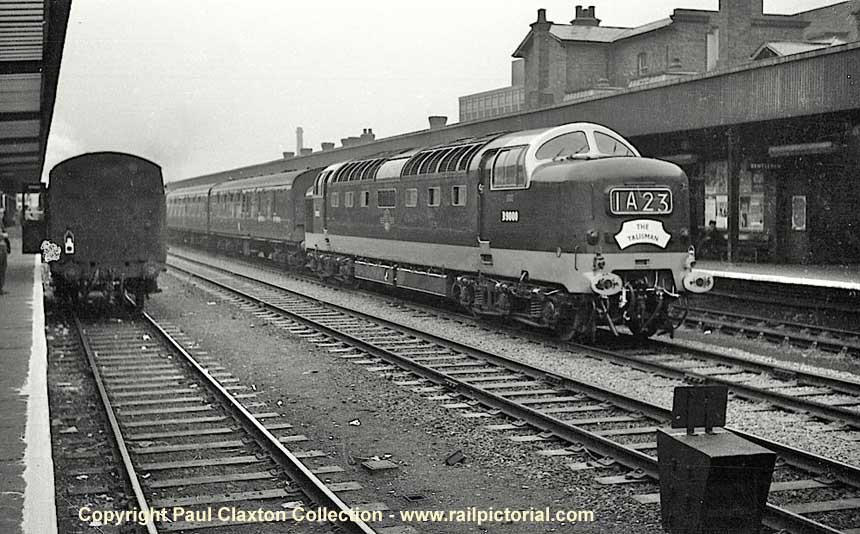
ANOTHER STITCH IN THE RICH TAPESTRY OF LIFE
The passing of years has a funny way of catching you out in the end; for it seems only yesterday that I was small boy in short pants embarking on his first day at Broadgate Lane Junior School. Before morning assembly, my pals and I were kicking a ball around the playground when a distant whistle alerted us to a dirty Class A2 60526 Sugar Palm heading a southbound express down Horsforth's Woodside valley to Leeds. As it disappeared behind the trees, a 'Hunt' class appeared in the opposite direction, labouring hard
 up the bank with a stopping train - and in that same instant it dawned on me that I could carry on train spotting all day long at my new school, which made the task of getting up on a morning a whole lot easier.
up the bank with a stopping train - and in that same instant it dawned on me that I could carry on train spotting all day long at my new school, which made the task of getting up on a morning a whole lot easier. In reality, of course, nothing could have been further from the truth. Any notions I had of dashing to the classroom window in the middle of lessons to scribble down an engine number came to an abrupt halt when the teacher threatened to nail me to the desk.
I'm harking back to events that happened almost sixty years ago, and I do wonder where all the years have gone since then. To suddenly finding myself in the winter of my life has caught me off guard. How did I get here so fast? More to the point, where did it all go wrong! Yes, I have regrets, of course I have; who doesn't when they get older? I certainly lament all the hopes and dreams I had but never got around to doing, not to mention all the stupid mistakes I made and shouldn't.
Worse still, now that the ageing process has finally caught up I find some of the things I once cared doing, I no longer care to do, but I really do care that I don't care to do them anymore...
Okay, I guess you're wondering where all this philosophical flimflam is leading?
Well, if you're still in your prime, the most important thing to remember is this...not only is today the
 oldest you've ever been, it is the youngest you'll ever be - so make the most of your lifetime experiences before you too end up wondering where all the years have all gone.
oldest you've ever been, it is the youngest you'll ever be - so make the most of your lifetime experiences before you too end up wondering where all the years have all gone.(Below) Rain, rain, rain...you do not always need sunshine to produce a great picture, especially if the subject matter is strong enough; this is certainly the case here with Western Region Britannia 70016 Ariel at Old Oak Common depot (81A) in London. The rain is fairly 'bucketing' down, but our intrepid young railway photographer is grasping the opportunity before the engine moves off the yard, and the chance is gone. 70016 was transferred to Carlisle Canal shed just three weeks later. The large Old Oak coaling stage is hidden by the locomotive, with only the extension archways visible.
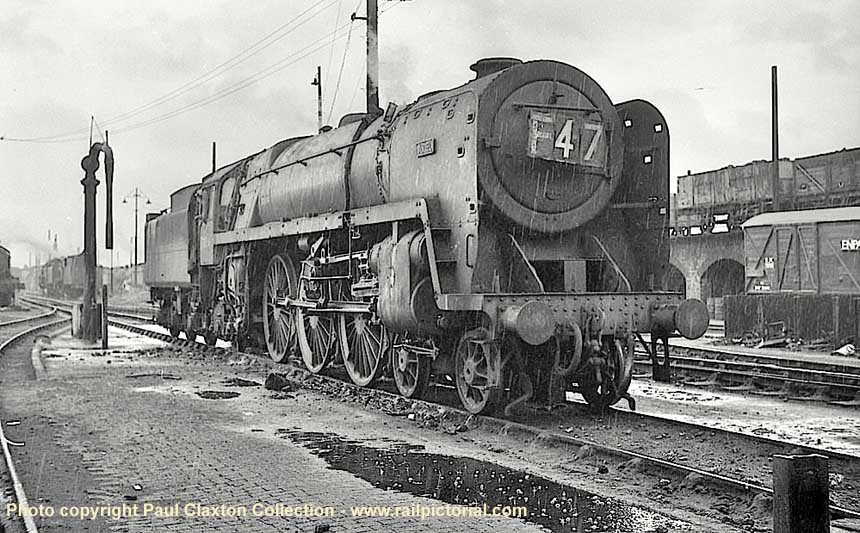
WEST COAST MAIN LINE

(Above) A fine study of Stanier Pacific No 46254 City of Stoke-on-Trent heading a Glasgow-London express through Farington, just south of Preston, on 29 July 1961.
(Below) This is yet another a powerful shot of WCML steam days from Paul's collection; Class 9F No 92046 heads a northbound freight beneath the famous LMS signal gantry at Preston. The gantry was one of the biggest of its type in the country which spanned the complex of lines radiating from the north end of Preston station and controlled the junctions for Blackpool, West Coast Main Line and Lowbridge line. Whilst the effects of WCML electrification from Euston to Crewe, Manchester and Liverpool showed considerable improvements to train services, the main line north of Crewe had to wait a while longer before it was upgraded. Almost the entire route was still equipped with manual block and aged semaphore signalling, however this came to an end in the Preston area following the commissioning of a new power box in November 1972. Click here to visit the excellect Wikipedia page on the WCML.
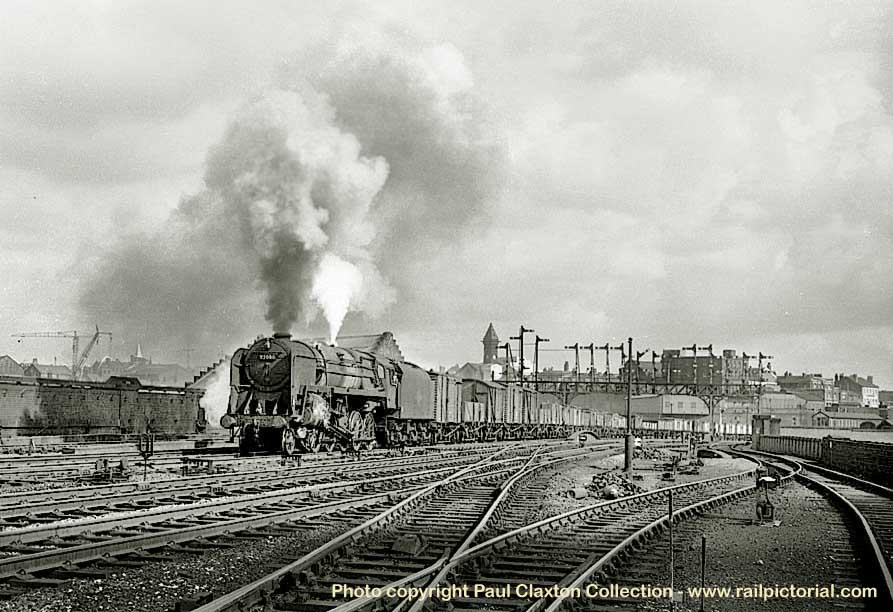

(Above) After BR steam dropped the fires for the last time at Carnforth, Lostock Hall and Rose Grove in August 1968, it left a forlorn silence hanging over sidings full of cold engines grouped together awaited scrapping, their tenders emptied of coal, the connecting rods sliced through by oxy-acetylene cutter in readiness for towing by diesel to their final resting place. Meanwhile, Carnforth shed had become the refuge for a collection of preserved engines already stored in the yard and so when BR sanctioned occasional steam operation in 1972 the enterprising Carnforth Steamtown emerged as the epicentre of British main line steam preservation, with steam-hauled trains running almost every week - the 'Cumbrian Coast' and 'Cumbrian Mountain' expresses...but this is still a long way off as Fowler 2-6-4T No..
The history of the West Coast Main Line is an interesting one, particularly during the transition from steam. Following
 the announcement of the BTC's Modernisation Plan in 1955, the WCML was electrified in three stages between 1959-1974. The nature of engineering work involved the lifting of most existing road bridges, or lowering of track level to obtain the necessary clearance for the overhead catenary. The section of WCML between Euston and Crewe required work on 78% of the 904 bridges concerned, whilst 82% of the bridges had to be rebuilt on the 44 miles between Crewe and Manchester. Inevitably, the extent of modernisation involved prolonged disruption of train services due to lengthy detours for almost 14 years; the line between Crewe and Manchester was the first to be energised on 12th September 1960. This was followed by the Crewe to Liverpool line on 1st January 1962. Electrification was then extended southwards to London, with electric trains running from London Euston in November 1965, though the full service did not commence until April the following year. Electrification of the Birmingham line was finished in March 1967. Then in March 1970 the Government finally gave approval to electrify the remainder of the route north of Crewe to Glasgow and this was completed in May 1974.
the announcement of the BTC's Modernisation Plan in 1955, the WCML was electrified in three stages between 1959-1974. The nature of engineering work involved the lifting of most existing road bridges, or lowering of track level to obtain the necessary clearance for the overhead catenary. The section of WCML between Euston and Crewe required work on 78% of the 904 bridges concerned, whilst 82% of the bridges had to be rebuilt on the 44 miles between Crewe and Manchester. Inevitably, the extent of modernisation involved prolonged disruption of train services due to lengthy detours for almost 14 years; the line between Crewe and Manchester was the first to be energised on 12th September 1960. This was followed by the Crewe to Liverpool line on 1st January 1962. Electrification was then extended southwards to London, with electric trains running from London Euston in November 1965, though the full service did not commence until April the following year. Electrification of the Birmingham line was finished in March 1967. Then in March 1970 the Government finally gave approval to electrify the remainder of the route north of Crewe to Glasgow and this was completed in May 1974.(Inset-Below) The naming of the West Coast Main Line between London and Glasgow is something of a misnomer since the coast is only visible to passengers along a short section of track, barely half a mile long, which skirts Morecambe Bay at Hest Bank between Lancaster and Carnforth. (Below)...
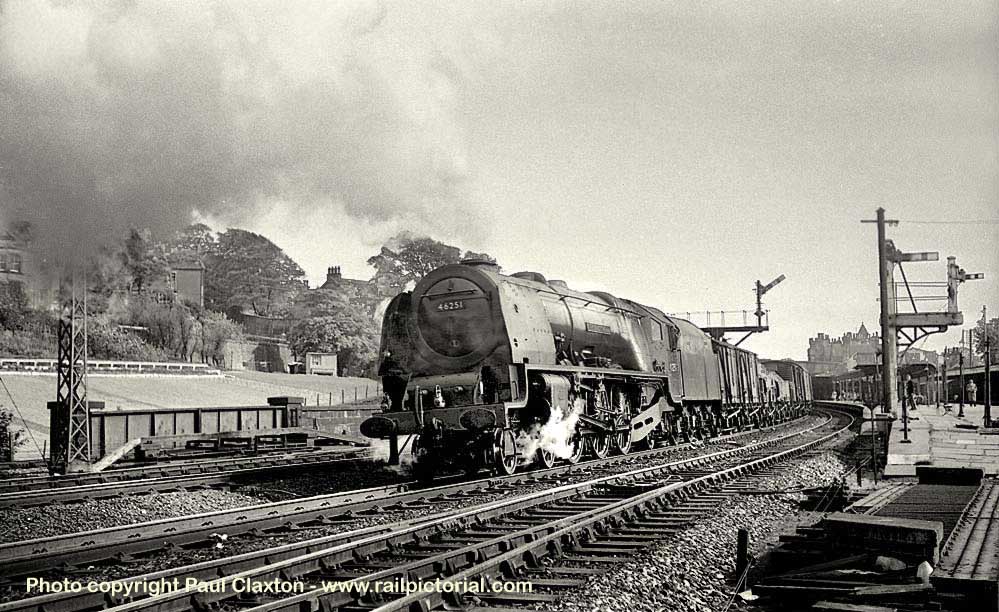

(Above) The ever-dwindling traces of closed branch lines are still comparatively easy to follow, while others have been obliterated with the passing of years. Paul's shot of the now-closed Lancaster Green Ayre
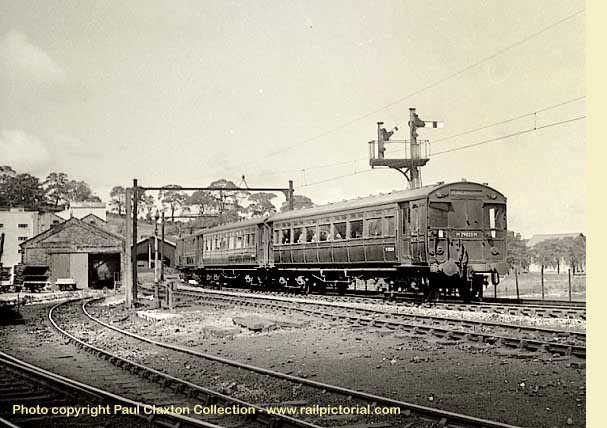 railway station shows 0-6-0T No 47662 propelling a brake van onto the spur leading up to Lancaster Castle station on 19 April 1964. Green Ayre station was situated on the MR line to Morecambe on the south bank of the River Lune. In 1908 the line was chosen for experimental electrification with current collection via overhead wires. It was the first high-voltage (6,600 volts AC 25Hz) railway in the country and intended as a test bed for possible future electrification by the Midland Railway. This view is looking west to the junction with a connecting curve to Lancaster Castle station and Green Ayre's engine shed (24J); the MR line to Morecambe crosses the river via Greyhound Bridge just visible in the right background. In 1952 the original electric rolling stock was becoming life expired and subsequently withdrawn; new stock was introduce when the power supply was upgraded to 50Hz.
railway station shows 0-6-0T No 47662 propelling a brake van onto the spur leading up to Lancaster Castle station on 19 April 1964. Green Ayre station was situated on the MR line to Morecambe on the south bank of the River Lune. In 1908 the line was chosen for experimental electrification with current collection via overhead wires. It was the first high-voltage (6,600 volts AC 25Hz) railway in the country and intended as a test bed for possible future electrification by the Midland Railway. This view is looking west to the junction with a connecting curve to Lancaster Castle station and Green Ayre's engine shed (24J); the MR line to Morecambe crosses the river via Greyhound Bridge just visible in the right background. In 1952 the original electric rolling stock was becoming life expired and subsequently withdrawn; new stock was introduce when the power supply was upgraded to 50Hz.  (Right) A fully flanged maroon BR London Midland Region totem station sign for 'Lancaster Green Ayre' went under the hammer for £800 at a recent Railwayana Auction UK. The passenger service to Morecambe fell victim to the Beeching axe in January 1966, but the line remained open for freight traffic until March 1976. Green Ayre station was demolished that same year and the abandoned Greyhound Bridge was converted to carry one-way traffic on the A683 to Morecambe in 1972. The site of Green Ayre
(Right) A fully flanged maroon BR London Midland Region totem station sign for 'Lancaster Green Ayre' went under the hammer for £800 at a recent Railwayana Auction UK. The passenger service to Morecambe fell victim to the Beeching axe in January 1966, but the line remained open for freight traffic until March 1976. Green Ayre station was demolished that same year and the abandoned Greyhound Bridge was converted to carry one-way traffic on the A683 to Morecambe in 1972. The site of Green Ayre 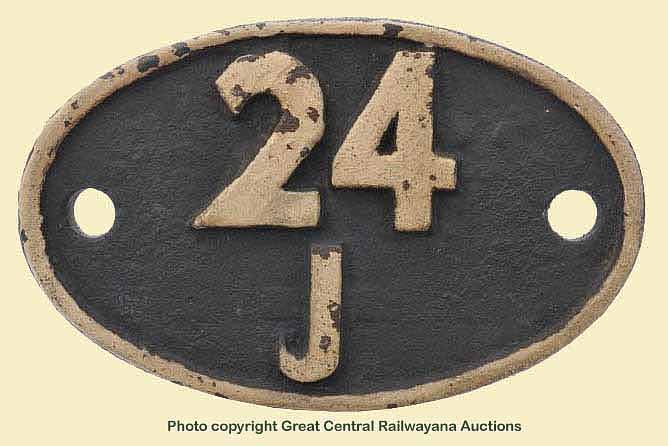 station is now a public park and the adjacent steam shed was demolished to make way for a supermarket.
station is now a public park and the adjacent steam shed was demolished to make way for a supermarket. (Left) This 24J shedplate - Lancaster Green Ayre from February 1957 to September 1963 - recently went under the hammer at a Great Central Railwayana Auction. This ex-MR shed had no fewer than five codes during BR days. Originally 20H, 23C, and 11E, it had 35 locos when using this code. Its final code was 10J. The plate is in ex-loco condition.
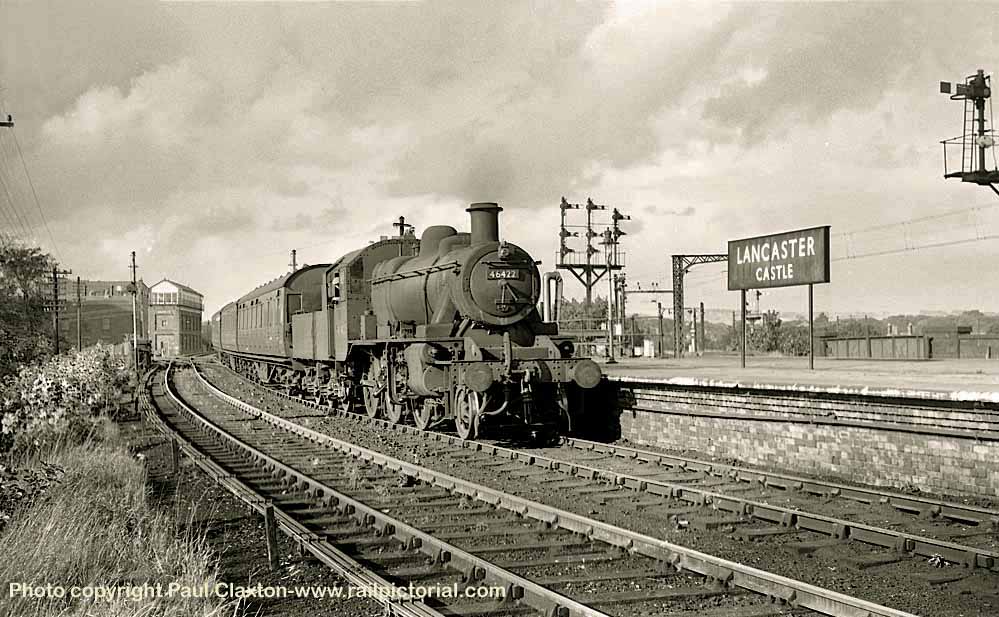
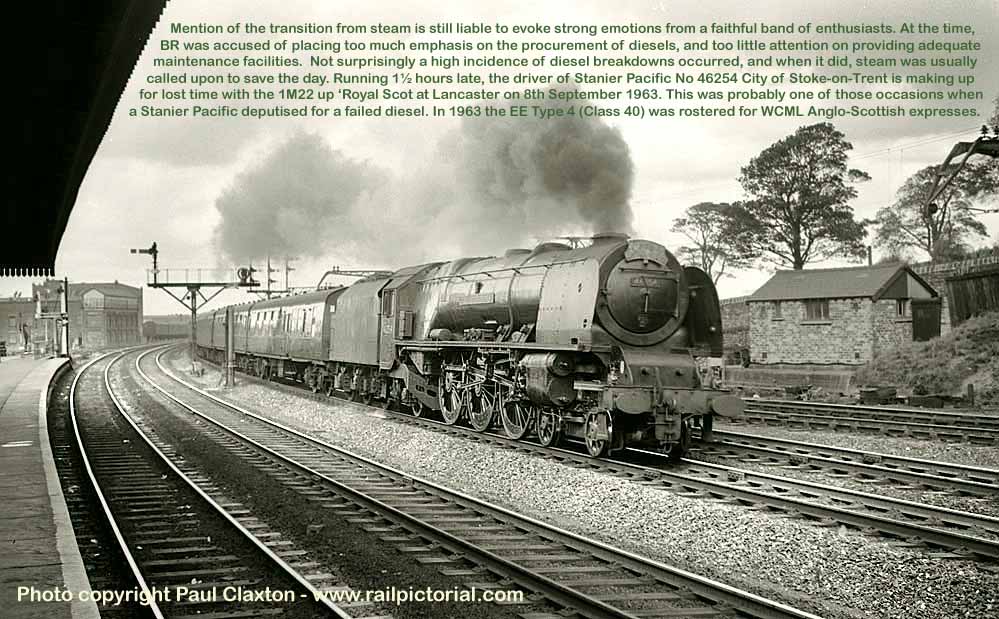
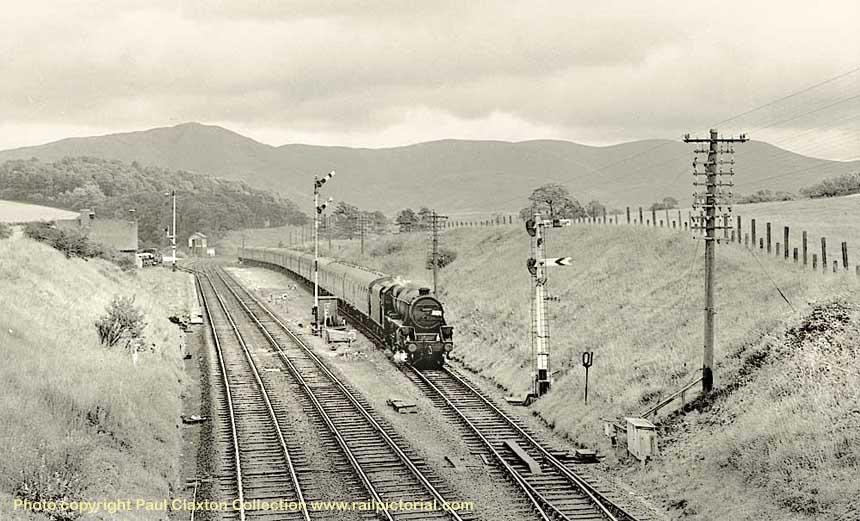
(Above-Inset) There are those with fallible memories who believe that station closures are exclusive to Beeching. Not so! Between 1948 and 1955 (from nationalisation to the Modernisation Plan) the British Transport Commission (BTC) approved the closure of 100 passenger services and 324 stations, including Grayrigg on the West Coast Main Line between Oxenholme and Tebay which closed on 1st February 1954. The station had two platforms, a signal box to the north and a station master's house. The goods yard had a weighing machine and a coal yard. The station house still survives, but following completion of WCML
 electrification the abandoned platforms have been demolished and a supply sub-station is located here. An unidentified 'Black' stands in the up passing loop (above) awaiting the passage of Fairburn 2-6-4T 42105 (left) with the details ref:
electrification the abandoned platforms have been demolished and a supply sub-station is located here. An unidentified 'Black' stands in the up passing loop (above) awaiting the passage of Fairburn 2-6-4T 42105 (left) with the details ref:These shots remind me of comments made by Ivo Peters in his book 'Somewhere Along the Line' published by OPC.
Most railway enthusiasts will be familiar with the Somerset and Dorset Joint Line through Ivo Peters' photos...for make no mistake, he covered every inch of the S&D! There is a chapter in his book in which he briefly describes how the Southern Region's S&D line was deliberately rundown after the Western Region gained a dominating control in 1958. The first ominous signs of the WR's intention to close the line came when goods traffic was diverted to other routes; this was followed by the rerouting of all through trains, including the 'Pines Express' away from the S&D.
Not surprisingly the happy atmosphere among staff changed to a mood of dejection and bitterness, not just because their line was about to close, but for the manner in which it was being done. A similar fate befell the Settle-Carlisle line in the 1980s but with a much happier ending...thank goodness! (see below).
With the S&D nearing the end in 1965, fellow cameraman Derek Cross, persuaded Ivo Peters to venture north to Westmorland, and in his book Ivo Peters states that with pending closure of the S&D no other stretch of line brought him greater pleasure than the seven miles of WCML from Grayrigg through the Lune Gorge to Tebay.
He writes - 'One location which attracted me greatly was at the western end of Grayrigg
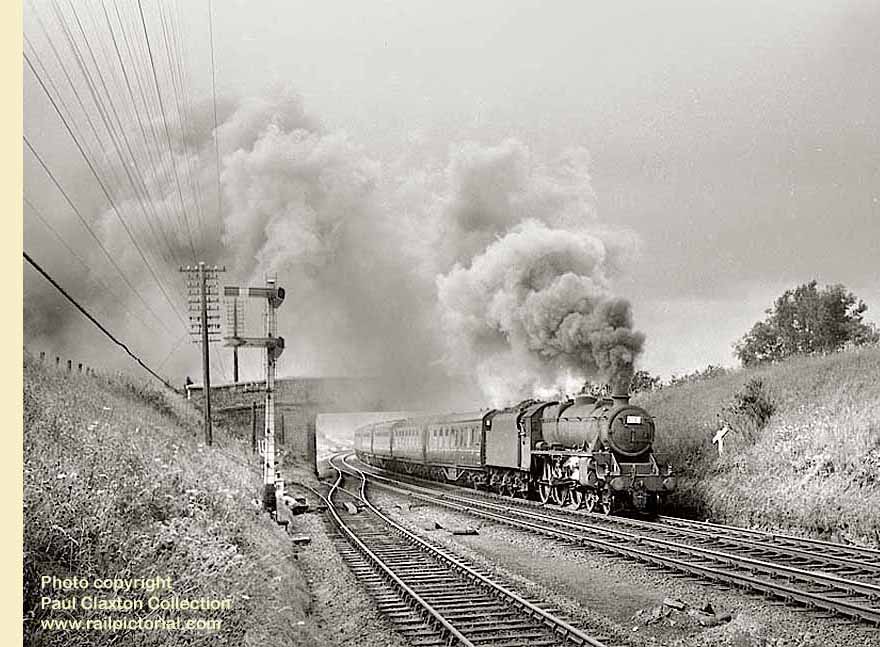 where a small overbridge crossed the line. I was enchanted by the scene from this spot, particularly on fine evenings when the distant fells stood out clear-cut in the background. Evening after evening I would end my day's photography standing on this small bridge. I have one sequence of 16mm colour film taken in dramatic evening light of a diesel-hauled express.
where a small overbridge crossed the line. I was enchanted by the scene from this spot, particularly on fine evenings when the distant fells stood out clear-cut in the background. Evening after evening I would end my day's photography standing on this small bridge. I have one sequence of 16mm colour film taken in dramatic evening light of a diesel-hauled express. Whenever I look at this piece of film I think how marvellous it must be to be a great artist like Terence Cuneo or David Shepherd who, with a wave of the wand - or rather, the paintbrush - would transform the diesel-hauled express of the 1960s into a 1924 train of LNWR 'plum and spilt milk' coaches hauled by a 'Claughton', just repainted in LMS red...'
(Inset-Below) Two powerful studies of 'Black 5s' on Grayrigg Bank - No 45324 storms to the summit at Grayrigg with the 1S35 Morecambe to Glasgow on 1 August 1964.
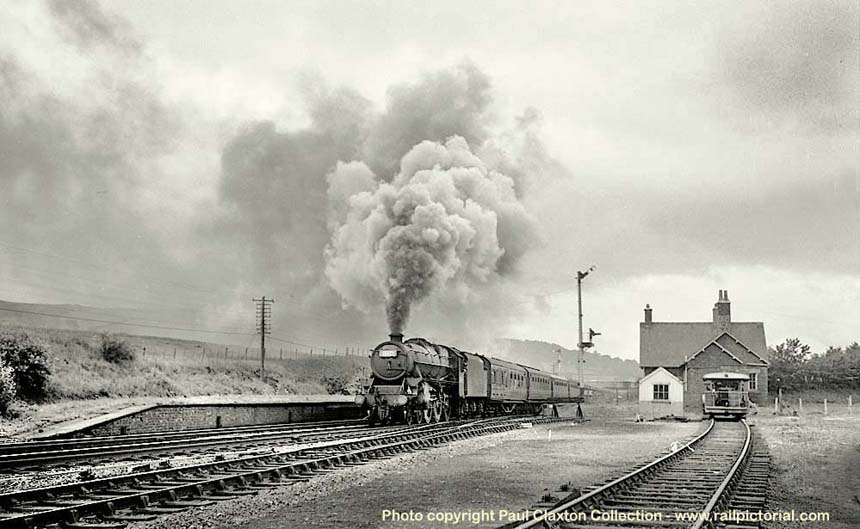
THE PAUL CLAXTON COLLECTION
The Lune Gorge
Mike Claxton's superb ww.railpictorial.com website is dedicated to the memory of his brother Paul, who sadly passed away in April, 2009. Paul started train spotting at a very early age, and like most young boys
 during the late 1950s he began taking railway photographs, a natural adjunct to train spotting.
during the late 1950s he began taking railway photographs, a natural adjunct to train spotting. Mike has created the website so that enthusiasts can enjoy his brother's remarkable photo collection online…and what a collection it is! There are just not enough accolades to describe the quality of Paul's photographs for his reconnaissance with a camera in the Lune Valley during the 1960s reminds me of my own visits to this lovely spot, except I didn't get anything quite like this! His photos simply take my breath away...
Needless to say, I'm a big fan and I'm sure you will be too after you've visited the LMR pages on the site here. However, I would strongly suggest you 'bookmark' it or mark it a 'favourite'. I'm saying this because there are over 7,800 images - a lot to absorb in one visit, and I fear you might get lost in a twilight world of nostalgia and never come back!
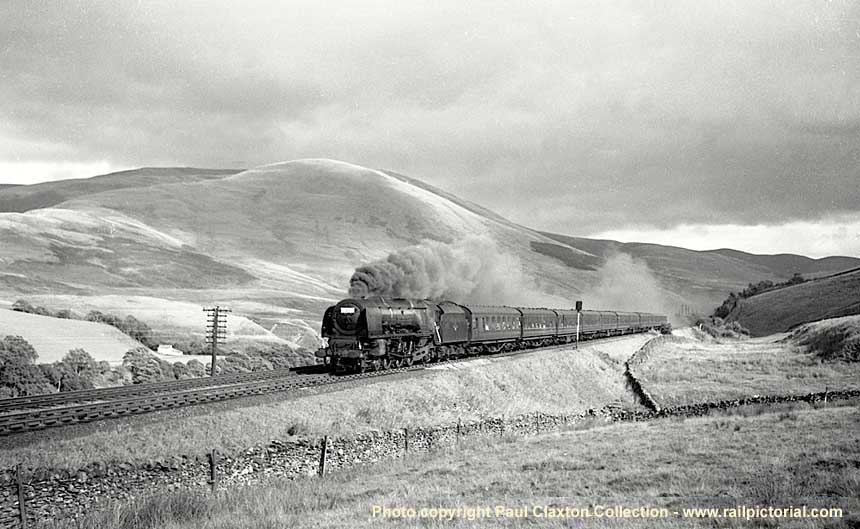
(Above) Stanier 'Duchess' class Pacific No 46254 City of Stoke-on-Trent heads a Euston-Glasgow express through the Lune Gorge on 1 August 1964.
Historically the gorge has provided a vital transport link since Roman times. Surrounded by the broad northern flank of the Howgill Fells and the Birbeck Fells to the west, this dramatic valley was considered the natural choice of a route for the London and North Western Railway's Lancaster to Carlisle line. At the time, the company's most eminent early civil engineers were Robert Stephenson and Joseph Locke, albeit both men had very different ideas on how to build a railway; Stephenson's preference was based on the premise that the shortest distance between two points was a straight line, and as a result several impressive memorials in one form or other still remain today, most notably the bridges he built on the line from Chester to Holyhead.
(Below) Royal Scot class 46128 The Lovat Scouts heads the 1M30 Glasgow to Liverpool relief on 13 July 1963.

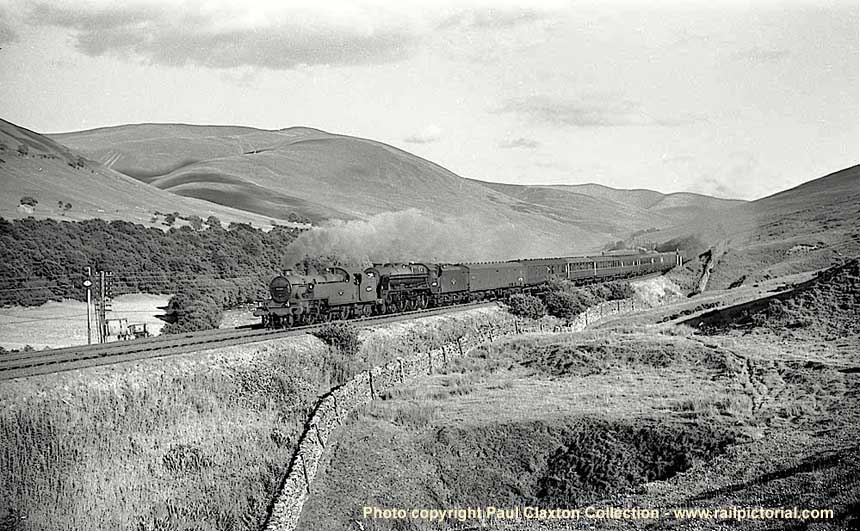
(Above) Fowler 2-6-4T No 42319 pilots Rebuilt 'Patriot' class No 45530 Sir Frank Ree on the 1S80 London to Glasgow on 13 July 1963. The provision of a pilot engine, or double-heading a train between Oxenholme
 and Shap, is mentioned in Derek Cross's book 'Roaming the West Coast Rails', in which he writes - 'Put a sock on it' was the local term for a train that was piloted from Oxenholme to Shap Summit. The origin of the term is wrapped in mystery but knowing the railwaymen of the district it is probably rude!'
and Shap, is mentioned in Derek Cross's book 'Roaming the West Coast Rails', in which he writes - 'Put a sock on it' was the local term for a train that was piloted from Oxenholme to Shap Summit. The origin of the term is wrapped in mystery but knowing the railwaymen of the district it is probably rude!' When Joseph Locke was appointed engineer of the Lancaster to Carlisle line, he was faced with an uphill task (quite literally) of getting the line over the northern fells. Several routes were considered, including the present-day route along the flank of the hills east of Kendal into the Lune Gorge as far as Tebay, but at this point it was proposed to excavate a tunnel under Orton Scar into the Eden Valley near Appleby. Another option was via Kendal up Longlesdale, followed by a tunnel under the Gatescarth Pass and then along the shore of Haweswater to Penrith. But these proposals were rejected by Locke, who preferred using the natural contours of the landscape, rather than being mired in costly earthworks such as tunnels, even if this entailed longer distances or indeed stiffer gradients.
Nevertheless his choice for building a line over Shap was considered somewhat odd given the small size of locomotives at that time. In steam days, a train climbing the four mile gradient at 1 in 75 to Shap summit required about a half a ton of coal and 750 gallons of water, and since all heavy trains required assistance up the bank, the company would have to provide a stabling point for banking engines, which is how the railway hamlet of Tebay was born.
(Below) The now-preserved 'Royal Scot' class 4-6-0 No 46115 Scots Guardsman heads the 1M31 Aberdeen-Manchester through the Lune Gorge on 13 July 1963.
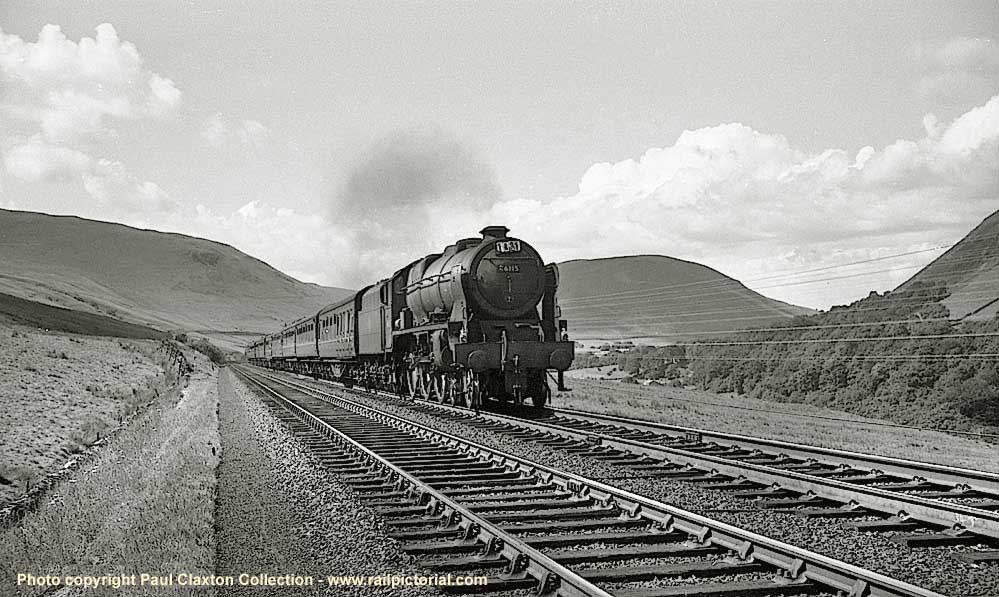
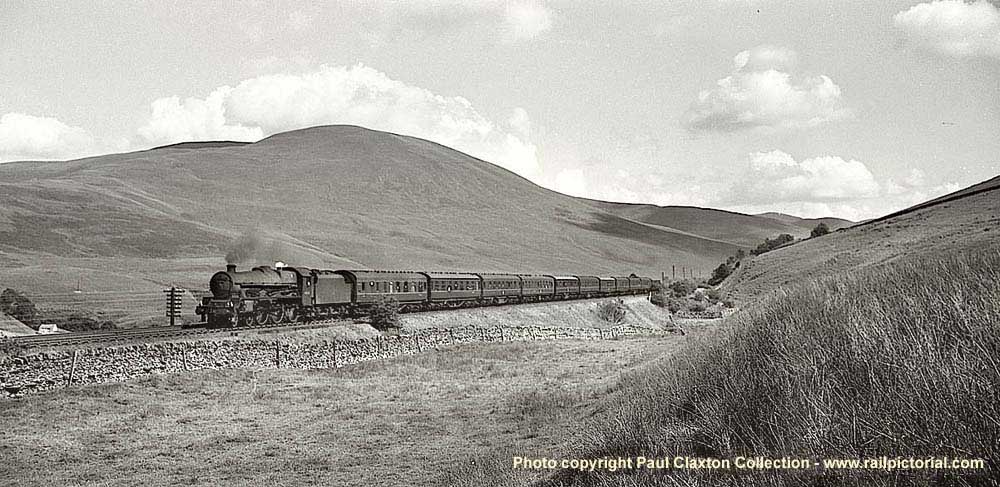
(Above) With the rounded mass of Blease Fell dominating the background, 'Jubilee' class No 45601 British Guiana heads the 1S71 Manchester to Glasgow on 13 July 1963.
Of course, the scenery is what made Tebay such an attraction for photographers...the hustle and bustle of the steam shed, the 'whistling up' of banking engines in readiness for the assault of Shap, but for many photographers, the spectacular scenery to be found in the Lune Gorge was the biggest draw of all.
Indeed before the M6 Motorway arrived, the Lune Gorge south of Tebay was widely regarded as the most beautiful stretch of the West Coast Main Line. The gorge cleaves through a geological fault line in the band of hills connecting the Cumbrian Lake District fells to the west with the Pennine hills to the east.
Alas the motorway has completely ruined the peace and tranquillity of the valley. Okay it may have created opportunities in relation to tourism and economic development, but if you take into consideration its huge scale (six lanes of constant moving traffic - plus the amount of noise associated with it) well, it's just not the same anymore. I suppose one has to accept that progress comes at a price!
(Below) This splendid panoramic view of the valley shows 'Black 5' No 45323 heading a lengthy freight on 13 July 1963.

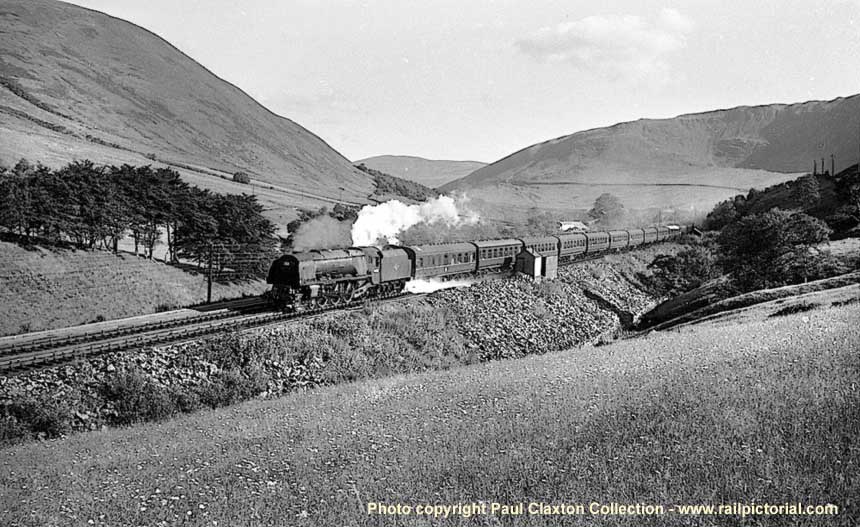
(Above) Stanier 'Duchess' No 46238 City of Carlisle skims over Dillicar troughs with a northbound train.
After the climb north from Oxenholme to the first summit of Grayrigg Bank, the line then heads more or less on a level course through Low Gill into the Lune Gorge, but unlike the new motorway which follows the contours of the valley, Joseph Locke laid a mile of straight track, known to footplatemen as the 'Fair Mile'. A sweeping curve at the northern end heads towards Dillicar water troughs, which for sheer splendour had a setting without parallel anywhere in the British Isles. This length of track was well known to serious students of railway photography, with trains picking up water at high speed following the descent from Shap or making a charge for the bank at full throttle.
(Below) 46245 City of London splashes over Dillicar troughs with the northbound Lakes Express on 13 July 1963.

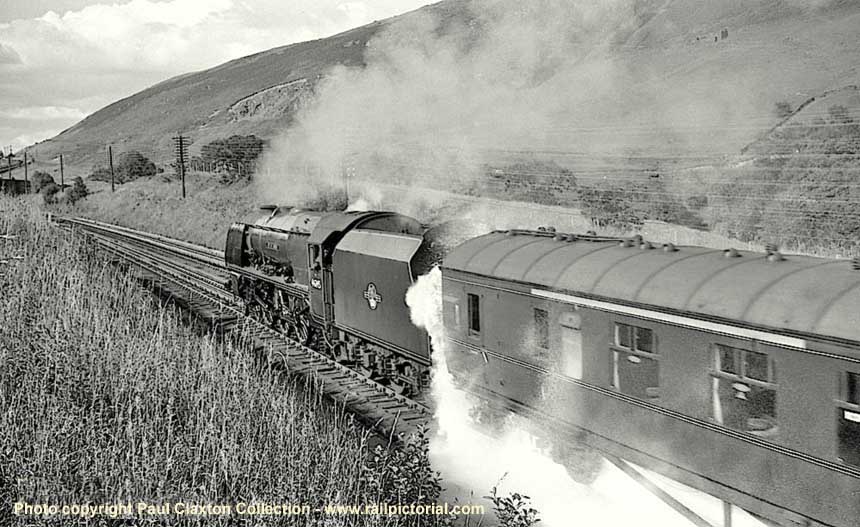
(Above) This is the obligatory 'going way' shot that serious rail cameramen felt compelled to take during steam days, though rarely did we to get anything quite like this! The firemen will be furiously winding up the scoop as water cascades down the side and in all probability filling up the corridor of the leading coach too judging by the open window!
Paul's first camera was a Kodak Brownie 127 in the late 1950s, but this was quickly replaced by a Zeiss Ikon Nettar 120 rollfilm camera followed by a Kodak Retinette 1B 35mm in 1961. He acquired a Pentax S1A in 1965 and by the late 1970s he'd graduated to a Nikon F (35mm) and a Pentax 6X7 (Medium Format), albeit too late for BR mainline steam which ended in 1968, but ideal for recording most preserved railways and steam specials on the main line.
(Below) Paul was taking something of a risk here! Trackside photography in close proximity to water troughs was just asking for trouble, but as luck would have it this 'Jubilee' class 45613 Kenya is picking up water in a more sedate fashion, otherwise his newly acquired Kodak Retinette 1B would have been on the receiving end of a good drenching!
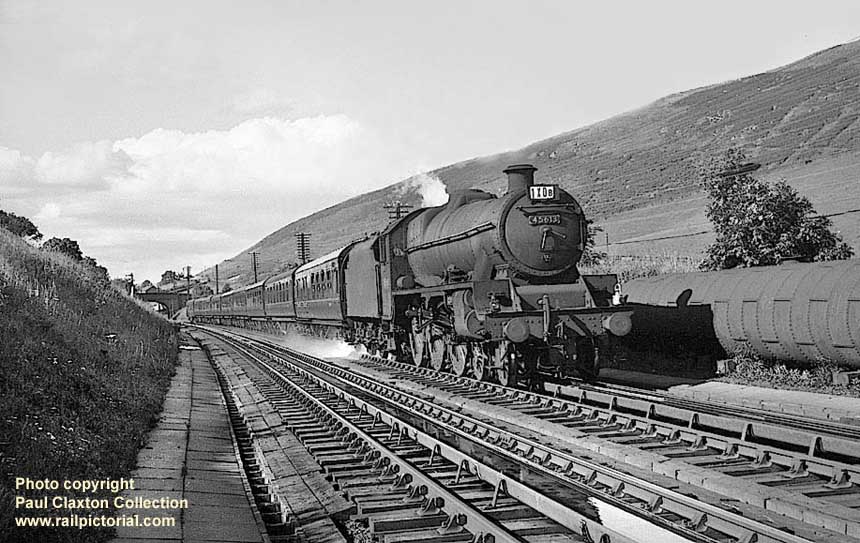
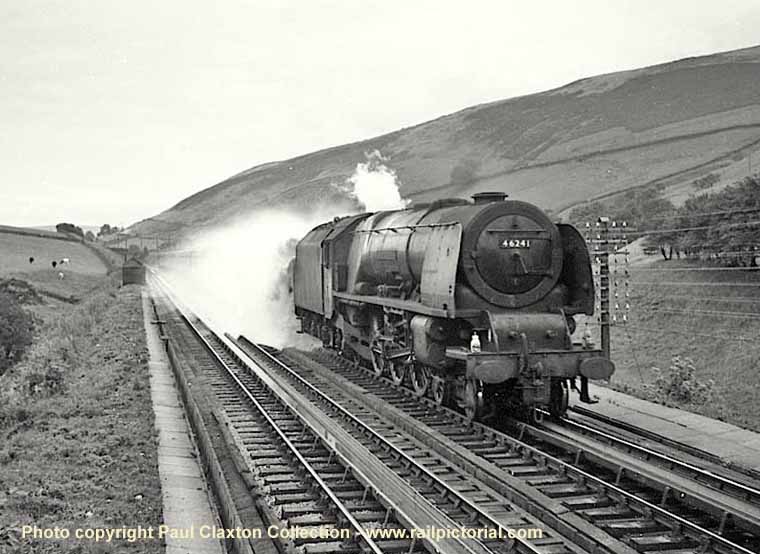
(Above-Below) Not so lucky in this case, though! Stanier Pacific 46241 City of Edinburgh is about to give Paul a good soaking as it heads the 1M37 12.20 Perth-Euston on 6 September 1963. (Below) Leaving the gorge at Low Gill an unidentified 'Britannia' heads the 1M21 Saturday Glasgow-Blackpool at Low Gill; the banner signal shows the route is set for the main line, the lower banner indicates the junction with the Ingleton Branch. The opening of the MR Settle-Carlisle line relegated this North Western Railway route to the main line that never was; it ran from Clapham Junction through Ingleton, Kirkby Lonsdale, Barbon, Middleton-on-Lune and Sedbergh before joining the West Coast main line at Low Gill. Passenger services ceased on 30th January 1954, but the line remained open until 1967.
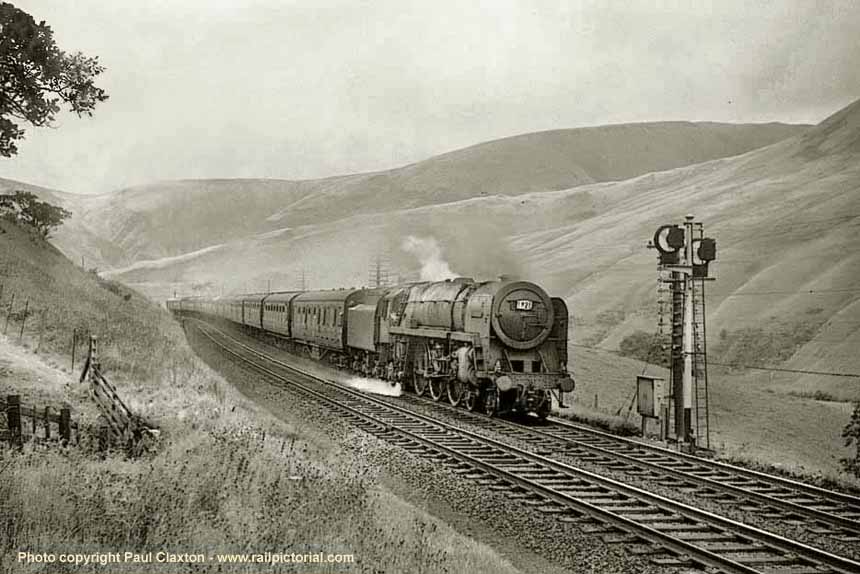
To give credit where it is due, Mike Claxton has worked hard in creating this website for the simple reason that it gives enthusiasts a chance to enjoy his late brother's photographic collection online. It is an enormous task, and with only one pair of hands and not enough hours in a day, it will take some time before it is complete...nevertheless a visit is a must! However, should you download copies of any of Paul's photographs from this page then it would be appreciated if you would make a donation to the Trinity House Hospice, Blackpool who cared for Paul in his fight against cancer. A click-on link is available here...it only takes a couple of minutes!
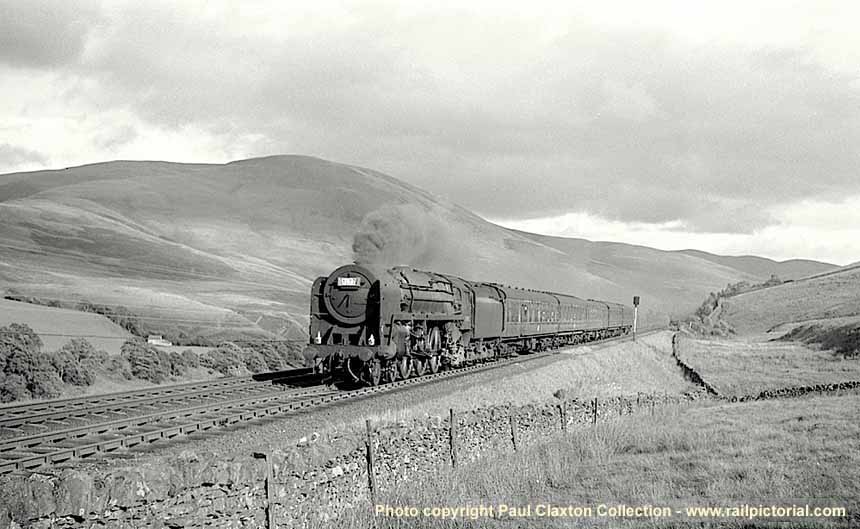
TODAY'S DISPOSABLE SOCIETY
As each day passes I seem to be turning more and more into Roy Crocker from Coronation Street. I even have my own shopping bag. Okay, a straw bag is hardly the most sought-after fashion accessory and it has seen better days I grant you that, but I've stuck with it right to end...right up to the handle straps giving way and I dumped it in the bin.
 At my local supermarket, however, a holier-than-thou checkout girl had her own ideas as to why I hadn't brought my own grocery bag. This is the same girl I encountered only a few days earlier when she overcharged me 25p for a pack of cheese slices and I had the affrontery to point out the mistake.
At my local supermarket, however, a holier-than-thou checkout girl had her own ideas as to why I hadn't brought my own grocery bag. This is the same girl I encountered only a few days earlier when she overcharged me 25p for a pack of cheese slices and I had the affrontery to point out the mistake.'I suppose you now want a bag!' she said accusingly.
Before I had chance to explain she launched into a lesson on conservation - 'Don't you know that plastic bags are bad for the environment?'
'Yes I do,' I replied.
'Then why haven't you brought a bag with you? That's the problem with your lot; you don't care about saving our environment for future generations.'
Oh dear...isn't it disheartening how today's smartass kids have so little regard for the feelings of old folk...or perhaps I should say - wasteful older folk?
She had probably learned something about the 'Green Issue' at school and quite rightly she was concerned about the mountainous heap of household rubbish rotting away in landfill sites; indeed the subject of recycling has become an important part of everyday life and we should all be worried, but she was dead wrong about whom to blame.
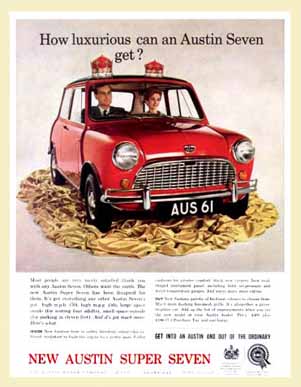 You see our generation recycled everything in the old days; we put empty milk bottles on the doorstep for the milkman to collect; pop bottles were returned to the corner shop and beer bottles to the local pub, a chore usually carried out by children in return for keeping the deposit paid. The bottles were then sent to the plant to be washed, sterilized and refilled, and so the same bottles were used over and over again.
You see our generation recycled everything in the old days; we put empty milk bottles on the doorstep for the milkman to collect; pop bottles were returned to the corner shop and beer bottles to the local pub, a chore usually carried out by children in return for keeping the deposit paid. The bottles were then sent to the plant to be washed, sterilized and refilled, and so the same bottles were used over and over again. The same can be said for the local shopkeeper who bagged our groceries in biodegradable brown paper bags; the bags not only offered a practical solution in disposing of household garbage, they had several other uses too such as covering our favourite books to ensure they lasted longer, or for protecting the fragile contents of a parcel to be sent by mail...surely this is much better for the environment than some new-fangled non-biodegradable Styrofoam or plastic bubble wrap.
In those days the kids got hand-me-down clothes from an older brother or sister, we took shoes to the cobbler for new soles and heels, and the kitchen had no electric gadgets like toasters, can openers, blenders, dish washers, fridges, freezers or 850W microwaves, and because mums' didn't have the luxury of a washing machine, the clothes
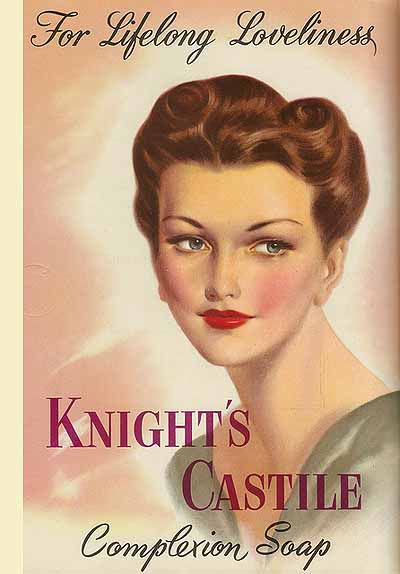 were hand-washed and then hung out to dry on a clothes line, not in some energy-gobbling washer-tumbler drier burning up 240 volts supplied by our beleaguered national grid; indeed wind power really did dry our clothes in the early days.
were hand-washed and then hung out to dry on a clothes line, not in some energy-gobbling washer-tumbler drier burning up 240 volts supplied by our beleaguered national grid; indeed wind power really did dry our clothes in the early days. We had one electrical socket in a room, not an entire bank to power up a dozen or more appliances and gadgets in every room, and the idea of plugging a lawn mower into the mains or firing up a petrol engine to cut the grass would have been laughable. The lawn mower was operated by human power. In fact the daily routine for the whole family burned up enough calories without any need to diet, lift weights or exercise on some new-fangled apparatus at a health club.
At school we refilled pens with ink and at morning playtime we drank free milk delivered in glass bottles with tinfoil tops; people travelled on trams, trains and buses, and the kids legged it to school without the need of a lift by parents in a gas-guzzling 300hp machine. And we didn't need a computer to track a signal from satellites 2,000 miles out in space in order to locate the nearest takeaway delivering fast food in non-recyclable plastic containers.
So, smartass checkout girl, when it comes to recycling and energy saving activities, there is a lot you could learn from my generation...
Indeed if we could turn the clock back and give the younger generation a taste of what life was really like in the old days, then I'm sure the world would be a lot better place for it.
OUT WITH THE OLD...IN WITH THE NEW
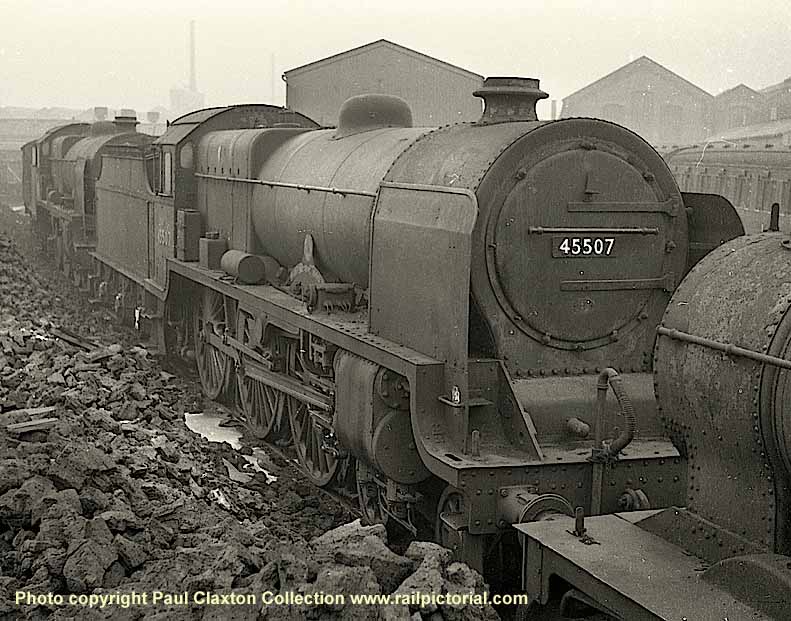
(Above) Out with the old...built at Crewe in August 1932, the sad sight of 'Patriot' class No 45507 Royal Tank Corps, withdrawn from traffic in October 1962, awaiting its fate at Horwich on 27 January 1963. Although no Patriot in either rebuilt or original Fowler designed parallel boiler forms have survived into preservation a new 'Patriot' is under construction at the Llangollen Railway. The LMS-Patriot Project is building a new 3-cylinder parallel boiler 4-6-0 that will be named 'The Unknown Warrior'. Click here to visit the site.
The first BR Region to officially abandon steam was the Western Region in January 1966. This was followed by the Scottish Region (ScR) in June 1967, the Southern Region came next in July 1967 and the Eastern Region in November 1967.
By the end of the year, such had been BR's haste in ditching its trusty fleet of steam workhorses it was almost impossible to keep tabs on the number of withdrawals. It began in 1960 with the scrapping of the ex-LNER Class B17 4-6-0s and LTSR 4-4-2Ts. The following year all the ex-LNER 4-4-0 'Hunt' and 'Shires' had gone; in 1962 the SR 'Schools' Class 4-4-0s, 'Lord Nelson' 4-6-0s and N15 4-6-0s became extinct, and on the Western Region the demise of the once-proud 'Kings' came as a grim warning of what was about to come. Sure enough, in 1964 it was the turn of the mighty ex-LMS Pacifics to be scrapped, followed in 1965 by the 'Patriots' and 'Royal Scots' and by the end of the year the Western Region had abandoned all its ex-GWR 4-6-0s 'Castles', 'Halls' and 'Granges. Another shock came in 1966 when Gresley's famous ex-LNER Class 'A' Pacifics and Class V2 2-6-2s bit the dust. In 1967, the last ex-SR Bulleid Pacific disappeared along with the ex-LMS 'Jubilees'; in that same year the K1 2-6-0s, Q6 0-8-0s, J27 0-6-0s and B1 4-6-0s had gone along with the last ex-LMS Stanier and Fairburn 2-6-4Ts...it was like saying goodbye to an old friend.
(Below) And in with the new! Another product of Crewe, but yet to turn a wheel in revenue-earning service is Type 4 'Peak' class D54 (TOPS Class 45/0 No 45023) was photographed at the works on 22 July 1962. Later named 45023 The Royal Pioneer Corps, the loco was withdrawn in September 1984 and scrapped at Vic Berry's Leicester yard in October 1986.
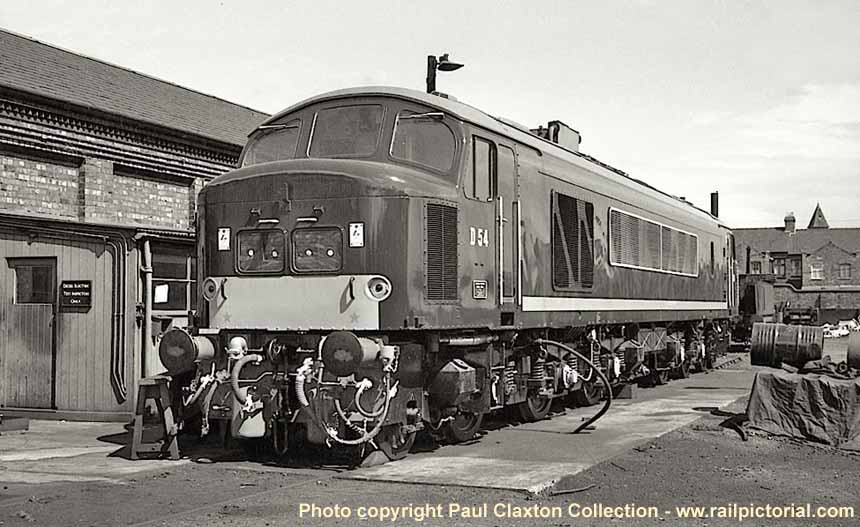
THE LONG DRAG IN THE SIXTIES
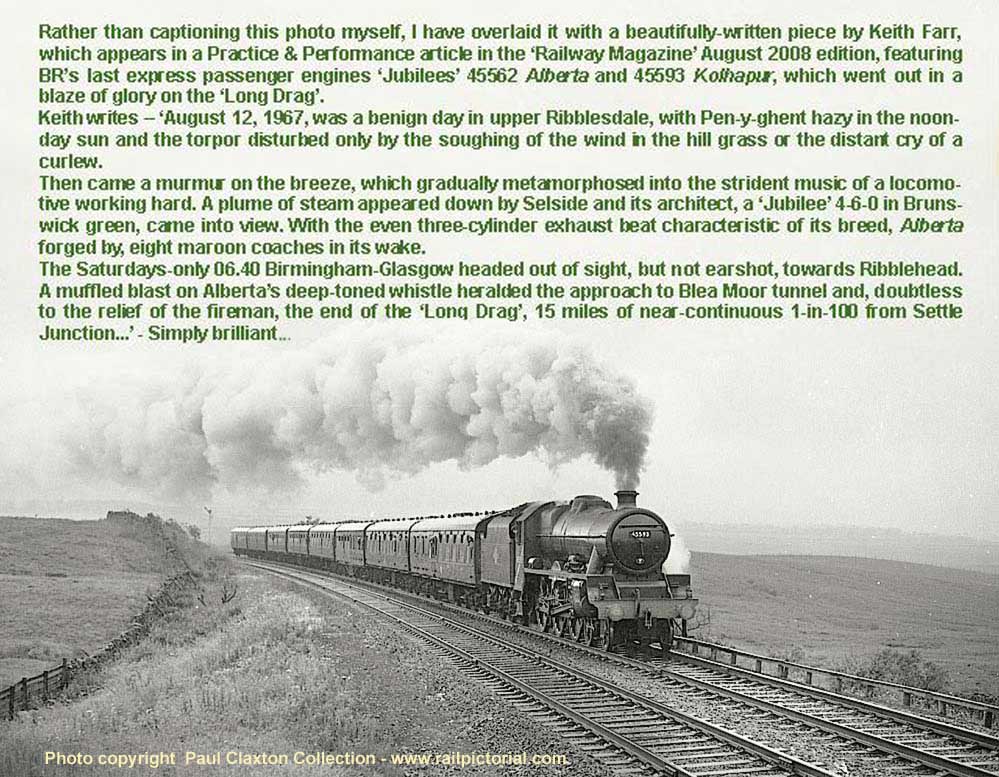
Needless to say, the locomotive classes I mention earlier are just a few of those to end their days as a pile of scrap; there were numerous BR Standard class locomotives, which, in spite of their recent construction, had relatively short lives, some ending their days with less than seven years in service..
By January 1st 1968 a measly 350 or so locomotives remained, mostly in a dire state of disrepair...and, not surprisingly, many railway photographers - tiring of the lacklustre steam scene - hung up their cameras, and this including me, only I'm ashamed to say my allegiance caved in early doors (1964). I simply hadn't the stomach for it anymore.
But luckily there were sufficient numbers who stuck with it right to the bitter end, including Paul whose shots of steam's final fling in the northern fells are superb; indeed the last rites of steam fell to the London Midland Region based in the North-West of England, which, contrary to popular belief, is not all cobbled streets, back-to-back housing and blokes in flat caps stuffing ferrets down trousers! I'm talking here about an area embracing the most scenic and rugged landscapes to be found anywhere in Britain. This gave the few remaining steam locomotives the chance to eke out their final days with at least some panache and style. At the same time, drivers often played up to the gallery and engaged in some unofficial high speeds to show what the old steam workhorse could still do!
Steam railway cameramen like Paul couldn't have wished for anything better than photographing steam battling with the gradients in the northern fells. Perhaps it came second best to the glorious days they had enjoyed before the dastardly Beeching ripped the heart out of the railway network. But no matter how long
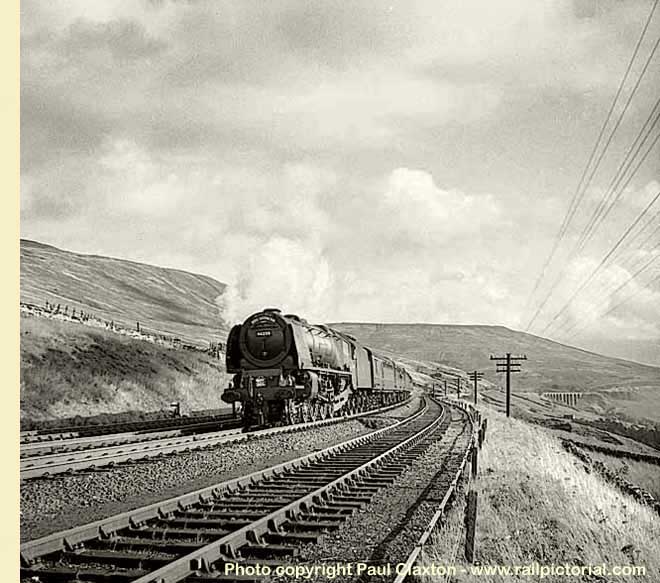 ago it all now seems, the physical features associated with the routes across the Pennines still ring with famous names today - Stainmore, Peak Forest, Standedge, Whitrope, Copy Pit, Woodhead and of course the Settle & Carlisle - known colloquially as the 'Long Drag' since much of it climbs at 1 in 100 from Settle Junction to Blea Moor Tunnel then onwards to the summit of 1,169ft above sea level at Ais Gill.
ago it all now seems, the physical features associated with the routes across the Pennines still ring with famous names today - Stainmore, Peak Forest, Standedge, Whitrope, Copy Pit, Woodhead and of course the Settle & Carlisle - known colloquially as the 'Long Drag' since much of it climbs at 1 in 100 from Settle Junction to Blea Moor Tunnel then onwards to the summit of 1,169ft above sea level at Ais Gill. This main line remains one of astounding beauty, surrounded by the brooding contours of Pen-y-ghent, Whernside, Inglebrough and Wild Boar Fell plus the sweeping vista of Dentdale and the wild moorland tops of Ribblehead.
Paul captured it all; here are just a few more examples of the way it was...
(Above Right) One of the biggest events of 1963 was the marathon 'North Eastern Rail Tour' organised by the Stephenson Locomotive Society and RCTCS over a five-day period from 27 September to 1 October. Starting from York, the first leg was routed via Foss Island; Hallfield Road Junction; Dunnington; Cliff Common; Balby North; Selby; Thorpe Gates; Gascoigne Wood; Sherburn South; Church Fenton; Tadcaster; Newton Kyme; Wetherby; Spofforth; Crimple; Brunswick Junction; Harrogate; Arthington Junction; Pool-in-Wharfdale; Otley; Milnerwood Junction; Burley Junction; Ben Rhydding; Ikley; Bolton Abbey; Skipton; Hellifield; Settle Junction; Petteril Bridge Junction; Carlisle; Brampton; Haltwhistle; Alston; Hexham; Riding Mill; North Wylam; Scotswood, ending the day at Newcastle Central.
Details of the
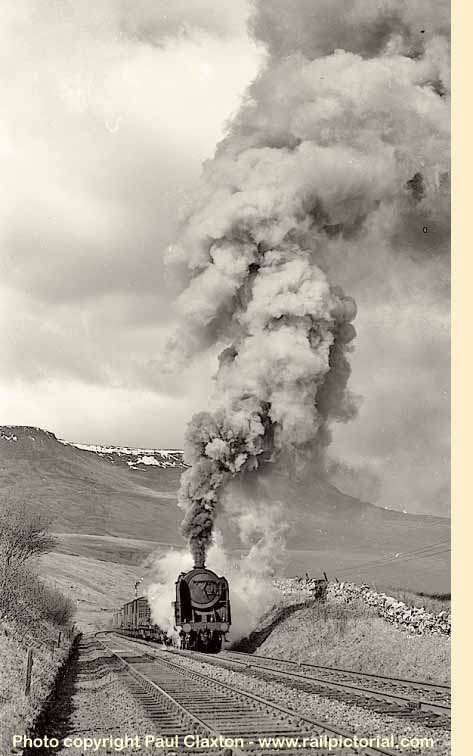 rest of the tour are to be found on the excellent 'Six Bells Junction' website here; if you have never used this site before, simply select the year...in this instance 1963...and scroll down to the date...27 September 1963. Well worth a visit! Here Paul captures No 46238 City of Carlisle high in the fells at Dent; the Stanier Pacific was responsible for hauling the leg from Skipton to Carlisle. No fewer than fifteen steam locos were used over the five days.
rest of the tour are to be found on the excellent 'Six Bells Junction' website here; if you have never used this site before, simply select the year...in this instance 1963...and scroll down to the date...27 September 1963. Well worth a visit! Here Paul captures No 46238 City of Carlisle high in the fells at Dent; the Stanier Pacific was responsible for hauling the leg from Skipton to Carlisle. No fewer than fifteen steam locos were used over the five days. (Left) This breathtaking shot of a hard working Class 7MT 'Britannia' No 70048 The Territorial Army 1908-1958 battling the grade to Ais Gill summit on 18 March 1967 could well be titled the 'Power and the Glory', though I suspect the engine crew might have another name for it! By 1967 BR's steam fleet was in a poor shape; indeed apart from the Southern Region's Bulleid machines the BR Standard Class 7MTs were the only Pacifics left in BR Service in 1967. Kingmoor shed at Carlisle was the final outpost of the class, and all except six found a home there at one time or another in their final years. Following the spread of dieselisation the locos were transferred in a succession of batches as they became redundant at the various depots. At the start of 1967 forty two 'Britannias' remained in service but as withdrawals gathered pace only thirteen survived up to the December 1967 deadline at Carlisle Kingmoor. However, No 70048 was a relatively early candidate for withdrawal (May 1967) just two months after Paul's photo was taken.
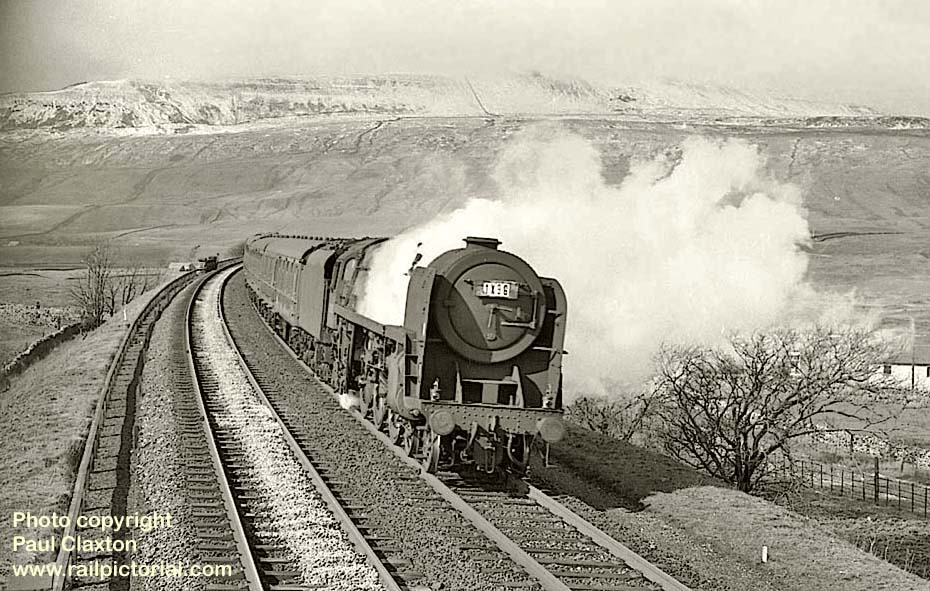
(Above) 'Britannia' Class 7MT 70053 Moray Firth faired a little better than 70048; withdrawal came in April 1967 - and not before time, judging by Paul's shot at Ribblead. Seemingly leaking steam from every orifice, 70053 heads an up Special on 23 March 1967. For the record, the shed at Kingmoor officially closed to steam on New Year's Day 1968 to be replaced by a new diesel depot.
(Below) The view from Blea Moor Sidings signalbox of 'Jubilee' class No 45697 Achilies at the head of the 1S43 LEC to Gourrock at Blea Moor on 7th August 1965. The details of all the captions are derived from Paul's notes, but in this particular case neither Mike nor I know what the abbreviation 'LEC' is...though I'm reliably informed that in the 1959 Working Timetable, there was a Leeds to Gourock train via Bradford Forster Square (departing BFS 09.35) summer Saturdays only. Perhaps LEC might stand for Leeds City? Maybe it still ran in 1965?
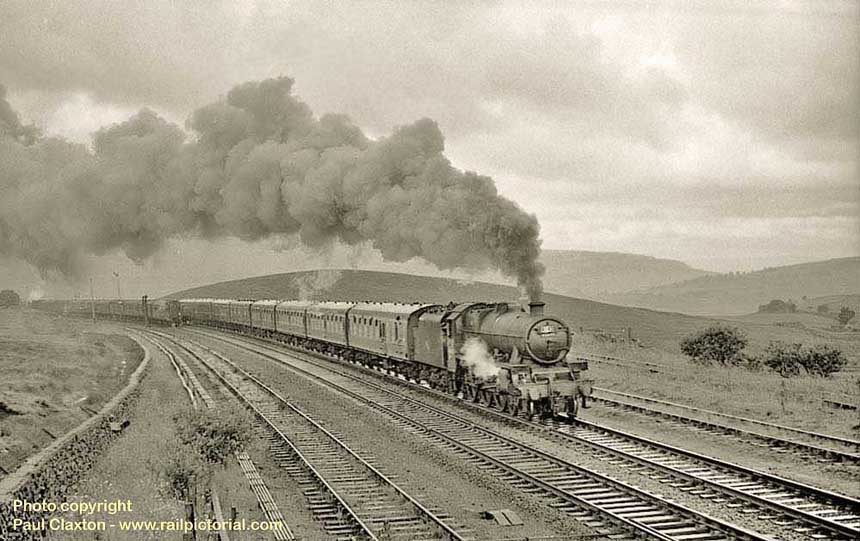

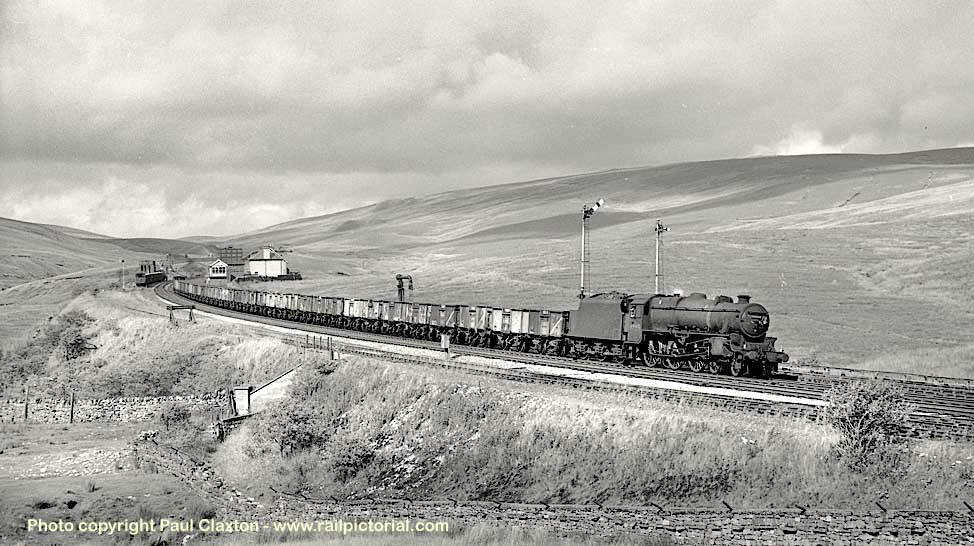
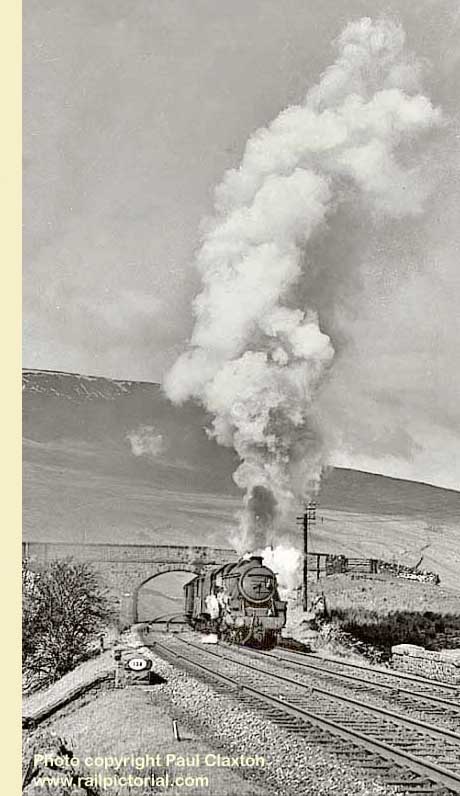 (Above-Right) An unidentified 'Black 5' heads south with train of empties at Blea Moor in August 1965.
(Above-Right) An unidentified 'Black 5' heads south with train of empties at Blea Moor in August 1965. The isolation of Blea Moor Sidings and Batty Moss Viaduct conveys something of the gigantic task facing the Midland Railway in 1869 when the company began construction of the magnificent Settle-Carlisle line. The 72 mile route includes 17 major viaducts and 14 tunnels, and is a superb example of 19th Century engineering, but its construction came at great cost.
It is hard to imagine that Paul Claxton's panoramic shots of Blea Moor Sidings and Ribblehead can be the same bare landscape where more than 2,000 immigrant workers (navvies) and their families lived in squalid conditions in Batty Moss shanty towns - Sebastapol, Inkerman and Jericho - where accidents were frequent and an Isolation Hospital was built to contain outbreaks of smallpox. The graveyard at Chapel le Dale bears testimony to the men who lost their lives.
Fast-forward to 1980, however, and the first rumours about closure of the line began to circulate. Doubts were raised when BR diverted all Anglo-Scottish traffic using the Settle-Carlisle line to other routes leaving only a modicum of freight, together with two daily passenger services in each direction to form the line's regular service. This was proof in itself that BR had deliberately reduced the level of traffic in order to relegate its importance as a major Anglo-Scottish route. In August 1983 the rumour of closure was confirmed; the blunt disclosure by BR of the deterioration of the quarter mile-long Ribblehead viaduct was given as the main reason for closing the line; it was reported that the waterproof membrane protecting the stone piers had been damaged by more than a century of Pennine weather. BR civil engineers set about the task of installing a single, centrally positioned line to alleviate further stress cracking in the stonework; this work was coincident with track layout alterations at Blea Moor involving the removal of the 'down' siding and goods loop, whilst accompanying semaphores were replaced by single and multi-aspect signalling.
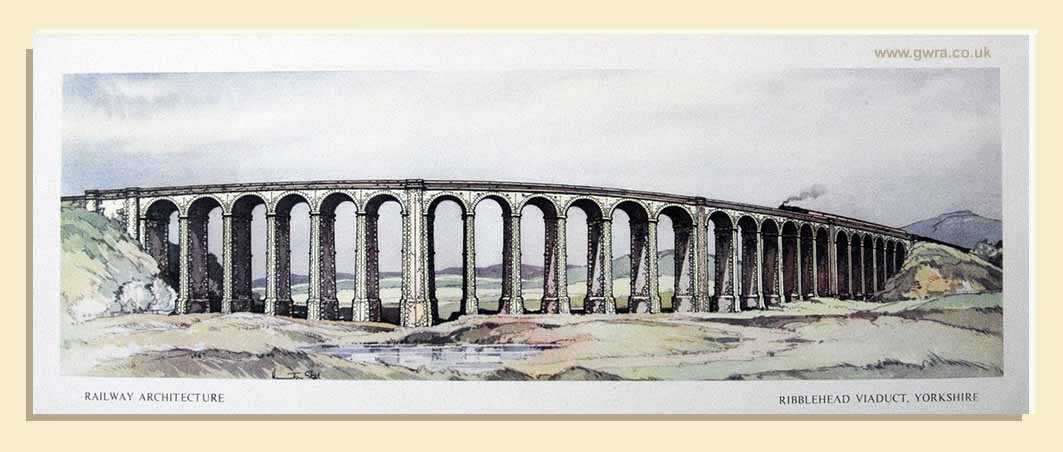
(Above-Below) A carriage print 'Ribblehead Viaduct, Yorkshire' by Kenneth Steel from the LMR Railway Architecture Series, went under the hammer for £60 at a Great Western Railwayana Auction in April 2015. (Below) Class 9F heads empty hoppers for Long Meg Sidings across Ribblehead Viaduct. The block trains of anhydrite from Long Meg mine to Widnes were a regular feature of the S&C together with the daily limestone traffic generated by the quarries in the Ribble Valley. More than 5 million tonnes of anhydrite (used in the manufacture of sulphuric acid and ammonium compounds for fertilizers) was extracted from the British Gypsum mine at Little Salkeld before closure came in January 1976. The company's redundant Barclay 0-4-0ST, once used for shunting between the mine and the junction with the Settle-Carlisle line now resides on the Bowes Railway in Tyne and Wear.


(Above) The signalman's view from the box at Ais Gill summit, located 1,169 feet above sea level and the highest main line railway summit in England, is a scene dominated by the backdrop of Wild Boar Fell rising to a peak of 2,324 feet above Mallerstang. Breasting the summit with a southbound freight, this unidentified 'Black 5' shows little evidence of having worked hard on the almost continuous 1 in 100 climb from Ormside between Appleby and Kikby Stephen. Both the 'up' and 'down' refuge sidings, once extensively used by the MR for detaching pilot engines, saw occasional use during the late Sixties, but today the scene is very different; the refuge siding have been lifted and the abandoned Type 2B Ais Gill Summit signal box, complete with 16 lever tumbler frame, found a new lease of life at Butterley station on the Midland Trust Railway in Derbyshire. The box was removed from Ais Gill summit in the autumn of 1982 and became operational at Butterley in September 1984.
(Below) A splendid shot of 'Jubilee' 45593 Kolhapur crossing Ribblehead viaduct with the Stephenson Locomotive Society's (Midland Area) 'Pennine Rail Tour' from Birmingham to Carlisle on 2nd October 1966. Departing Birmingham Snow Hill at 08.35am 'Black 5' No 45292 was in charge of the first leg via Wolverhampton Low Level and Bushbury Junction to Stafford, where Class 81 Bo-Bo E3010 continued the journey via Crewe to Stockport Edgeley. Class 7MT 'Britannia' 70004 William Shakespeare then continued via the Standedge route - Stalybridge, Micklehurst loop, Diggle and Huddersfield - to Leeds City. Holbeck's 'Jubilee' No 45593 Kolhapur departed Leeds City for the run over the Settle-Carlisle to Kingmoor and the return from Carlisle (a reverse of the outward route to Hellifield) then via Clitheroe, Blackburn, Bolton and Manchester Victoria to Stockport Edgeley. Class 86 Bo-Bo E3179 hooked on for the trip via Crewe to Stafford where EE Type 4 No D225 Lusitania took the final leg via Bushbury Junction and Wolverhampton High Level to Birmingham New Street, arriving there at 22.22pm...my thanks to the Six Bells Junction website for the information.
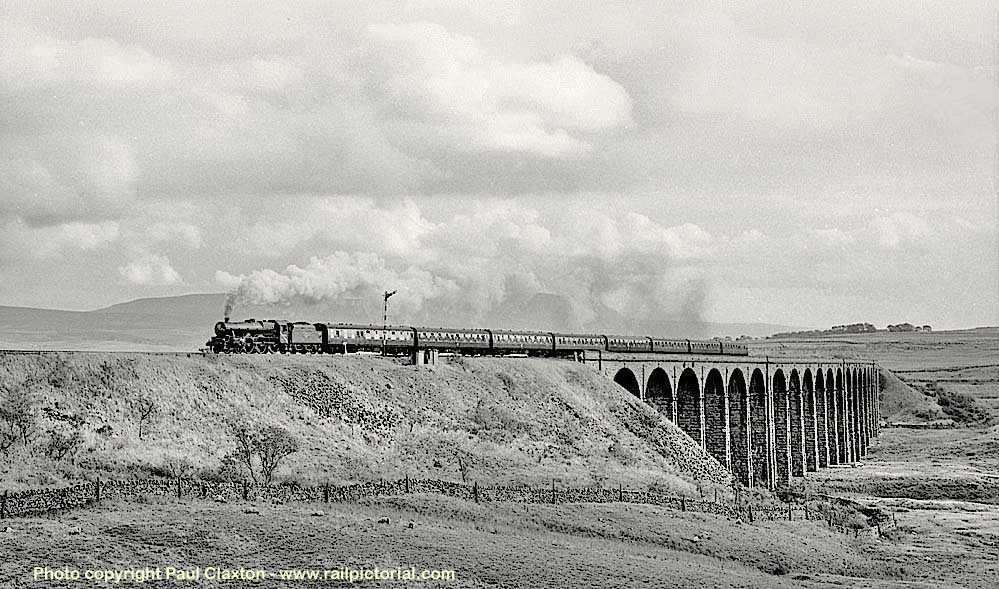

(Above) Paul captures the remoteness of the Settle & Carlisle line perfectly as 'Jubilee' class No 45660 Rooke heads the 1S67 St Pancras-Glasgow on the climb to Blea Moor Tunnel on 7 August 1965.
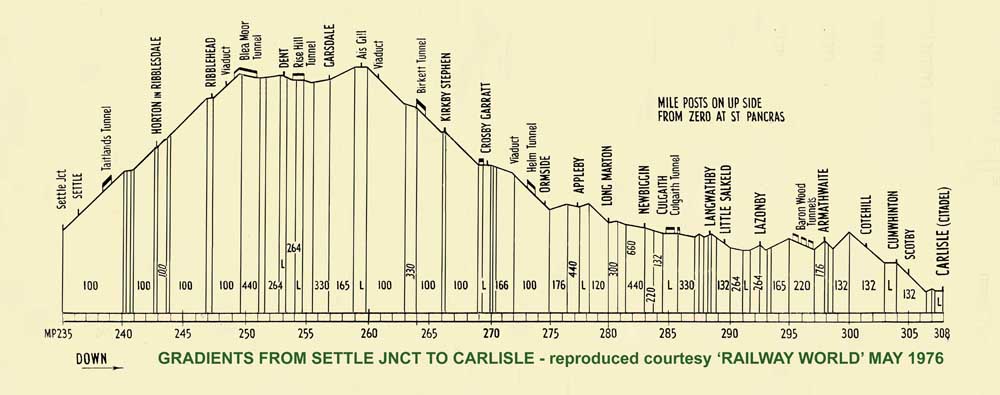
'Hi David, just found your site and had a good wallow in the past which brought back lots of fond memories. Got to reading your page about spotters and came upon the picture of the bored spotters at Crewe, which made me smile and then stare open mouthed as the one looking at his combined was my Uncle Geoff as a teenager. It was he who got me into train spotting and he later had a motorbike and took me to numerous engine sheds around Lancashire. He lived in Wigan with my grandparents and I would go and stay for weeks at a time and spot on the main London-Glasgow line. We lived in Blackpool at the time, so bizarrely I must be the only kid in history living in Blackpool who went for his holidays to Wigan!
When you think back to all the places we went spotting at only 11 or 12 years old and the freedom we had as kids it is hardly any wonder that as we all get older, each time there is a further curb on our freedom we want to start revolution and get even more crotchety.
I can recount the story of my first spotting adventure from Blackpool to Preston with my mate 'Martian Head' - aren't kids cruel! We joined my cousin and ended up at Crewe, where we were met by the Station Master in full regalia including top hat! All this at the age of eleven! It's no wonder a lot of our generation have a taste for travel, adventure and growing old disgracefully, I have no idea where it comes from.
And your story of sneaking into Holbeck Shed struck a chord also, as on another adventure we found ourselves in a similar predicament but being from Blackpool and perhaps a bit more street savvy - or maybe just luckier - we managed the whole shed before being chased off without injury and our pride almost intact!
I took my Grandsons to the station a couple of weeks ago to watch the trains and Princess Elizabeth steamed majestically through...you should have seen their faces, smiles from ear to ear, almost as big as Grandad's! Kind Regards, Ian Cook..'
SHAP BANK
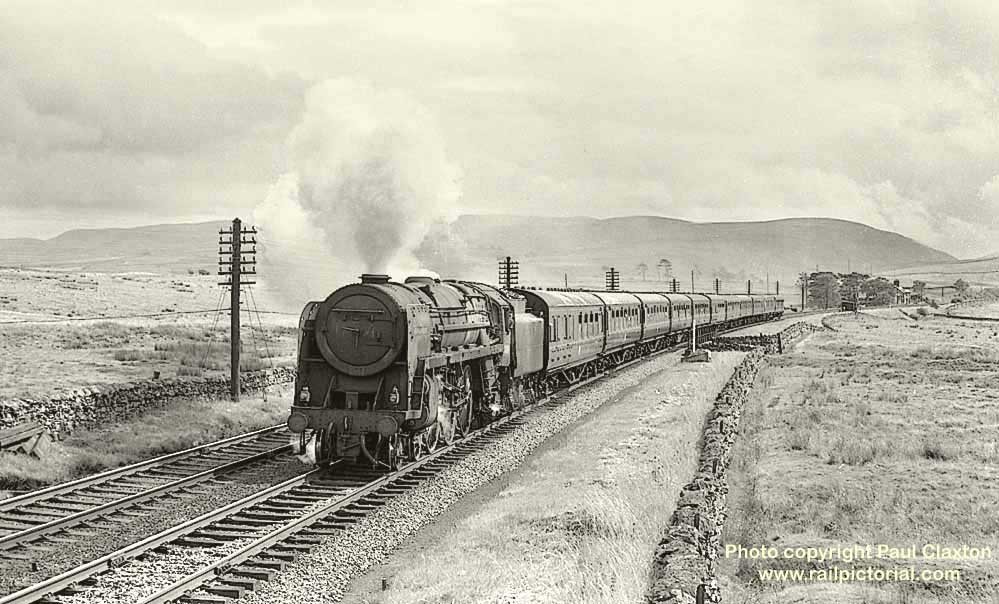
(Above-Below) Shap bank was arguably the most popular venue for railway photographers during steam days. Rising at a steady gradient of 1 in 75 the line reaches the summit at milepost 267½ - a distance of five
 miles from Tebay. These classic shots of BR Standard 'Britannia' 4-6-2s were taken by Paul with his trusty Kodak Retinette 1B 35mm; the pictorial photo (above) shows the scenery midway between Scout Green and Shap Summit, a good vantage point from where you could observe steam's assault on the bank for miles in each direction. The photograph (below) was taken higher up the bank at Shap Wells, which, in spite of its remoteness, was probably the most photographed location anywhere on British Railways. This is the beauty of Shap Fell; its wide sweeping vistas of moorland and distant peaks are just as popular today with lineside cameramen who flock there to record a steam special.
miles from Tebay. These classic shots of BR Standard 'Britannia' 4-6-2s were taken by Paul with his trusty Kodak Retinette 1B 35mm; the pictorial photo (above) shows the scenery midway between Scout Green and Shap Summit, a good vantage point from where you could observe steam's assault on the bank for miles in each direction. The photograph (below) was taken higher up the bank at Shap Wells, which, in spite of its remoteness, was probably the most photographed location anywhere on British Railways. This is the beauty of Shap Fell; its wide sweeping vistas of moorland and distant peaks are just as popular today with lineside cameramen who flock there to record a steam special.
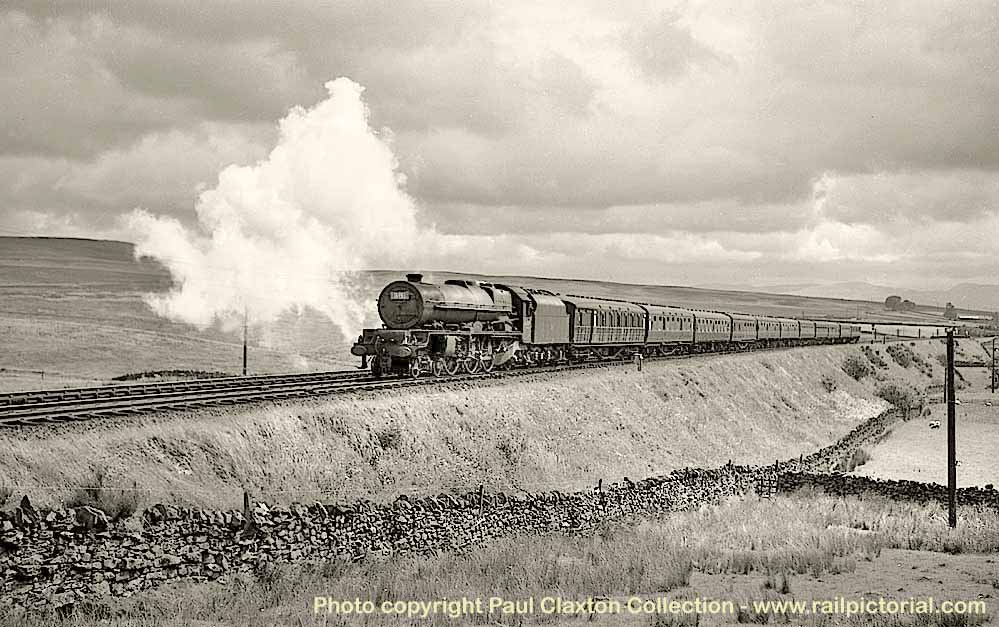
(Above-Below) For those who enjoyed photography and the great outdoors, there was no wilder place than Shap Fell. This bleak and forlorn stretch of moorland was one of howling winds and horizontal rainfalls, where only ragged sheep and railway photographers might roam. Paul's classic shot (above) shows Stanier 'Princess Royal' class No 46208 Princess Helena Victoria storming up the bank at Shap Wells with the 1S53 Crewe-Aberdeen on 4 August 1962. (Below) BR 'Britannia' Class 7MT No 70034, minus its Thomas Hardy nameplates, storms to the summit on 31 July 1965.
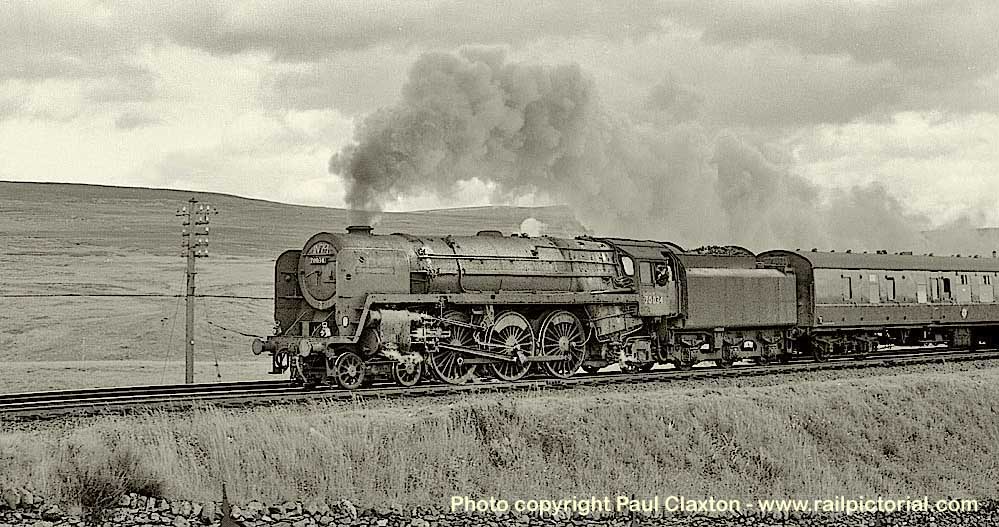
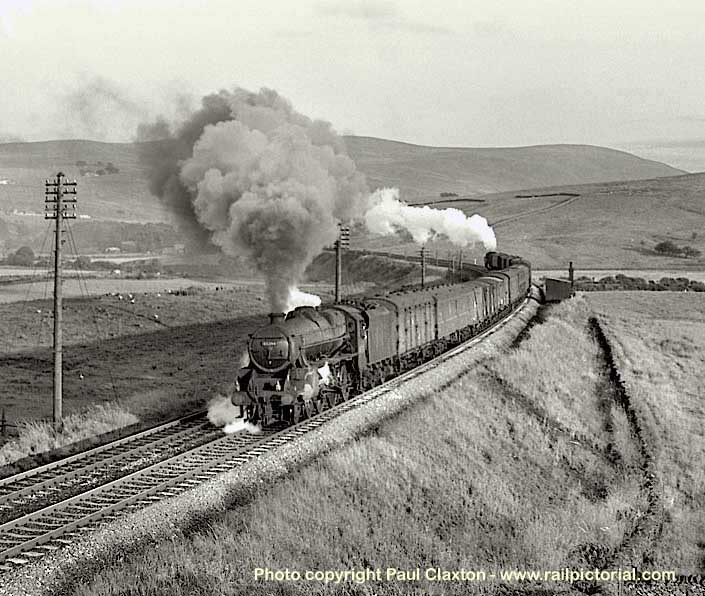
(Above-Below) 'Black 5' 45294 has rear-end assistance by one of Tebay's bankers as it tackles the gradient at Greenholme in July 1967. (Below) A refreshingly different view of steam's assault on Shap; Stanier Pacific No 46237 City of Bristol heads the 1S51 Crewe- Glasgow at Shap Wells on 4 August 1962.
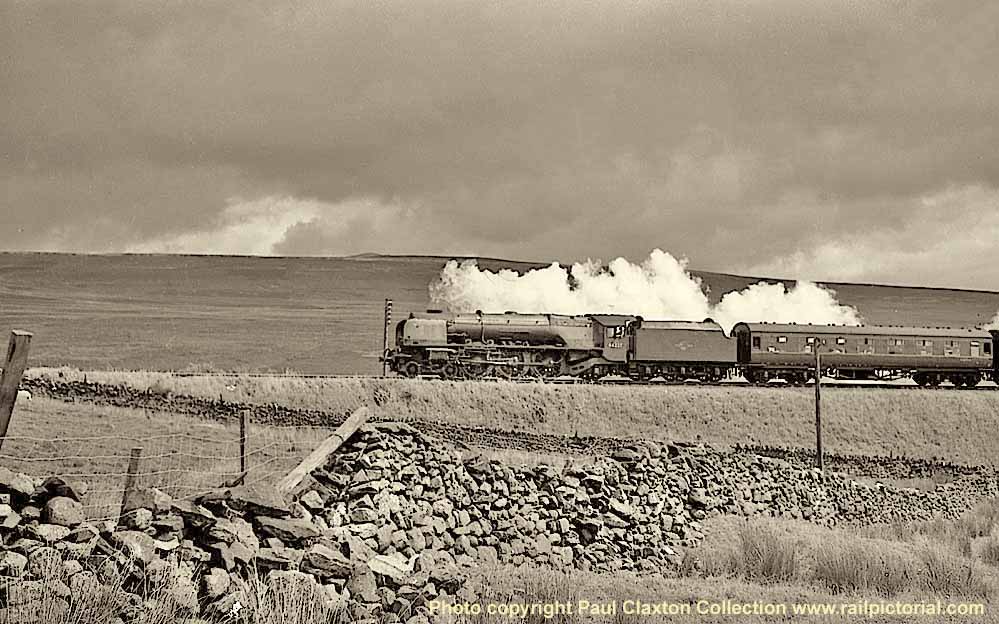

(Above) The design and construction of the 'WD' (War Department) 2-8-0 'Austerity' freight locomotives (built to Ministry of Supply design) was prepared by RA Riddles CBE, then Mechanical and Electrical Engineer for Scotland, LMSR, and attached to the Ministry of Supply as Deputy Director General of Royal Engineering Equipment. The first batch of 'WDs' was built by the North British Locomotive Company in 1943 for general war service overseas. This was followed by a second batch constructed at the Vulcan Foundry Ltd, and no fewer than 733 returned for service on BR, with 261 going to the London Midland region, 260 to the ER, 109 to the NER, 49 to the WR and 54 to the ScR. Although built for austerity conditions overseas, the WDs played a vital role in ordinary freight service on British Railways...
Prior to the 1959 General Election, the number of servicemen was halved and National Service was abolished in 1960. This meant that the majority of the post-war baby-boomers missed the 'call up' by the skin of their teeth, yet many commentators deplored the cuts in national service. In their opinion, a good dose of army drill was the best way of socially disciplining potentially wayward teenagers - a view I didn't subscribe to at the time, but nowadays? Well, having experienced life's ups and downs I'm beginning to think they had a point.
TELEVISION
Like most families in the Fifties, the 'goggle box' was the focal point of the living room and everyone in the family spent their leisure time watching TV together. The most popular British television programmes at that
 time included the pedestrian-paced 'Dixon of Dock Green', however from 1962 onwards the rather bland 'bobby on the beat' storylines gave way to the gritty 'Z Cars' up north. Then there was the zany 'Candid Camera' featuring prankster Jonathan Routh, and in January 1961 the first series of 'The Avengers' made its debut.
time included the pedestrian-paced 'Dixon of Dock Green', however from 1962 onwards the rather bland 'bobby on the beat' storylines gave way to the gritty 'Z Cars' up north. Then there was the zany 'Candid Camera' featuring prankster Jonathan Routh, and in January 1961 the first series of 'The Avengers' made its debut. The Avengers initially focused on Dr David Keel (Ian Hendry) and his assistant John Steed played by Patrick Macnee, but after Henry left at the end of the first series, Steed became the main character. He was partnered by a succession of beautiful female assistants, all with big 'snog-me' eyes, shapely bodies and legs
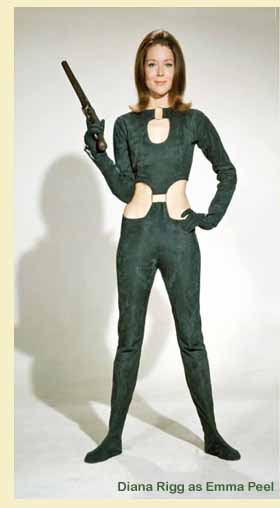 to die for...well, you do notice these things when you're burgeoning headlong into adolescence, don't you?
to die for...well, you do notice these things when you're burgeoning headlong into adolescence, don't you? The carefully choreographed fight sequences featured a kick-boxing Cathy Gale (Honor Blackman), Emma Peel (Diana Rigg) and Tara King (Linda Thorson) whose acrobatic drop kicks took your breath away. Clearly the 1960's feminism movement was getting into its stride; gone were the days of actresses playing helpless waifs. What viewers were witnessing here was a whole new generation of gorgeous combat-trained crumpet, whose surreal fight scenes turned our school playground into something resembling a martial arts centre for wayward girls.
Watching girls cartwheeling across the school yard into jaw-breaking high kicks on one another completly changed a boys sexual chemistry in the Sixties. Not surprisingly, 'The Avengers' was a huge hit in more than 90 countries.
However, a large number of TV programmes were imported from America; I recall just a few of the favourites being 77 Sunset Strip featuring two Los Angeles Private Eyes (girls had the 'hots' for Ed Byrnes who
 played Kookie, a hair-combing valet parking attendant at Dino's, the club next door to the detectives' office). Then there was a Western series called 'Rawhide' (girls now had the 'hots' for a young Clint Eastwood who played Rowdy Yates). The other favourites were Bonanza, Gunsmoke, Perry Mason, Alfred Hitchcock Presents, The Twilight Zone, The Man from UNCLE; The Outer Limits, Mister Ed (featuring a talking horse) and the Beverley Hillbillies plus a dozen more too numerous to mention here.
played Kookie, a hair-combing valet parking attendant at Dino's, the club next door to the detectives' office). Then there was a Western series called 'Rawhide' (girls now had the 'hots' for a young Clint Eastwood who played Rowdy Yates). The other favourites were Bonanza, Gunsmoke, Perry Mason, Alfred Hitchcock Presents, The Twilight Zone, The Man from UNCLE; The Outer Limits, Mister Ed (featuring a talking horse) and the Beverley Hillbillies plus a dozen more too numerous to mention here. (Below) Class B1 No 61023 Hirola heads the 1X86 Castleford-Blackpool at Dowbridge on 6 August 1962.
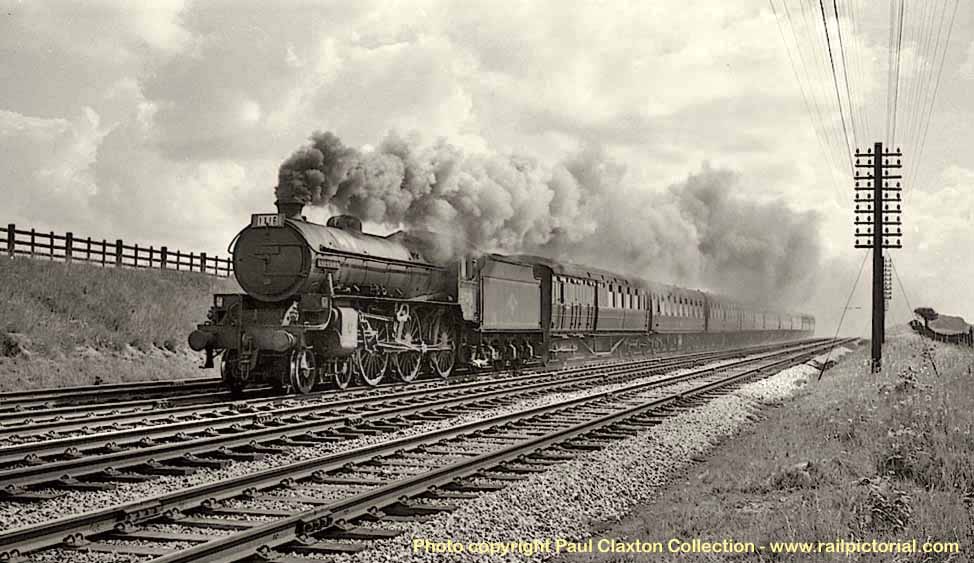
CARTOONS
During the early 1960s, the output of Hanna and Barbera's television cartoons helped lighten up our teatime viewing after school, although the prize for most enduring characters still remained with Walt Disney's band of Mickey Mouse, Goofy and Donald Duck, with whom my generation became acquainted as kids during visits to the cinema
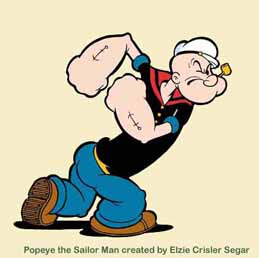 in the Fifties.
in the Fifties. And I mustn't forget the gravel-voiced Popeye the Sailor Man, created by Elzie Crisler Segar. The beefy tattooed character made his first appearance in a comic strip in 1929 and four years later Fleischer Studios adapted the character into a series of animated cartoons for Paramount Pictures.
By the beginning of the Sixties, the influence of television was starting to make major inroads on cinema audiences, and in 1960 a new series of Popeye cartoons was commissioned especially for TV. More than 220 cartoons were produced, many of them featuring the eternal love triangle between Popeye, Olive Oyl and a brutish Bluto, who repeatedly lusted after the hapless Olive...
'Help! Popeye, save me!' she cried out.
Our hero wasted no time, grabs the nearest can of spinach and downs it in one gulp; the affect is instant. He now possesses superhuman strength - tarrrah! - and with his trusty multipurpose pipe gritted firmly between his teeth (it can be used as a propeller, snorkel, periscope, blowtorch - even a jet engine with a bit more puff) he will do anything to prevent
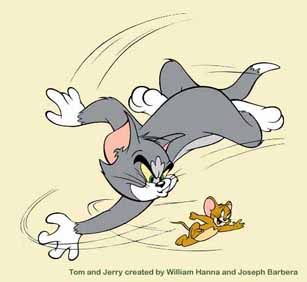 Bluto getting his dirty mitts on his beloved Olive - 'I'm coming Olive!' he calls out.
Bluto getting his dirty mitts on his beloved Olive - 'I'm coming Olive!' he calls out. The reason William Hanna and Joseph Barbera's cartoons were popular with my generation is because we grew up with them - and in particular Tom and Jerry were among the favourites. The Metro-Goldwyn-Mayer cartoons featured the helter-skelter rivalry between an embattled household cat and a pesky mouse, whose imaginative chase scenes entertained both adults and children for decades. Hanna and Barbera made a total of 114 Tom and Jerry cartoons at the MGM cartoon studio in Hollywood from 1940 to 1957,
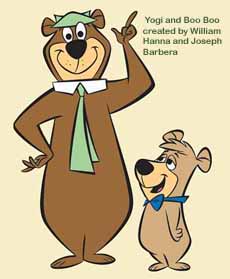 winning seven Academy Awards along the way.
winning seven Academy Awards along the way.The Huckleberry Hound Show was another cartoon created by Hanna-Barbera for television, this one featuring a laid back, cool dude dog character with a lazy Southern drawl, or perhaps he was half-cut on bootleg alcohol? Huck was followed by Quick Draw McGraw and then Yogi Bear and his sidekick Boo-Boo made their debut in 1958, both cartoon characters spending most of their time pinching picnic baskets from unsuspecting tourists to Jellystone Park and avoiding their nemesis, Ranger Smith.
Top Cat and his motley gang of feline pals featured in another Hanna-Barbera prime time animated television series which debuted in 1961. Yabba-
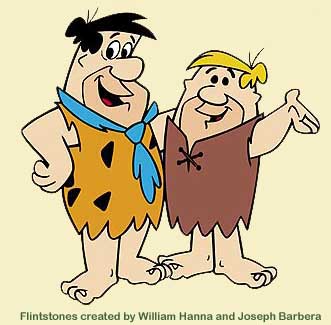 Dabba-Doo! The history teacher had to throw the school syllabus out of the window when the Flintstones arrived. The everyday stories of Freddie and his put-upon wife Wilma, and best friend Barney, taught children what life was really like for a working-class man during the Stone Age. It became the most financially successful network animated franchise for three decades. Then there was Wacky Races, yet another animated television series produced by Hanna-Barbera, though by the time it aired in 1968, it didn't have the same appeal somehow ...it was just plain silly, or perhaps I had outgrown cartoons by then; it was time for the next generation of kids to step up to the mark...
Dabba-Doo! The history teacher had to throw the school syllabus out of the window when the Flintstones arrived. The everyday stories of Freddie and his put-upon wife Wilma, and best friend Barney, taught children what life was really like for a working-class man during the Stone Age. It became the most financially successful network animated franchise for three decades. Then there was Wacky Races, yet another animated television series produced by Hanna-Barbera, though by the time it aired in 1968, it didn't have the same appeal somehow ...it was just plain silly, or perhaps I had outgrown cartoons by then; it was time for the next generation of kids to step up to the mark...RAILWAY MEMORABILIA
Psychologists say that men are programmed to collect things from an early age; that our Achilles' heel is a passion for hoarding worthless old junk. This compulsion to hoard clutter is part of a boy's genetic
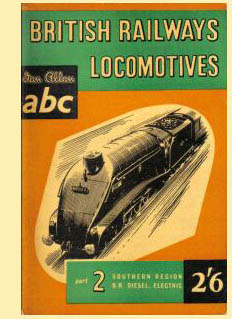 makeup that continues well into adulthood; and this is especially the case for the lucky few who've managed to acquire a disposable income along the way and can afford to dabble in second hand railwayana (costing a King's ransom) that they could ill afford to buy at a fraction of the cost in childhood.
makeup that continues well into adulthood; and this is especially the case for the lucky few who've managed to acquire a disposable income along the way and can afford to dabble in second hand railwayana (costing a King's ransom) that they could ill afford to buy at a fraction of the cost in childhood. Over the years my collection of old railway photos has manifested into a veritable Aladdin's cave of memories, though the general view is that it looks more like Steptoe's junk yard! Well, my daughters think so, which, on the face of it, is understandable. After all, a set of blurred photos of speeding trains taken some fifty-odd years ago on the
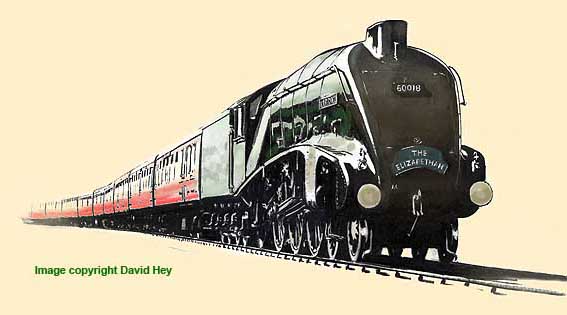 family's rickety old Box Brownie isn't worth a jot to anyone, but in terms of reawakening old childhood memories it is priceless to me!
family's rickety old Box Brownie isn't worth a jot to anyone, but in terms of reawakening old childhood memories it is priceless to me! But then the female of the species can never fathom out the male psyche; they regard men who squirrel away memorabilia in drawers and cupboards as a shameful object of derision, yet no mention is made of the clutter of moth-eaten frocks and shoes stashed away at the bottom of their own wardrobes.
And can anyone explain a woman's extraordinary fetish for saving old handbags humming of perfume? No, I don't get it either. The impenetrable enigma of the female mind is far too complex to figure out…I gave up trying years ago. But let me be level-headed about this, gender is not the issue here because nostalgia is such a strong emotion that it affects everyone in later years; it may take only the most innocuous object, such as the cover of an abc Locospotters Book, or a photograph that reminds you of a special moment in the past.
 (Right) This is one of the nameplates from 'Royal Scot' class 46117 Welsh Guardsman...measuring 49" long the nameplate went under the hammer for £12,000 at a Great Central Railwayana Auction in April 2010.
(Right) This is one of the nameplates from 'Royal Scot' class 46117 Welsh Guardsman...measuring 49" long the nameplate went under the hammer for £12,000 at a Great Central Railwayana Auction in April 2010. 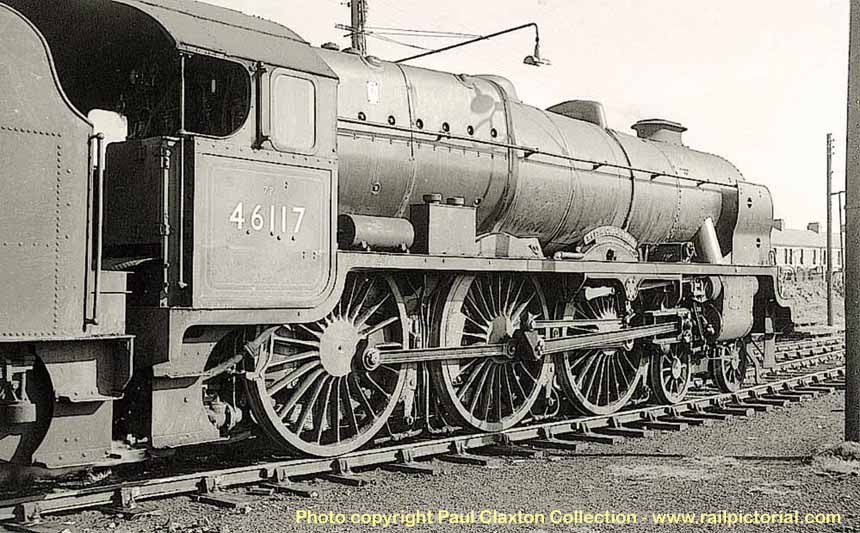
(Above) Built by the North British Locomotive Co, Works No 23612, in 1927, the former LMS Class 6 (later 6P, then 7P) 'Royal Scot' 4-6-0 No 46117 Welsh Guardsman spent most of its life at Holbeck shed during BR days except at the very end when it went in quick succession to Low Moor, Mirfield and Holbeck from where it was withdrawn in November 1962. After spending a year in store at Holbeck, it was cut up at Crewe Works in December 1963. Paul photographed 46117 at Blackpool South on 16th September 1961.
(Below) Back in BR days, the famous Aintree Race Week was the focal point of numerous excursions from most parts of the country. The Grand National Day in particular involved an abnormal peak traffic period, with a high number of steam-hauled specials converging on the area. Aintree Sefton Arms station on the ex-L&Y Liverpool-Preston line was the closest to the grandstands and this placed a heavy burden on local servicing and stabling facilities at Walton-on-the-Hill (27E) where the shed was faced with handling as many as 30 locomotives, each requiring turning, coaling and servicing. The visiting engines on 31 March 1962 included Willesden's 'Royal Scot' class No 46146 The Rifle Brigade which had brought in the 1Z64 race special from London Euston. For the record, Aintree shed closed its doors in June 1967, and the 1962 Grand National was won by Kilmore, a 28/1 shot ridden by jockey Fred Winter. Wyndburgh came second, and Mr What finished third. Thirty-two horses ran and all returned safely to the stables.

(Right) A locomotive nameplate, minus the Regimental coat of arms, from the LMS 'Royal Scot' Class 7P No 6146, 'The Rifle Brigade' went under the hammer for £9,600 at a Sheffield Railwayana Auction on 15th
 December 2012. Built by the North British Locomotive Co, Works No 23641, in 1927, the loco was originally named Jenny Lind in 1928 after the pioneer Midland Railway locomotive class; it was renamed in May 1936. Allocated new to Crewe North in November 1927, it had numerous changes of shed with lengthy stays only at Edge Hill, Bangor and Camden, finishing its days at Willesden from where it was withdrawn on 27 November 1962 and cut up at Crewe Works by 12 March 1963.
December 2012. Built by the North British Locomotive Co, Works No 23641, in 1927, the loco was originally named Jenny Lind in 1928 after the pioneer Midland Railway locomotive class; it was renamed in May 1936. Allocated new to Crewe North in November 1927, it had numerous changes of shed with lengthy stays only at Edge Hill, Bangor and Camden, finishing its days at Willesden from where it was withdrawn on 27 November 1962 and cut up at Crewe Works by 12 March 1963. (Below) York was a favourite destination for thousands of young spotters during the Fifties and Sixties, and Paul's shot of Class A4 No 60022 Mallard heading the northbound 'Elizabethan' though York on 8th September 1961 is the way that many of us will remember it.
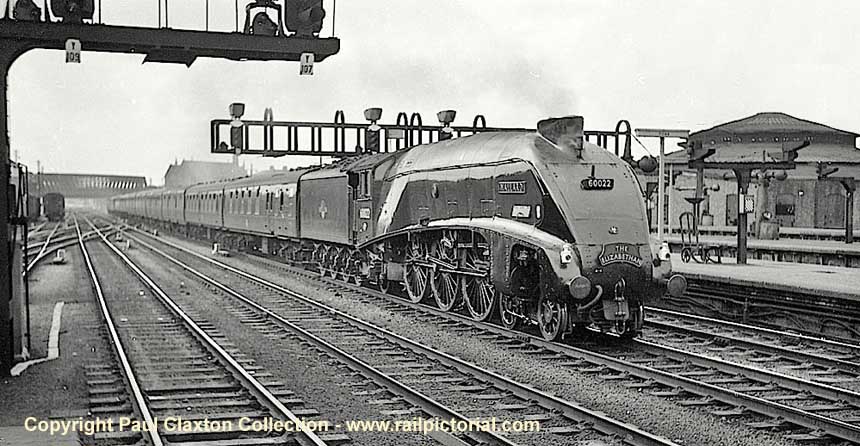
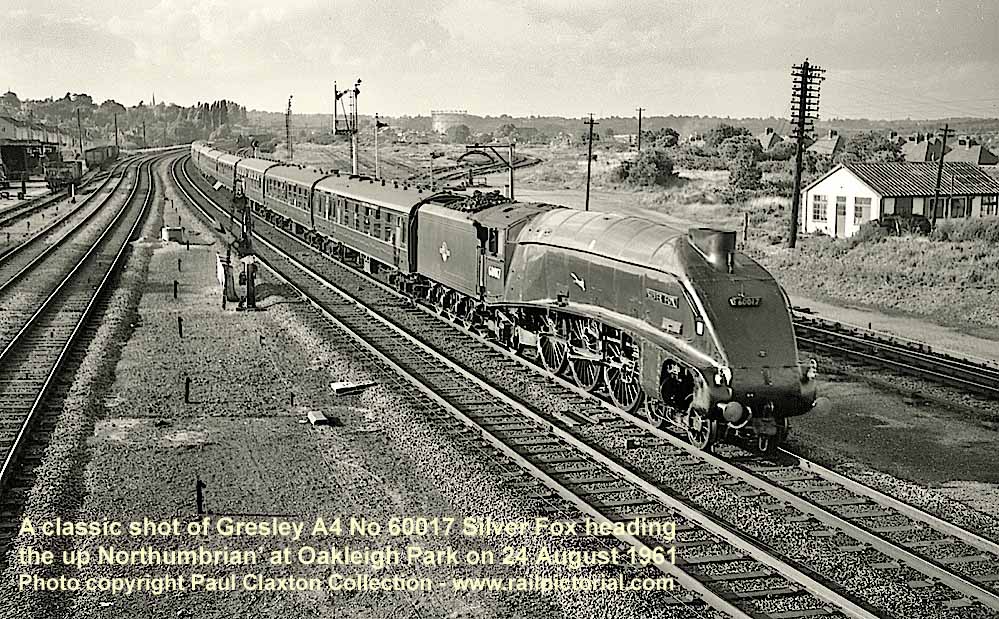
A RAILWAYMAN'S MEMORIES...

(Above-Inset below) 'Black 5' No 44690 skims over Salwick Water Troughs between Preston and Kirkham with the 1H95 on 3rd June 1963. (Inset Left) 45647 'Sturdee' 1X10 Blackpool to Leeds gets more than a fill at Salwick Troughs on 23rd October 1966.
These classic Paul Claxton shots of locomotives picking up water at speed remind me of a story by Tony Thompson, ex-Agecroft, Patricroft and Crewe, who recalls a fateful trip during his firing days at Patricroft shed. One evening in the summer of 1961 he booked on duty at 9.35pm for the 11.20 Manchester-Glasgow, also known as the '11.20 papers', which included two Royal Mail vans with mail catchers on opposite sides for the return trip.
 His driver that night was 'Maz', and after preparing their Jubilee, they left Patricroft shed light engine for Manchester Victoria's platform 11, hooked on to the train at 10.55pm and some 5 minutes later the Newton Heath men hooked on the front of them with one of the low-framed Caprotti 5s.
His driver that night was 'Maz', and after preparing their Jubilee, they left Patricroft shed light engine for Manchester Victoria's platform 11, hooked on to the train at 10.55pm and some 5 minutes later the Newton Heath men hooked on the front of them with one of the low-framed Caprotti 5s. The reason for double-heading this turn was to tackle Pendlebury Bank, especially with 16 bogies on; it was a very heavy train filled mostly with mail and papers plus parcels. The timings to Preston was 43 minutes, but as usual their departure was held up by the paper guys, never the Post Office, and this delay could be anything up to eight minutes.
Having finally got the right of way at 11.27pm, Maz opened the regulator and they stormed through Exchange then with the second valve and reverser pulled right back, headed across onto the Lanky. From then on it was all systems go and both engines were soon pounding through Salford Station, the 5X roaring and the 'Black 5' blasting. Approaching Pendlebury Bank they had a full 7 minutes to make up, so it was shovel in hand and a few rounds for the climb ahead, but the 5X was in fine fettle so keeping her around the 225 mark was comfortably easy.
As they neared the top of the bank Tony shovelled a few more rounds into the firebox before they levelled out in anticipation of Walkden Water Troughs, serving all four tracks - 'Fast' and 'Slow' Lines. Ahead they had 14 miles of near straight level track and both engines were flat out, doing over 75mph on the approach to the troughs.
At this juncture, it should be explained that the practice for picking up water with a double-headed train was that the leading engine dipped first and as the spray started to dwindle the train engine dipped second. However, on this particular night things didn't go quite as smoothly!
When the time came for both firemen to prepare for the water troughs, Tony got off his seat to operate the water scoop handle when he heard an almighty crash behind him! Spinning round he saw a large chunk of
 coal had smashed through his window and shattered in the cab!
coal had smashed through his window and shattered in the cab! So much for trimming the tender on the leading engine by the 26A men! Even to this day he dreads to think what might have happened had it been three seconds earlier and he was in his seat! He can only assume that the bridge they'd just passed under was lower than the previous ones, and as a result the coal had been dislodged from the tender, came hurtling along the top of theirr boiler barrel and smashed through his glass! Make no mistake he was shaken up but somehow managed to drop the scoop and top up the tender. Tony recounts the full story on the 'London Midland Region - 2' page 28.
(Inset Right) An unidentified 'Black 5' heads a Blackpool-bound special at Salwick Troughs in August 1965. (Below) A lucky chance shot this, but Paul has captured the moment with typical aplomb! 'Black 5' No 45408 heads the 1P15 Wigan-Blackpool over Salwick Troughs, running neck-and-neck with 'Jubilee' class 45654 Hood with the 1X13 Bradford Low Moor-Blackpool on 3rd June 1963.
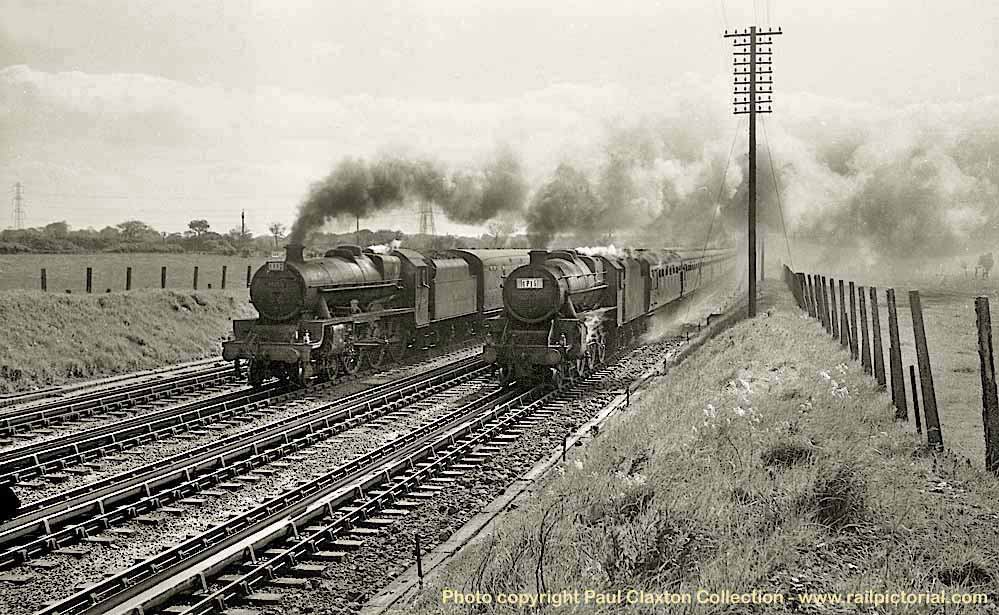
Writing these captions reminds me of the uncertainties we face in this changing world. It wouldn't surprised me that the term 'Black 5' will be construed as racially offensive by the PC lobby sooner or later; indeed the true irony of our barmy culture can be gleaned from a recent court case involving two Premiership players and an alleged racist remark purported to have been made during a heated clash in a game. Now I'm not about to go into the ins-and outs of it here; what I will say is this; although the media reported it in full - the one word deemed offensive enough to warrant a court case (the word was 'black' in case you're wondering) was the only word that did not require censorship. The rest of the words (swear words) were obliterated in a blizzard of asterisks!
How many of today's adult enthusiasts wish they had taken more railway photographs when they had chance in the 1960s? I certainly do - and I would have done a lot more - but, as ever, reality was not so clear cut. For one thing, most of the kids I knocked around with at the Youth Club didn't understand my passion for photographing trains. In their view, it was juvenile and 'square', and the question most frequently asked was - why did I do it? Why not? Like many steam enthusiasts of that era I was determined to record the railway scene before it vanished completely and no amount of peer pressure was going to intimidate me. But the rules of engagement were about to change. As dieselisation got into its stride, visits to the lineside might yield the odd photograph of steam, but for the most part enthusiasts had to make do with taking shots of dreary-looking diesels. Alas, railway photography had taken on a whole new meaning…BR's stock of motive power seemed to consist of only run-down steam classes and equally drab-looking diesels and, if truth be told, the enjoyment had gone out of railway photography. The lack-lustre railway scene was a truly depressing sight and there were many enthusiasts who saw no point in photographing steam's imminent demise in such a lametable state.
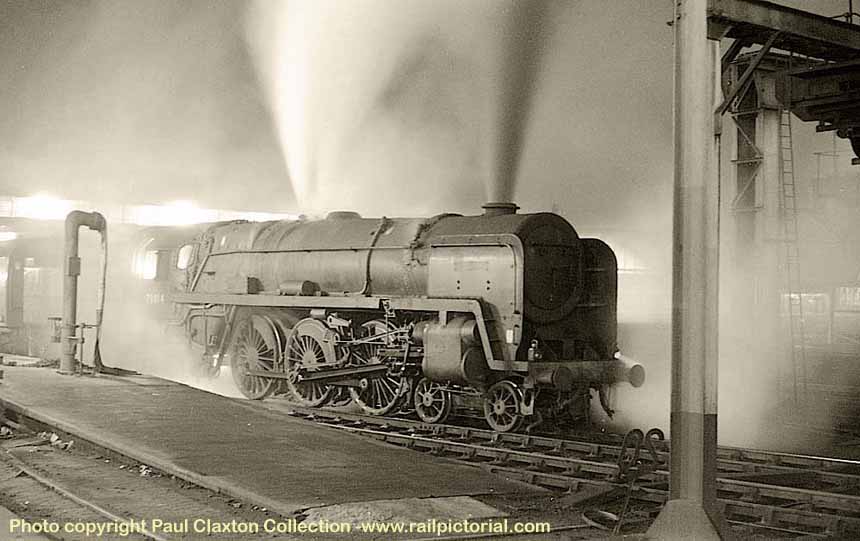
(Above) Looking fit-to-bursting, Britannia 4-6-2 70014, minus its Iron Duke nameplates, brews up in readiness for departure from Preston with a train from Birmingham to Heysham on 19 November 1965. Built at Crewe Works in June 1951, 70014 was initially, but very briefly, allocated to the ER's Norwich Thorpe MPD (32A). However, 70014 is best known for being one of a pair of 'Britannia' locos destined to work on the Southern Region for close on seven years. Based at Stewarts Lane MPD (73A), 70014 was entrusted with hauling the prestigious 'Golden Arrow' Pullman service from London Victoria to Dover (or Folkestone), albeit 70014 performed the role of 'back-up engine' to 70004 William Shakespeare. After spending time on the SR, 70014's allocations came thick and fast - Kentish Town MPD (14B); Trafford Park MPD (9E); Newton Heath MPD (26A); Neasden MPD Annesley MPD (16D); Willesden MPD (1A); Llandudno Junction MPD (6G); Willesden MPD (1A) again; Crewe North MPD (5A); Crewe South shed (5B); before returning to Llandudno Junction MPD (6G) followed by a move back to Crewe South MPD (5B). Finally the nomadic 70014 joined the massed ranks of 'Britannia' locos at Carlisle Kingmoor depot (12A) where withdrawal came on 30th December 1967; the loco was scrapped at Carlisle Viaduct Yard in March the following year.
 (Right) A nameplate measuring 34½" long, in ex-loco condition, went under the hammer for £15,000 at a Sheffield Railwayana Auction on 15 December 2012. 'Iron Duke' was the nickname of the 1st Duke of Wellington.
(Right) A nameplate measuring 34½" long, in ex-loco condition, went under the hammer for £15,000 at a Sheffield Railwayana Auction on 15 December 2012. 'Iron Duke' was the nickname of the 1st Duke of Wellington.For countless thousands of post-war baby boomers, the less-worldy 1950s and early Sixties was the very foundation upon which society was formed. There was a wonderful sense of belonging and instilled in every child was an appreciation of traditional family respectability, and an even stronger sense of moral values. Even so, wartime stringencies were very much in evidence and many families had to struggle to make ends meet. The upshot is that children had a somewhat repressive upbringing and discipline was strict. If a child stepped out of line, school teachers and parents didn't hesitate to give them a hefty clip around the ear for daring to complain about their lot - 'Brave men fought and died in the war for your freedom,' was the mantra. It was enough to silence even the most dissenting voices. Clearly the rules of propriety were defined by the conflict with Germany during World War 2 and children learned the differences between right and wrong from a very early age.
(Below) A beautifully back-lit image of 70017 Arrow at Blackpool North shed on 14 October 1961. At this time, 70017 was allocated to the unfashionable Aston depot (21D) in Birmingham, where 'he' was obviously well thought of by staff; the engine is very clean and looks fit for the task ahead...working a returning 'Illumination Special' to Birmingham; the express headlamps are already in place. For the record, 70017's career began on the Western Region based at Old Oak Common MPD (81A) in June 1951 where the loco was entrusted with working top-link expresses such as 'The Bristolian', 'The Merchant Venturer' and the other West Country trains out of Paddington. The end came at Carlisle Kingmoor shed (12A) in May 1966, where 70017 saw out the last few months before retirement on the 30th September that year. Disposal came at J Cashmore of Newport in December 1966.
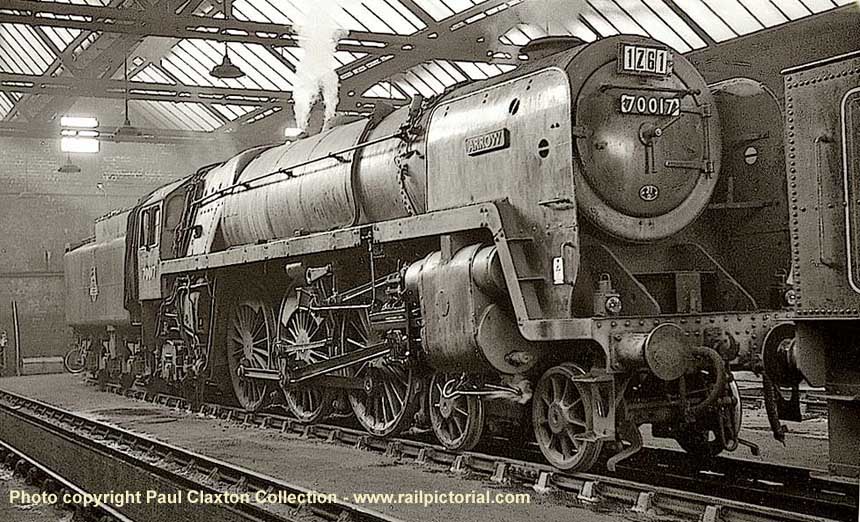

(Above) Memories of Leeds Central station, the starting point for many spotting trips to Doncaster back in the Fifties.
Ah, yes…the dowdy 1950s. Because dowdy they were…compared to the 'Roaring Twenties' and 'Swinging Sixties' the 1950s will always be remembered as a decade of penny-pinching stringencies when hard-up parents not only had to scrimp and save to make ends meet, they worked their socks off to keep life and soul together. After the Second World War ended in 1945, Britain was stony broke and many High Street shops were still selling utility products made from strictly controlled Government allocations. It wasn't until 1954 that food rationing finally ended - the last commodity being meat - yet despite the promise of better times ahead, grown-ups still required a huge amount of steel grit and resilience to get by. Indeed had it not been for their example, children would never have learned the importance of family traditions and a rock-solid belief what it meant to be British. In those days, the whole country was in the same boat, but despite a dearth of consumer goods in shops there was no shortage of generosity from neighbours rallying together to eke out a living one way or another.
However, discipline was strict, even for toddlers, and smacking was the reckoning for anyone caught
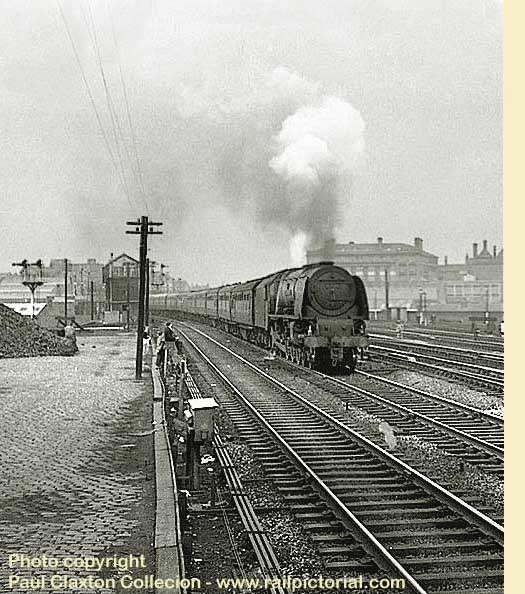 behaving badly. But rather than feeling angry and outraged by such treatment, it taught children to play by the rules, to respect their elders and generally conform. Above all else, punishment taught children to understand the difference between right and wrong, all of which were noble sentiments given the bleakness of those times.
behaving badly. But rather than feeling angry and outraged by such treatment, it taught children to play by the rules, to respect their elders and generally conform. Above all else, punishment taught children to understand the difference between right and wrong, all of which were noble sentiments given the bleakness of those times. Regrettably, the same can't be said for today. The values we grew up with seem to have no place in today's modern society - it's almost as if the country has slipped into a moral vacuum built on the assumption that anything goes, that hard working, law-abiding folk are by definition laughing stocks and those at the bottom of society's heap have a monopoly on morality. Worse still, the age-old precept - duty and respect - has been replaced by a wishy-washy tolerance of failure and a bunch of misguided philanthropists representing the PC lobby have become the bane of everyone's life.
 (Above left-Right) Not content with taking just any old shot of Stanier Pacific No 46254 City of Stoke-on-Trent heading the down 'Lakes Express' past Preston MPD on 6 July 1963, Paul swings the camera around to take the traditional going-away shot, though this one is slightly different since it features the 309 foot-high spire of St Walburge's Church - a dominant landmark in Preston. Built in the mid-19th century by the Gothic revival architect Joseph Handsom (designer of the handsom cab) St Walburge's Church is designated a Grade 1 listed building by English Heritage, and is famous for having the tallest spire of any parish church in England. The steeple is constructed from limestone sleepers which originally carried the Preston and Longbridge Railway. The spire was the last to be worked on by steeplejack and TV personality Fred Dibnah, who installed his ladders to inspect the steeple, but due to television filming commitments he was unable to complete the job. The tower contains a single bell weighing 1½ tonnes but its use is restricted to the winter months due to protected birds nesting in the belfry. Of course, the protection of Britain's indigenous wildlife is a worthy cause, so why can't the same level of protection be extended to the country's ageing human population?
(Above left-Right) Not content with taking just any old shot of Stanier Pacific No 46254 City of Stoke-on-Trent heading the down 'Lakes Express' past Preston MPD on 6 July 1963, Paul swings the camera around to take the traditional going-away shot, though this one is slightly different since it features the 309 foot-high spire of St Walburge's Church - a dominant landmark in Preston. Built in the mid-19th century by the Gothic revival architect Joseph Handsom (designer of the handsom cab) St Walburge's Church is designated a Grade 1 listed building by English Heritage, and is famous for having the tallest spire of any parish church in England. The steeple is constructed from limestone sleepers which originally carried the Preston and Longbridge Railway. The spire was the last to be worked on by steeplejack and TV personality Fred Dibnah, who installed his ladders to inspect the steeple, but due to television filming commitments he was unable to complete the job. The tower contains a single bell weighing 1½ tonnes but its use is restricted to the winter months due to protected birds nesting in the belfry. Of course, the protection of Britain's indigenous wildlife is a worthy cause, so why can't the same level of protection be extended to the country's ageing human population?Okay, I'm sounding off again, but why not? The aging process is a rites of passage thing. Once you've passed the 'BigSix-0' you have no need to worry about being charming, likeable or popular, but be warned - some subjects are taboo even in a democratic society such as ours. I'm talking about the Government's miserable failure to control immigration! And before the PC lobby get up in arms, let me set the record straight; I am not racist and my patriotic views should not be construed as those of a fascist. My grievances are focussed on economics, pure and simple; I'm talking about the intolerable strain on housing, health and education...
This is not what my generation voted for.
After all, everyone has a right to indulge in national pride. The need for a sense of belonging is the most natural of all human impulses, so it doesn't matter where you were born, loyalty to one's country is a noble
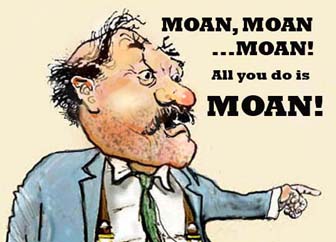 sentiment; it shows a concern for one's fellow countrymen. However, if newcomers can influence the PC lobby into undermining the host country in which its citizens are denied the right to express unbridled nationalism, such as flying the Union Jack, for fear of upsetting the PC apple cart, then it's a clear case of our burgeoning multicultural society gone crazy! And I'm not in the minority here. I'm one of the curmudgeonly over-Sixties who are not afraid to speak out.
sentiment; it shows a concern for one's fellow countrymen. However, if newcomers can influence the PC lobby into undermining the host country in which its citizens are denied the right to express unbridled nationalism, such as flying the Union Jack, for fear of upsetting the PC apple cart, then it's a clear case of our burgeoning multicultural society gone crazy! And I'm not in the minority here. I'm one of the curmudgeonly over-Sixties who are not afraid to speak out.(Below) Class V2 No 60973 heads the 10.30am Edinburgh to Aberdeen through Princess Street Gardens on 14th August 1965.
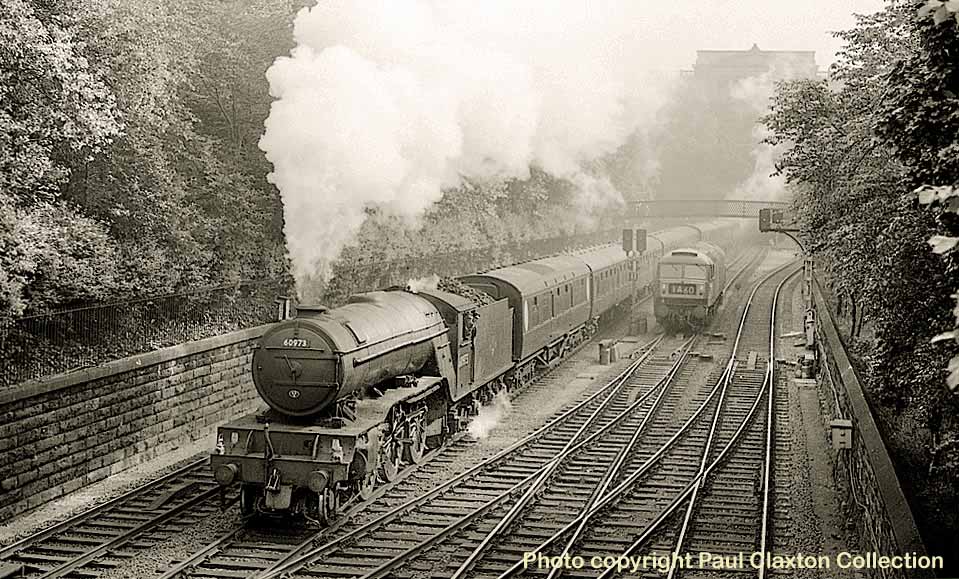
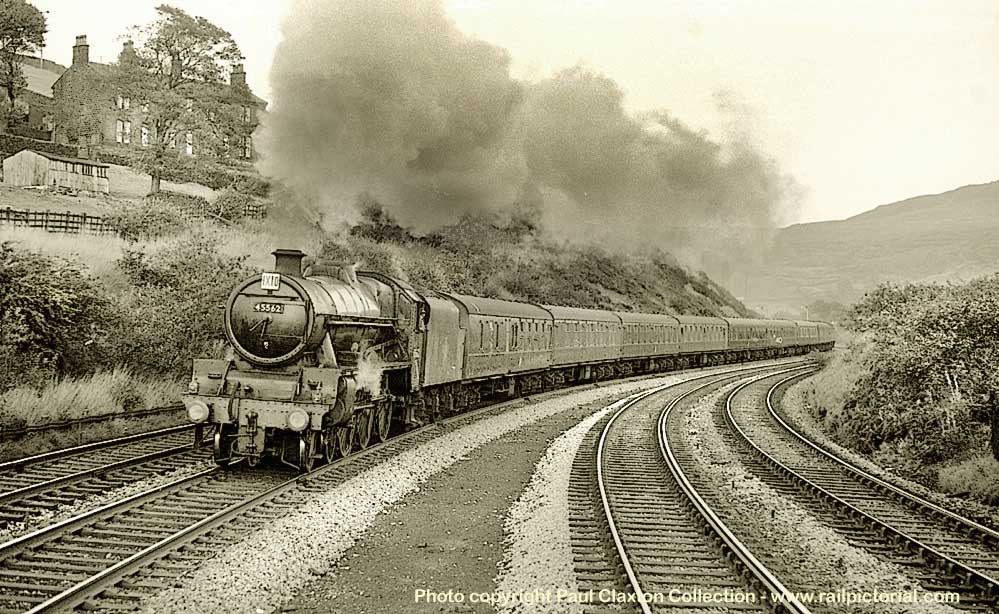
(Above) A superb shot of 'Jubilee' 45562 Alberta negotiating the reverse curves at Marsden on the climb to Standedge Tunnel with the 1X10 2.45pm Leeds to Blackpool on 18th September 1966
.
Alas, when harking back to the old days it seems the traditional values that we were taught in the Fifties - no matter how authoritarian they may now seem - has given way to a casual and selfish attitude, and the only thing that children seem to care about is themselves and the pretentious lifestyle that the celebrity culture brings. Crying out loud! What today's kids lack is firm discipline and solid role models, like the legion of steam railwaymen. These men were heroes in the old days. I'm not talking here about the shallow 'here today, gone tomorrow' celebrity-status culture that seems to pervade today's society. All railwaymen have a repository of stories; even the most humble, retiring steam footplateman is a precious individual with a unique tale to tell...

So whatever has happened to the quaint old fashioned British tradition of reserve, resilience, self-restraint and stiff upper lip? Our lives are being taken over by a generation of posturing, self-indulgent youngsters giving to showing off in public. The shameless flaunting on TV shows like the 'X Factor', 'The Apprentice', 'Big Brother' and 'Britain's Got Talent' is an irresistible opportunity to get their name in lights.
Fair enough…let them bask in their 'five-minutes' of fame, but as soon as it becomes patently clear that they lack any talent it seems there is no tragedy too small that they can't turn into making it all about themselves.
And as for the media? It just can't resist jumping on the bandwagon. For weeks afterwards these so-called instant 'celebrities' are given acres of publicity to air their grievances…does anyone care? Yes I do! We all should be concerned about how the all-pervading media influences our lives! Rather than encouraging common sense aspirations and elevating standards among the young, these reality TV shows reduces everything to the lowest common denominator, and without a tangible goal in their lives these wannabe-superstars are stripped of any responsibility for their own actions.
Look, I was young once and I had hopes and aspirations, but dreaming of instant success can turn a gullible youngster into an instant victim of failure...this is something they will have to live with for the rest of their lives.
(Below) This shot of EE Type 4 D383 heading the 1M23 Edinburgh to Birmingham through Grayrigg on 13 July 1963 is typical of Paul's reconnaissance with a camera in the northern fells...
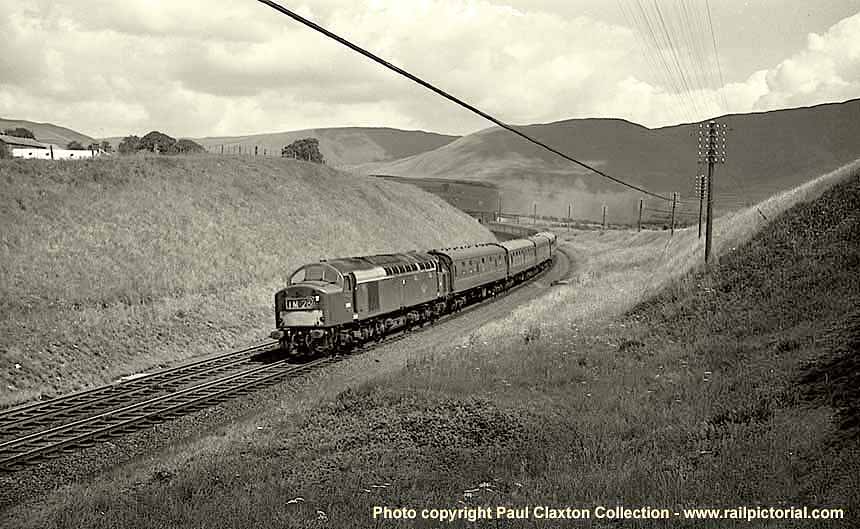
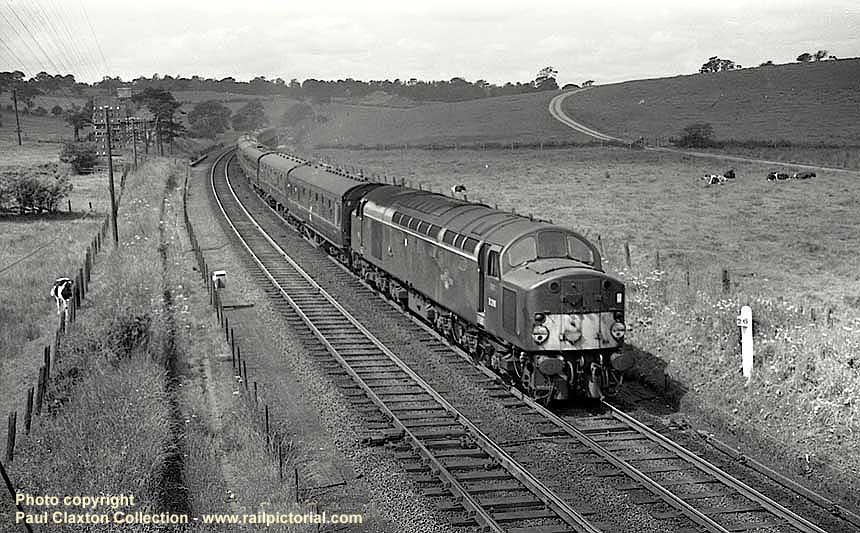
(Above) During the transition from steam, the EE Co Type 4s will always be associated with the West Coast route north of Crewe, often struggling with 13 coaches on the drawbar and hammering the locomotive with a load for which it was not designed. With the absence of a smoke effect (an integral part of steam railway photography) the anomaly about photographing diesels is the sense that the subject is standing still. You will have to imagine that 16-cylinders of engines are bellowing out as D210 'Empress of
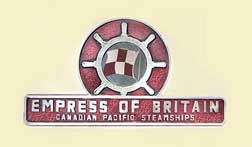 Britain' approaches the summit of Grayrigg Bank with the 1S47 9.43am Liverpool to Glasgow on 13 July 1963.
Britain' approaches the summit of Grayrigg Bank with the 1S47 9.43am Liverpool to Glasgow on 13 July 1963. (Below) D211 'Mauritania' heads the southbound 'Royal Scot at Thrimby Grange on the same day. The first production EE Co Type 4s destined for the LMR were delivered between May and November 1959. They were allocated initially to Camden, Wiilesden, Crewe and Carlisle Upperby, then to Edge Hill and Longsight as deliveries proceeded. The LMR's first twenty five EE Co Type 4s, Nos D210-D235 (with the exception of D226) received names taken from famous ships belonging to the Canadian Pacific, Cunard and Elder Dempster Lines - all three companies being associated with sailings from the port of Liverpool. No D211 - the second of the LMR's Camden batch, introduced to traffic in June 1959 - was named Mauretania by the Chairman of the Cunard Steamship Company at Liverpool Riverside in September 1960. A nameplate (and crest) certainly added much-needed panache during early diesel days.
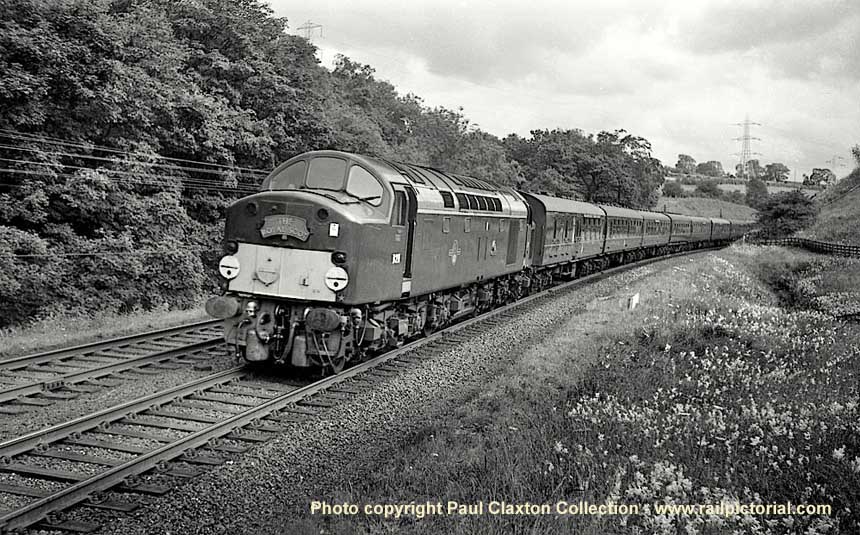
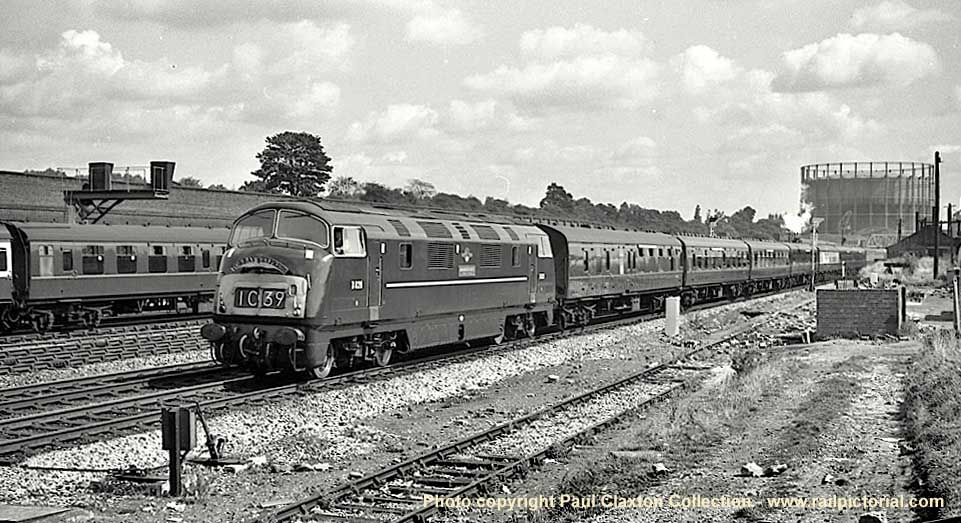
(Above) During the early Sixties both steam and diesels still carried titled train headboards and carriages had side boards mounted at cantrail height to identify the train. Here BR Class 42 'Warship' B-B D828 Magnificent heads the 1C39 12:30 Paddington-Kingswear 'Torbay Express' at Old Oak Junction on 22 August 1962. Alas, within a few years such extravagances as headboards were soon disappear from Britain's railways and most of the named trains were named only in the timetable.

(Above) Before the obligatory warning stripe appeared on the cabside, an immaculate No 46235 City of Birmingham was photographed inside Crewe North shed on 25 Mar 1964. The ban on the Stanier 'Coronations' south of Crewe was imposed following the energisation of the overhead catenary, and surviving locomotives were painted with a diagonal yellow stripe across the cab side to denote prohibition of their movements south of Crewe. Fortunately, No 46235 was one of three 'Coronations' to survive the cutters torch. Withdrawn from 5A in October 1964, the loco found a new lease of life, albeit as a non-working static exhibit at the Birmingham Museum of Science & Industry.
(Below) For all its strictness, the Fifties was a great place to be; quite apart from halcyon days of train spotting, we were actively encouraged by parents to play outside in the fresh air; we ran errands for elderly neighbours and had a share in the household chores; we walked to school, climbed trees and played rough and tumble games in the street; some of my pals and I were even allowed to go train spotting to faraway places such as Crewe, which, in view of the distance involved (from Leeds) and the need to change stations (at Manchester) it was quite an adventure...and all just to see the mighty 'Duchesses'. Here Paul photographed Stanier Pacific 46240 'City of Coventry' heading a parcels train on the up Chester Line at Crewe North Junction on 25 March 1964.
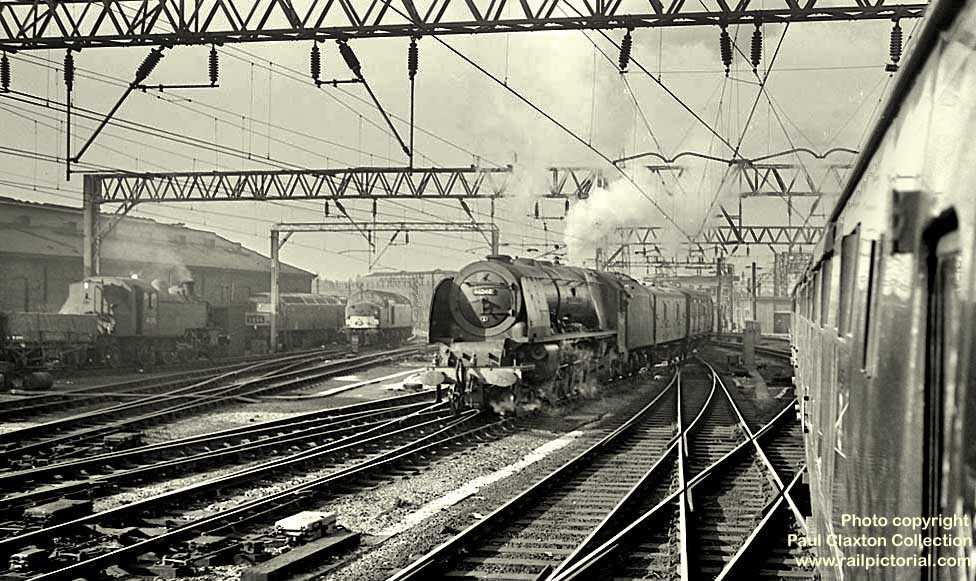
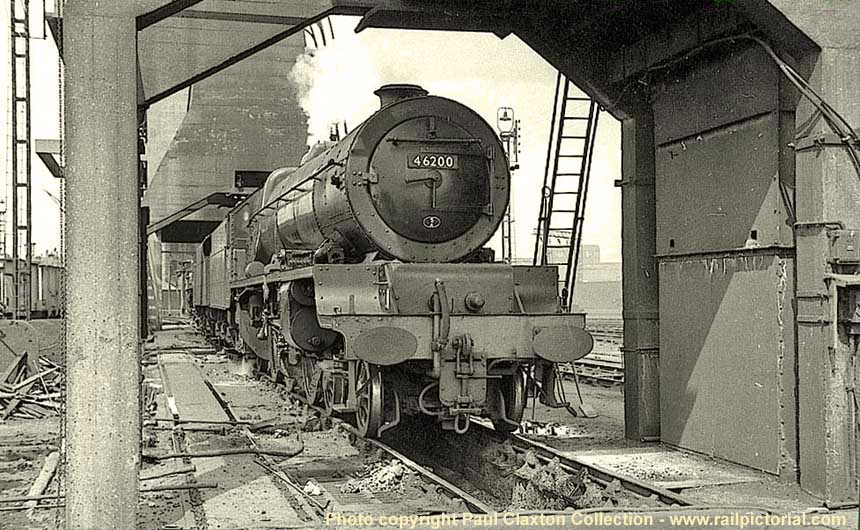
(Above-Below) The doyen of the Stanier Pacifics No 46200 Princess Royal and 'Black 5' No 45299 are waiting beneath the coal shutes at Crewe North MPD (5A) on 7 August 1961. (Below) Fairburn 2-6-4T No 42154 heads a parcels train from Preston to Blackpool North past the old Preston MPD (24K) on 23rd December 1962.
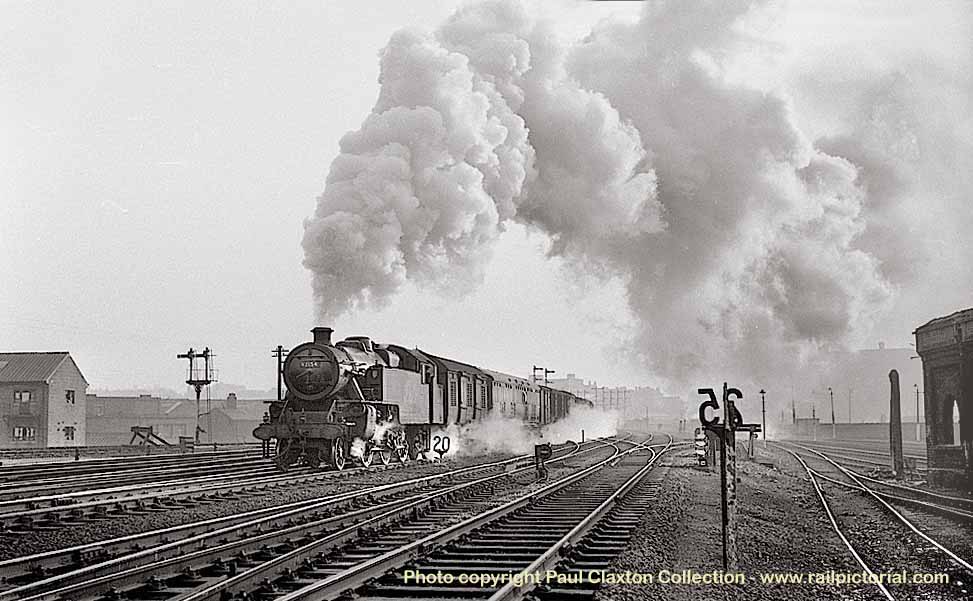
IN THE FINAL ANALYSIS...
Back in the 1950s a well-mannered child was the embodiment of respectibility and proud parents were happy to award a child's good behaviour with a treat. However, there are certain things about childhood that still bug me today and it's taken me until now to speak of it.
I'm harking back to a more innocent age when coalmen delivered to the door, rag 'n' bone men clip-clopped down the street and black people were an exotic rarity seen on television vaiety shows; they wore jazzy
 costumes, sang calypso songs or limbo danced under burning poles. Equally rare were fitted carpets; we had polished lino in the front room that looked like a wall-to-wall pizza with swirling colours that made me feel 'thee-thick'...
costumes, sang calypso songs or limbo danced under burning poles. Equally rare were fitted carpets; we had polished lino in the front room that looked like a wall-to-wall pizza with swirling colours that made me feel 'thee-thick'...As you can see I hadn't any social skills to speak of, but even at that age I was aware of an outpouring of deference by grown ups which led to children developing an inferiority complex that has taken years to shake off.
I'm talking about the suffocating Hyacinth Bouquet-style pretences that seemed to permeate the very fibre of the nation's consciousness; it had something to do with respectability, conformity and a firm belief in prurience, primness, restraint and trust; it was supposed to be the backbone of a society that taught children to respect their elders and neighbours.
Now I'm not sure when I first became aware of the inverted snobbery that working class folk reserved for anyone better off than themselves, and I certainly had no idea why they had such high regard for posh
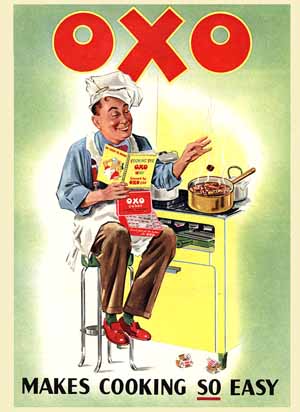 folk. Even more curious, I couldn't understand why their heavily-accented 'Ee-bah gum! Ecky-thump!' voices suddenly changed into a hoity-toity pitch when addressing such company - in those days, getting ideas above your station, or social climbing in any shape or form, was seriously frowned upon by women exchanging idle gossip over back garden walls.
folk. Even more curious, I couldn't understand why their heavily-accented 'Ee-bah gum! Ecky-thump!' voices suddenly changed into a hoity-toity pitch when addressing such company - in those days, getting ideas above your station, or social climbing in any shape or form, was seriously frowned upon by women exchanging idle gossip over back garden walls.Crazier still, everyone in the street seemed hell-bent on keeping up with the Jones's. Okay, you didn't see any fancy cars parked in the street (unless the Doctor called) yet there was plenty of evidence of houses boasting the fanciest white net curtains in front windows and the shiniest cardinal red doorsteps, though it wasn't a case of trying to outdo one's neighbours; it was more a question of ambition. In other words, working class people were simply trying to keep up appearances, which, in view of the harshness of those times, stands to reason, doesn't it?
After all, where would we be today without pretensions? If we didn't try to make the most of ourselves, then
 nobody would budge an inch from the manner into which they were born, and society would end up reverting back to Dickensian days of waifs and serfs donning their hats to the gentry.
nobody would budge an inch from the manner into which they were born, and society would end up reverting back to Dickensian days of waifs and serfs donning their hats to the gentry. Thankfully, this class neurosis began to wane in the 1960s; the country's social hierarchy may have subscribed to its stuck-up assumptions about the right order of things, but as more and more doors opened it became relatively easier for the less well-off to improve their lot.
And that's the difference with a modern society; there are equal opportunities for everyone.
And why am I saying all this?
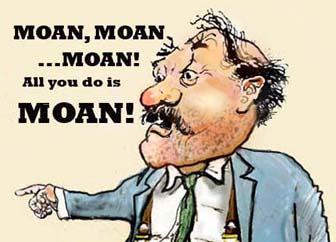 Well...in today's narcissistic 'me-me-me' world, there is so little to invent; our society has become riddled with a grubby culture of phone-hacking newspaper bosses snooping on 'B'-listed celebrities and unabashed fraudsters blatantly flipping homes (MPs claiming expenses on second properties) or having their grocery bills paid - not to mention the failure of whitewash inquiries into inflated bonuses paid to bankers or a suspected cover-up by police and the NHS...indeed all human life is here in droves. The collapse in moral standards is as corrupt as you can get and I do wonder who one can trust nowadays.
Well...in today's narcissistic 'me-me-me' world, there is so little to invent; our society has become riddled with a grubby culture of phone-hacking newspaper bosses snooping on 'B'-listed celebrities and unabashed fraudsters blatantly flipping homes (MPs claiming expenses on second properties) or having their grocery bills paid - not to mention the failure of whitewash inquiries into inflated bonuses paid to bankers or a suspected cover-up by police and the NHS...indeed all human life is here in droves. The collapse in moral standards is as corrupt as you can get and I do wonder who one can trust nowadays. This reminds me of a scallywag story about trusted cabinet colleagues of the former Prime Minister, Gordon Brown, who thought it would be a worthy gesture to name a railway engine after him.
The next day, a senior Whitehall 'Sir Humphrey' was sent to the NRM at York, where a consultant told him - 'Yes, we do have several locomotives here without names…mostly freight locomotives, though.'
'Oh dear, that's not very fitting for a former Prime Minister,' said Sir Humphrey - 'How about that big green one over there?'
'That already has a name' replied the consultant haughtily - 'It is called Flying Scotsman'
'Oh, couldn't it be renamed?'
'I suppose it might be considered,' he replied - 'The LNER did name a number of their bigger locomotives after company directors. They even named one Dwight D Eisenhower in honour of the USA President.'
'Excellent!' said Sir Humphrey - 'That settles it then...but how much will it cost? We can't spend too much, especially in view of the recent MPs' expenses scandal...'
The consultant mulled it over - 'In that case, we can just paint out the F!'
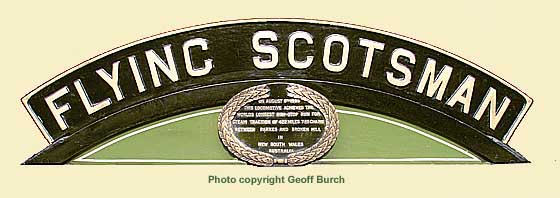
Okay, getting back to more serious matters again...the most discomfiting news I've heard in recent times is the scant regard that some people have for my ageing generation; indeed having reached pensionable age it would appear that countless thousands of 'baby-boomers' are now adjudged a major burden on the state.
Well, I'm sorry! I can cope with just about anything, but being labelled a liability by some faceless
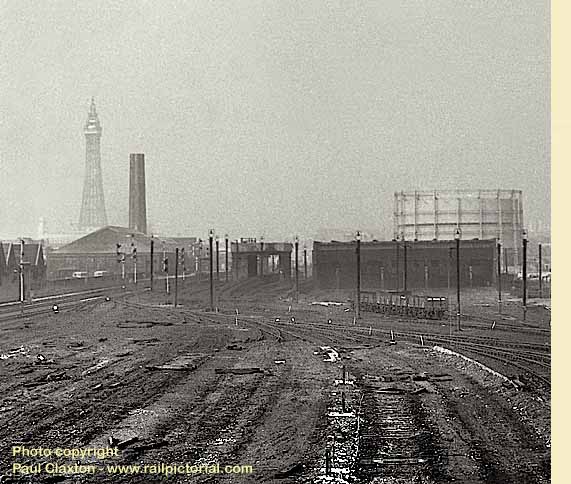 Whitehall bureaucrat is just too much. From the day I was old enough to vote and witnessed the devastating affects of the Beeching cuts, I've despaired at the way successive Governments have made a pig's ear of running the country.
Whitehall bureaucrat is just too much. From the day I was old enough to vote and witnessed the devastating affects of the Beeching cuts, I've despaired at the way successive Governments have made a pig's ear of running the country. I'm harking back to the Fifties and Sixties when it felt good to be British; when couples went steady and the worst thing you could catch from the opposite sex was chicken pox.
But the civilized manner our parents taught us to live our lives has all but been eroded today.
How can anyone expect to have pride in their national identity when the Government's misguided optimism for creating a multi-cultural utopia continues unabated.
Indeed, things have got so bad nowadays that my anaesthetized emotions can barely muster an ounce of sympathy for every sob story I hear. Does that sound a little harsh? Probably it is, but I have to think of my
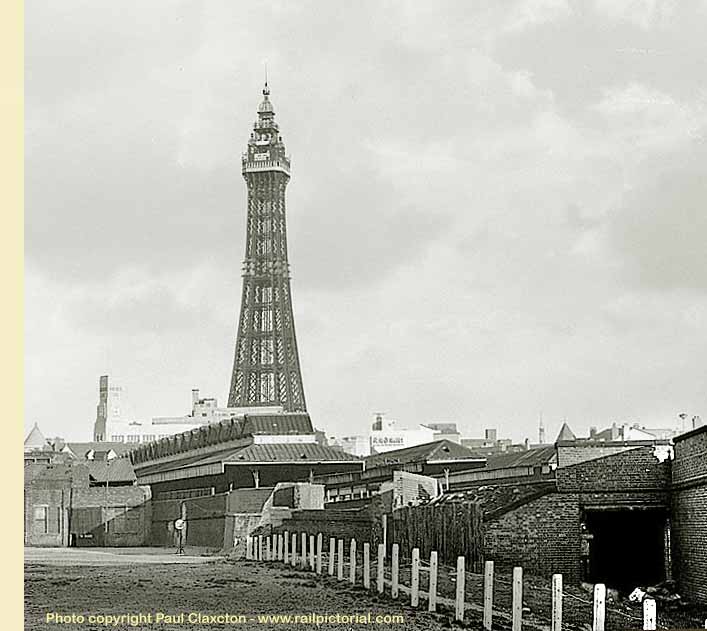 own generation's prospects of happiness in later life. Or perhaps I should say the few years we have left of it?
own generation's prospects of happiness in later life. Or perhaps I should say the few years we have left of it? You see, many of us are feeling very vulnerable right now...every day we hear stories about alleged mistreatment of old folk in hospitals and in nursing homes - and to be honest, it is scary.
Above all else, I fear for this country's future; it is already creaking at the joints...I just wish everyone who seeks sanctuary in this country could embrace its culture instead of bringing with them a sniffy indifference to its values.
After all, if everyone pulled together then we will be a much happier nation - just as long as we don't let go of our values, nor forget the three 'Rs' - respect for ourselves, respect for others and responsibility for our actions...and this includes everyone.
 (Insets) Having started this page at Blackpool, it seems only fitting to end with Paul's poignant photos showing the aftermath of Blackpool Central station's closure, once a bustling terminus on the direct route from Preston. The station consisted of fourteen platforms, including a number of excursion platforms to accommodate an influx of over 100 trains per day during the summer months. Click here see an aerial view of Central station taken in 1961. In the apex of the two sets of platforms was an ex-L&Y Barton Wright 0-4-4T used as a stationary boiler for carriage heating. The station closed on 2nd November 1964 and the site subsequently demolished to make way for a car park. The shed also closed in November 1964 and Paul's photo shows this once-busy depot empty and lifeless awaiting the wrecking crew in October 1965.
(Insets) Having started this page at Blackpool, it seems only fitting to end with Paul's poignant photos showing the aftermath of Blackpool Central station's closure, once a bustling terminus on the direct route from Preston. The station consisted of fourteen platforms, including a number of excursion platforms to accommodate an influx of over 100 trains per day during the summer months. Click here see an aerial view of Central station taken in 1961. In the apex of the two sets of platforms was an ex-L&Y Barton Wright 0-4-4T used as a stationary boiler for carriage heating. The station closed on 2nd November 1964 and the site subsequently demolished to make way for a car park. The shed also closed in November 1964 and Paul's photo shows this once-busy depot empty and lifeless awaiting the wrecking crew in October 1965. (Below) The day draws to an end over Blackpool as rebuilt 'Patriot' class No 45531 Sir Frederick Harrison 45531 - named after the General Manager of the London North Western Railway 1893-1908 - heads the 7.40pm to Earlstown at Blackpool South on 26th July 1963.
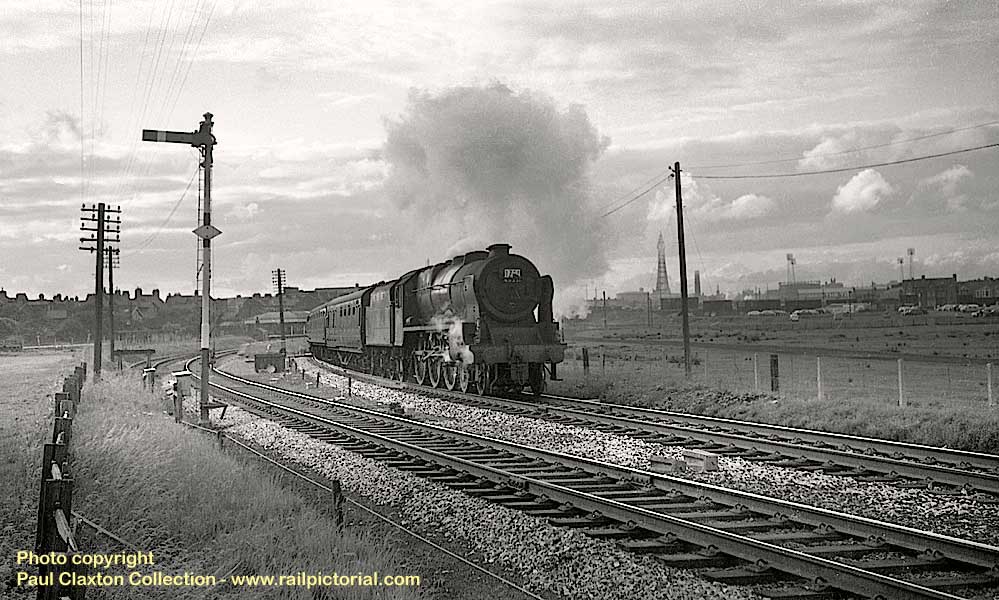
POLITE NOTICE
It is a fact of life that all images displayed on websites can be downloaded by one means or another, so with this in mind, Mike originally decided to make it easier for enthusiasts to download any of Paul's photographs by providing a download button on each page.
 Mike posted this message on his site - 'All images have a resolution of 300 dpi and therefore suitable for producing a respectable A4 print. However, should you download copies of any of the photographs then it would be appreciated if you would make a donation to the Trinity House Hospice, Blackpool who cared for Paul in his fight against cancer…'
Mike posted this message on his site - 'All images have a resolution of 300 dpi and therefore suitable for producing a respectable A4 print. However, should you download copies of any of the photographs then it would be appreciated if you would make a donation to the Trinity House Hospice, Blackpool who cared for Paul in his fight against cancer…'Mike even posted a link where direct payment by Paypal or Credit Card could be made...
So far so good! The largest downloadable images (300 dpi - dimensions 999 X 620…size 300KB approx) do indeed produce excellent A4-sized photographs, however the response to Mike's appeal for a voluntary donation - every penny raised makes a real difference - amounted to next to nothing!
Well, you don't need me to tell you how I feel about this!
Let me just say... Mike's generation understands the true meaning of integrity and putting ones trust in human nature is a natural instinct, but unfortunately a small number of enthusiasts - why do they spoil it for everyone else? - have been downloading thousands of images one after the other without making so much as a single donation.
Not surprisingly Mike decided enough was enough!
Therefore all 'clickable' access to the images have been removed...however Paul's superb collection can still be viewed via this link here and you can contact Mike with your requirements via email (details below).
Meanwhile, should you download copies of Paul's photos from this page then it would be really appreciated if you would make a donation to the Trinity House Hospice, Blackpool. A click-on link is
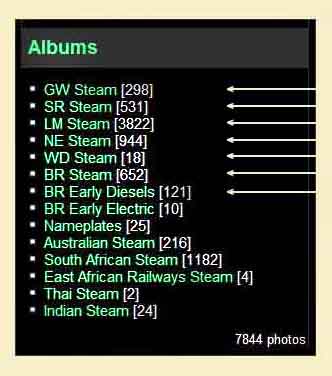 available here
available here It only takes a couple of minutes!
For the record, the photos on this page are from the following pages on Mike's site...
GW Steam
SR Steam
LM Steam
ER Steam
WD Steam
BR Steam
BR Diesels
There are other pages of course for Paul travelled the world in pursuit of steam.
On a final note, all the photographs reproduced on this page are low-res images, however Mike does have much larger 4800dpi scans of all photos. You can contact him with your requirements via the email address on this site, or better still click here for a link to Mike's home page and see for yourself.
A visit is highly recommended...
THE WORK IS PROVIDED UNDER THE TERMS OF THE CREATIVE COMMONS PUBLIC LICENSE - 'CCPL' OR 'LICENSE'. THE WORK IS PROTECTED BY COPYRIGHT AND/OR OTHER APPLICABLE LAW. ANY USE OF THE WORK OTHER THAN AS AUTHORIZED UNDER THIS LICENSE OR COPYRIGHT LAW IS PROHIBITED....
Polite notice: All text and photographs are protected by copyright and reproduction is prohibited without the prior consent of the © owners. If you wish to discuss the contents of this page the email addresses to contact are below. Please note - these are not 'clickable mail-to links via Outlook Express...you will have to email manually
mike@angliaweb.com
dheycollection@ntlworld.com





